Chris Wilson

10 Examples of artist bios: How to write a super artist bio
Examples of artist bios often include key elements like the artist's name, area of expertise, career milestones, personal interests, and contact info. They're tailored to engage the audience while reflecting the artist's unique voice and journey.
Ever find yourself staring at a blank screen, wondering how to condense your artistic journey into a few paragraphs?
Trust me, you're not alone.
An artist bio isn't just a list of facts; it's a narrative that invites people into your creative world.
So, why is it so crucial?
Well, it's your handshake with the audience, a way to say, “Hey, this is me, and this is my art.”
Stick around as we go into the how-tos and examples of artist bios that make a lasting impression.
- Define your artistic identity clearly : Your bio is your opportunity to introduce not just your art, but who you are as an artist. It should include your medium, inspiration, and artistic goals. This clarity helps in aligning your business plan with your art, ensuring your marketing strategies and portfolio resonate with your artistic vision.
- Use your unique voice : Inject your personality into your bio to make it stand out. Whether your tone is serious, whimsical, or quirky, ensure it reflects the uniqueness of your art. This authenticity makes your bio more engaging and memorable, inviting your audience into your creative world.
- Update regularly : As your artistic journey evolves, so should your bio. Regular updates reflecting new milestones, exhibitions, or shifts in your artistic focus keep your audience informed and engaged. This dynamic approach ensures your bio remains relevant and an accurate reflection of your current artistic identity.
Defining Yourself as an Artist in Your Bio Informs Your Business Plan
There is an interesting interplay between your artist bio and your business plan.
You see, your artist bio isn't just a narrative; it's a declaration of your artistic identity . It's where you lay out your style, your inspirations, your goals—essentially, it's where you define who you are as an artist.
And guess what?
When you're clear about your artistic identity in your bio, it becomes easier to map out a business plan that truly aligns with your art and your aspirations.
Your bio can help you identify your target audience, decide on the right marketing strategies, and even guide you in creating a portfolio that resonates with your artistic vision.
The Artist Bio vs. The Artist Statement: What's the Difference?
The artist bio and the artist statement—two essential pieces of writing, yet each serves a distinct purpose in the world of art.
Your artist bio is like the opening scene of a film; it sets the stage and introduces the characters. It's a narrative that tells the story of you—the artist. It covers your journey, your influences, your achievements, and even a bit of your personality. It's a comprehensive look at who you are, aimed at engaging the audience and making them want to know more about you and, by extension, your art.
Now, the artist statement, that's a different beast altogether.
Think of it as a spotlight that shines exclusively on a specific body of work. It's your chance to delve deep into your artistic process, the themes you explore, and the techniques you employ.
While your bio might say, “I'm a painter inspired by nature,” your artist statement would elaborate on how the colors of autumn leaves influence your palette, or how the texture of tree bark finds its way into your brush strokes. It's more focused, more immediate, and speaks directly to the art that's right in front of the viewer.
So, while your bio draws people into your world, your artist statement guides them through a specific landscape within that world.
Writing the Perfect Artist Bio
Your artistic title: what's your medium.
First things first, let's get clear on what you do.
Are you a painter, a digital artist, or maybe a sculptor?
Your title sets the stage, so make it clear and precise.
Your Home Base: Where's Your Creative Den?
Your location can say a lot about you and your art.
Whether you're soaking up the urban vibes of a bustling city or drawing inspiration from a tranquil countryside, let people know where you're coming from—literally.
Your Milestones: What's Your Artistic Journey?
Here's where you can brag a little. Got any exhibitions, awards, or significant projects under your belt? This is the time to shine a spotlight on them.
A Dash of You: What Makes You Tick?
Throw in some personal tidbits to make your bio relatable. Are you a coffee addict, a night owl, or maybe a hiking enthusiast? These little details can make you more memorable.
Stay Connected: How Can We Reach You?
Don't forget to include ways people can connect with you. Your website, social media handles, and other contact information should be easily accessible.
Tips for Improving Your Artist Bio
Crafting an artist bio is like painting a self-portrait with words. It's a small canvas, but it can make a big impact.
Here are some tips that'll help you brush up your bio and make it a masterpiece.
Understand the Audience
First off, know who you're talking to.
Are you aiming for gallery curators, potential clients, or a broader audience on social media?
Tailoring your tone and content based on your audience can make your bio resonate more effectively.
For instance, if your primary audience is other artists, you might want to delve into the nitty-gritty of your techniques.
Use Your Unique Voice
Your art is unique, and so are you.
Let your personality shine through your writing. Whether you're quirky, serious, or whimsical, your voice should be consistent with the art you create.
This adds a layer of authenticity and makes your bio more engaging.
Consider Length Requirements
How long should it be?
Well, it depends on where your bio will be published.
If it's for a gallery submission, they might have specific word limits.
On your own website, you have more freedom.
But remember, a bio is like a good sketch—detailed enough to be interesting, but not so much that it becomes a full-blown painting.
Additional Artist Bio Tips
- Avoid Jargon : Unless your audience is well-versed in art terminology, keep it simple. You want to invite people into your world, not alienate them.
- Be Honest, Be You : Authenticity shines brighter than any embellishment. Your bio should be a true reflection of who you are as an artist.
- Proofreading is Your Friend : Before publishing, make sure to proofread your bio. A typo can be a small thing that takes away from the overall picture. Maybe even get a second pair of eyes to look it over.
- Update, Update, Update : Your art evolves, and so should your bio. Every time there's a significant change in your artistic journey, take a moment to update your bio.
Examples of Artist Bios
Example 1: the landscape painter.
Sarah Green – Your Friendly Neighborhood Landscape Painter
I'm Sarah Green, and I'm carving my path as a landscape painter right here in the heart of Maplewood. I'm honing my skills at Maplewood Community College's Fine Arts program and have had the joy of showcasing my work at local art fairs.
My art is a love letter to Mother Nature, capturing her in her most tranquil moments.
When I'm not with my easel and paints, you'll find me trekking through local trails or lending a hand at our community animal shelter. Nature and critters aren't just my muse; they're my world.
Curious to see my work or just want to chat? Swing by my website or give me a follow on Instagram. Let's connect!
Example 2: The Fine Art Photographer
Tim Lee – Capturing the Urban Jungle Through My Lens
I'm Tim Lee, a budding fine art photographer rooted in the vibrant city of Chicago. I've taken some killer online courses and even had my work grace the walls of a local café.
My lens is drawn to the raw energy of city life—graffiti, faces, and all the little things that make our urban world tick.
When I'm not behind the camera, you'll catch me sipping on some artisanal coffee or cruising the streets on my skateboard. The city isn't just my canvas; it's my playground.
Want to reach out? You can find me and my work on my website or get a daily dose of my urban adventures on Twitter.
Example 3: The Abstract Painter
Emily Patel – Diving Into the Emotional Depths of Abstract Art
Hello, beautiful people! I'm Emily Patel, an up-and-coming abstract painter soaking up the sun in San Diego. I'm a self-taught artist, and I'm just beginning to dip my toes into the colorful world of abstract painting.
My art is a journey through emotions, guided by a symphony of colors and textures.
When I'm not lost in my art, I find peace in yoga and inspiration in poetry—both of which seep into my work.
Want to connect or explore my art? Feel free to visit my brand-new website or follow my artistic journey on Facebook.
Example 4: The Sculptor Finding Beauty in the Mundane
Mark Thompson – Sculpting Everyday Objects into Art
I'm Mark Thompson, a sculptor based in the artsy town of Asheville. I've studied at the Asheville School of Art and have been featured in several local exhibitions.
My sculptures turn everyday objects into something extraordinary, challenging how we view the world around us.
When I'm not sculpting, I'm usually found at flea markets hunting for my next inspiration or playing the guitar.
Interested in my work? Visit my website or follow me on Pinterest for my latest creations.
Example 5: The Digital Artist with a Social Message
Lisa Kim – Digital Art for Social Change
I'm Lisa Kim, a digital artist operating out of New York City. I've completed a digital art course from NYU and my art often appears in online social campaigns.
My digital canvases are platforms for social justice, aiming to provoke thought and inspire change.
Outside of art, I'm an avid reader and a volunteer at a local food bank.
Feel free to check out my portfolio online or connect with me on LinkedIn.
Example 6: The Watercolor Artist Inspired by Travel
Carlos Rivera – Painting the World One Brushstroke at a Time
I'm Carlos Rivera, a watercolor artist who finds inspiration from my travels. I've studied art in Spain and have exhibited my work in various European cities.
My art is a passport to different cultures, capturing the essence of places I've visited.
When I'm not painting, I'm planning my next adventure or cooking up some international cuisine.
You can find my work and travel stories on my blog or follow me on Instagram.
Example 7: The Mixed Media Artist
Angela White – Mixing Media, Mixing Messages
I'm Angela White, a mixed media artist based in San Francisco. I've taken workshops from renowned artists and have participated in group shows.
My art blends materials and messages, creating a unique narrative in each piece.
In my free time, I enjoy hiking and have a soft spot for vintage fashion.
To see my latest projects or to get in touch, visit my website or find me on Etsy.
Example 8: The Portrait Artist with a Twist
Jake O'Brien – Portraits That Tell a Story
Hey folks! I'm Jake O'Brien, a portrait artist from Boston. I've studied at the Boston School of Fine Arts and my work has been featured in several local galleries.
My portraits aren't just faces; they're stories waiting to be told.
When I'm not painting, I'm usually found at jazz clubs or writing short stories.
Curious about my work? Check out my portfolio on my website or follow me on Tumblr.
Example 9: The Environmental Artist
Fiona Chen – Art for Earth's Sake
I'm Fiona Chen, an environmental artist based in Vancouver. I've collaborated with environmental organizations and have had my installations displayed at eco-festivals.
My art is a call to action, aiming to raise awareness about environmental issues.
Outside of my art, I'm an active member of local environmental groups and a weekend gardener.
To learn more or to collaborate, visit my website or connect with me on LinkedIn.
Example 10: The Ceramic Artist
Raj Kaur – Crafting Stories in Clay
I'm Raj Kaur, a ceramic artist from London. I've trained under master potters and have my own studio where I teach pottery classes.
My ceramics are more than objects; they're vessels of stories and traditions.
When I'm not at the wheel, I enjoy cooking and exploring local art scenes.
Interested? You can find my pieces and upcoming classes on my website or follow me on Pinterest.
FAQs and Additional Tips for Your Artist Bio
Crafting an artist bio isn't just about listing facts; it's about telling a story, your story .
Here are some frequently asked questions and additional tips that can help you make your bio not just informative but also engaging and reflective of your unique artistic voice.
How Can You Infuse Your Unique Artistic Voice Into Your Bio?
Your bio should be as unique as your art.
Use descriptive language that reflects your artistic style. If your art is whimsical and colorful, let that show in your choice of words. If it's dark and moody, your bio can reflect that tone.
Your bio should feel like an extension of your art, offering a textual snapshot of what you bring to the canvas, the sculpture, or the lens.
What Aspects of Your Artistic Journey Are Most Compelling and Should Be Highlighted?
Think about the milestones and experiences that have shaped you as an artist.
Did a particular event or person inspire you to take up art?
Have you won awards or participated in exhibitions?
Maybe you've traveled to unique places for your art?
These are the stories that make you interesting and relatable. Include them to give a fuller picture of who you are.
How Can Your Bio Serve as a Tool for Audience Engagement and Even Advocacy for Causes You Care About?
Your bio isn't just a CV; it's a platform.
If you're passionate about certain causes, like environmental conservation or social justice, your bio is a space to advocate for these issues. Mention projects or artworks that reflect these causes.
It not only shows that you stand for something but also attracts like-minded individuals who may become supporters of both your art and your cause.
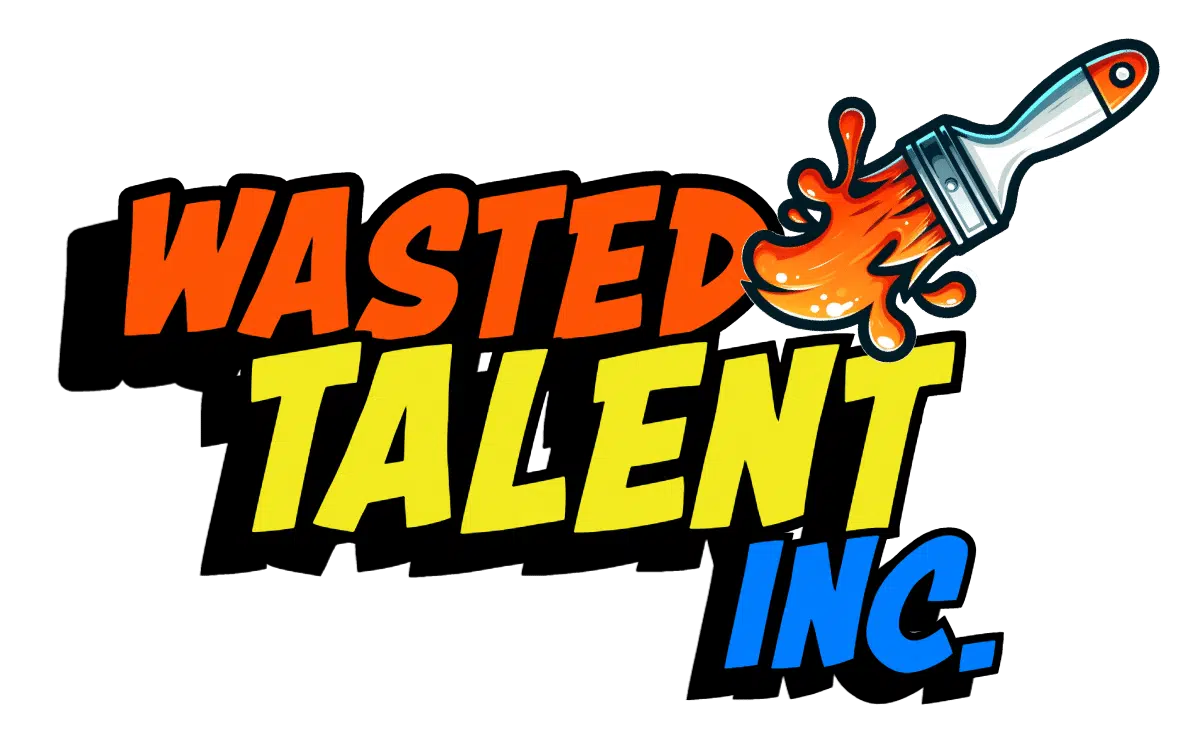
How To Write An Artist Bio With Tips and Lots of Examples
I have summarized the more important parts of this article below. Let’s have a look at some tips for an artist bio and below it some tips for an artist bio for an emerging artist.
For a Professional Artist Biography:
- Keep it Short : Your biography should be a brief overview of key facts about your art career.
- Easy to Read : Start with a catchy first sentence to get the reader interested.
- Write as an Observer : Use the third person to talk about your art and career.
- Important Facts Only : Mention things like your birth date, nationality, job title, the art forms you use, your style and main themes, and other key career details.
- Ideal Length : Aim for about 120 words, but keep it between 80 and 140 words.
For an Emerging Artist Biography:
- Background Info : Mention where you were born and places you’ve lived.
- Artistic Roots : Talk about what or who inspires your art.
- Education in Art : If you’ve had any art training or education, include it.
- Self-Taught Artists : If you haven’t had formal training, explain how you’ve learned and developed your art skills on your own.
Keep reading as I cover the topic in more detail, giving artist bio examples and the like.
Writing an Artist biography is probably one of the hardest things I have had to write. If you are reading this then I assume you are struggling with this as well.
Whether you are an artist making modern art , a painter or a visual artist looking for representation in an art gallery then you need to get your artist bio done right.
What’s the difference between an artist biography, artist statement, and artist profile?
Here are some bullet points to summarize each for those who do not know the key differences.
Below are some bullet points that highlight the key differences between an artist biography, artist statement, and artist profile. I will then dive into more details of each with examples you can use.:
Artist Biography:
- Focuses on the artist’s life and career, often including personal information and significant events or achievements.
- Written in third-person perspective.
- Typically includes a summary of the artist’s education, influences, and creative process, as well as critical reception and awards.
Artist Statement:
- Focuses on the artist’s creative process and artistic vision.
- Written in first-person perspective.
- Typically includes a description of the artist’s style, techniques, themes, and motivations, as well as any philosophical or conceptual ideas that inform the work.
Artist Profile:
- Similar to a bio, but typically shorter and more concise.
- Often used as a promotional tool on social media, artist directories, or other online platforms.
- May include a brief bio, statement, and selected images of the artist’s work.
- Generally less formal than a traditional bio or statement, and may be written in first or third person.
What is an artist biography (Artist bio)?
Before we start, you should understand the difference between an artist biography and an artist statement vs an artist profile.
Each one serves its own purpose and should be used for a specific goal in mind.
In its simplest form, an artist biography is a summary of you as an artist in a few paragraphs (some say 50 words is all you need). Artist bios should detail your qualifications and any training you undertook as an artist (if you are not qualified you can just omit this part). You then detail your influences, your achievements and contact details. It is usually followed by a brief artist statement.
What to include in an artist biography about yourself
An artist biography needs to take into account the life and work of you as an artist. It usually covers significant events and accomplishments throughout your artistic career, as well as personal information that helps to understand the context in which your art was created.
An artist biography can also include information about your artistic education, influences, creative process, and the evolution of their style over time. It may also discuss the critical reception of their work, as well as any awards or recognition they have received.
Get to the point quickly
An artist bio should get to the point quickly. This is because the reader of the bio may have limited time or attention span, and may be looking for a quick summary of your artistic career and style.
A concise and well-organized bio can help to capture the reader’s interest and convey the most important information about your work in a short amount of time.
This can be really important in situations where you are trying to promote yourself or your art, such as when applying for grants, exhibitions, or other opportunities.
In addition, a clear and focused bio can help to establish your credibility and professionalism as an artist. It shows that you have a clear sense of your artistic identity and are able to communicate it effectively to others.
Of course, this doesn’t mean that you should sacrifice depth or detail in your bio. It’s important to strike a balance between brevity and substance, providing enough information to give the reader a sense of who you are as an artist and what makes your work unique.
Speak in your own voice
One thing to note, many artists refer to themselves in the third person which I believe can come across as a little pretentious.
Another pretentious artist is the last thing the world needs.
Here are some tips for writing an artist bio in your own voice:
- Start by brainstorming a list of the key points you want to convey about yourself and your work.
- Write in the first person (“I” instead of “the artist”).
- Use a conversational tone and avoid jargon or overly technical language.
- Highlight your unique qualities, experiences, and perspective.
- Include personal anecdotes or stories that illustrate your artistic journey.
- Focus on what motivates and inspires you as an artist.
- Be concise and to the point, keeping the reader’s attention in mind.
- Don’t be afraid to show some personality and express yourself creatively in the bio.
- Read your bio aloud to make sure it flows well and sounds natural.
- Have someone else read your bio and provide feedback on clarity and tone.
Here are some things not to include in your artist bio:
- Personal information that is not relevant to your art, such as your marital status or political beliefs.
- Negative or overly critical comments about other artists or art forms.
- A list of every single exhibition or show you have ever participated in. Instead, focus on the most significant or noteworthy ones. This is a big one ok!
- Unsubstantiated claims or exaggerations about your accomplishments or abilities.
- Vague or clichéd language that doesn’t really say anything about your work or style.
- Rambling or overly long paragraphs that make it difficult for the reader to follow.
- Too much technical jargon or insider terminology that may not be easily understood by a general audience.
- Personal opinions that may be divisive or controversial, unless they are integral to your artistic vision or message.
- Information that may compromise your privacy or security, such as your home address or phone number.
Using your own voice makes you more relatable.
Click here if you wish to skip to the section on How to write an artist bio with steps and examples.
Can a non-artist write an artist bio for you?
Artist biographies can also be written by art historians, curators or other experts in the field. This is because artist bios can also be found in exhibition catalogs, art books , and online resources.
A great artist bio can provide valuable insights into your artistic life and work and can help to deepen our understanding and appreciation of your art, especially if art lovers find something in your back story that they can relate to.
What is an Artist Statement
An artist’s statement is a brief description of your work as a whole. The purpose of an artist statement is to give anyone looking at your work some context around why you work a certain way so that they can either connect with you or the subject matter. The artist statement should cover the “why” you do things and not the “who you are”.
You would usually include an artist statement as part of the artist biography.
For more information on Artist’s Statements, wikipedia has some further reading.
What is an Artist Profile
The Artist Profile is quite interesting, it is a mix of both the artist bio and artist statement. The difference is the artist profile packages both pieces of information into an interesting page designed to ‘hook’ the reader into wanting to learn more about you as the artist as well as your art and your interests.
Think of the artist profile as the first page of a really interesting novel, designed to make the reader want to keep reading and learn more.
Use good story-telling techniques when planning your artist profile.
If you are struggling to write an Artist Biography and Artist Statement, try writing an Artist Profile instead as it lets you channel your creative energy rather than following a boring format.
Here is an example of an Artist Bio with an Artist Statement
Here are some real examples of artist profiles (some famous artists some not)
Anselm Kiefer
Someone like Anselm who has a long and distinguished career, his artist bio can start to look like a long laundry list of accomplishments and doesn’t actually tell us anything new. My tip is to not follow this example (see below for an image or click on the link above to view his page)
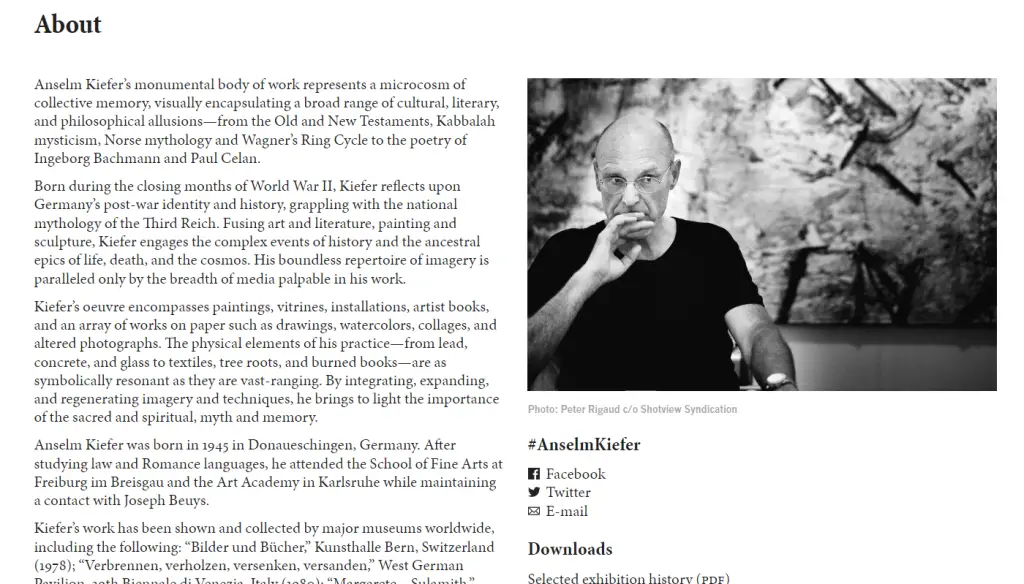
Do not write a laundry list of accomplishments and facts!
Rhian Malin (though it is written in the 3rd person..)
I quite like Rhian’s artist bio even though it is written in the 3rd person. But if you take a look at their artist biography you will notice that the first line makes her personable. She was inspired by her grandmother’s collection. We can all relate to seeing something at a grandparent’s home that would have awed us as children and then went on to influence us. Be personable.
Rhian then describes their approach and where they work. The list of accomplishments are not a laundry list and they appear at the bottom making you believe that accomplishments are a by product of inspiration and making art.
I quite like Rhian’s approach.

Larry Poons
Larry Poons also follows the more traditional approach to writing an artist biography. It is the typical laundry list of accomplishments and facts but what I do like is the photo. It is not a pretentious professional photo of the artist in a black turtleneck trying to look cool. The photo looks more natural.

Jeff Koons – As he has so many achievements, Jeff’s website also has formatted his bio into sections covering Awards and Honors , Talks and Lectures and Collections .
Another list of accomplishments and an unnaturally posed photo. Please do not go down this path of a boring artist bio, be original and be likeable. Make yourself relatable.
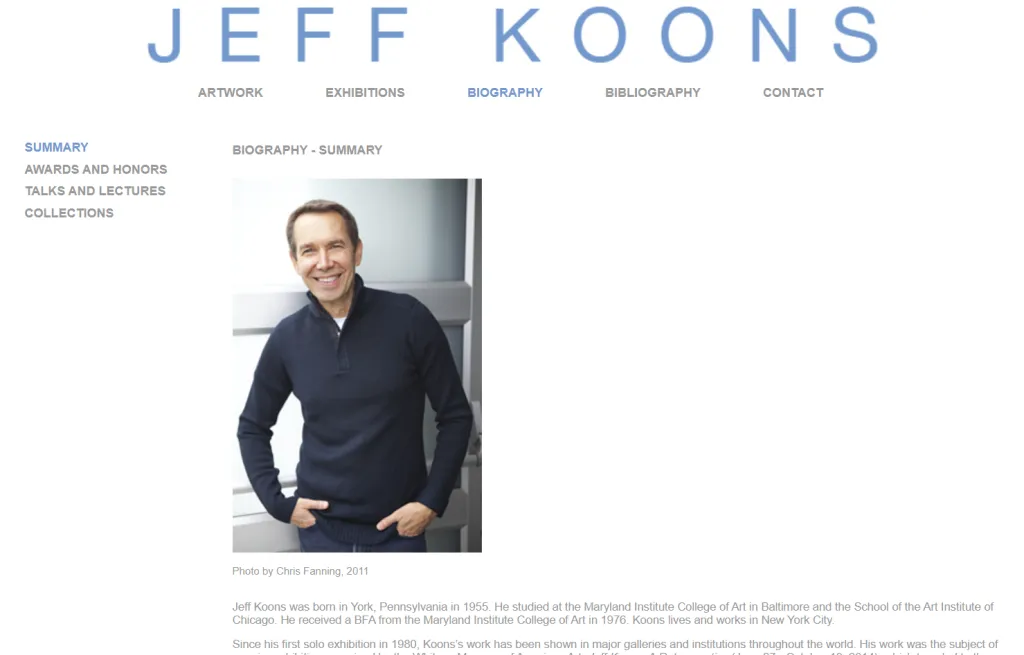
Be original, personable and likeable. Stay true to character and do not appear fake.
Why write an artist biography (bio). What is the purpose of an artist bio?

What is the purpose of writing an artist bio? Is it for vanity, was it requested by art galleries or was it just so that you could be found in search engines?
Most artists write an artist bio because other artists have written one. Pretty simple.
Personally I don’t have a formal artist bio written and the only time I pull one together is when I am entering an art competition and it is part of the entry form.
When we write our artist biography we need to ask ourselves “Who is it for?” You should write to your audience and not to yourself.
An artist bio Is like an informal Resume
Writing an artist bio is a bit like a resume. It can feel cold, impersonal and detached.
When we write a resume we are writing for a specific audience such as a recruiter but the goal is the same.
When we write an Artist Bio:
- We are writing to a curator or collector.
- We want them to know our skills
- We want them to know our qualifications
- We want them to know what we are good at
- We want them to know what makes us so much better than the next person that the reader will want to invest in us, our art
- and finally we want them to know WHY we became an artist and why we are pursuing the arts.
Give people your “why” when creating an artist bio
When you write an artist biography I have found it to be actually quite harder than a resume.
When we write a resume we tend to be able to be more objective about our skills, work and achievements but with art, we are emotionally invested and being an artist is core to our self identity.
Types of artist biographies
Artist biography for self taught artists.
Self taught artists may believe the lack of a formal qualification or training in the arts may preclude them from needing an artist biography.
I suffered from an inferiority complex for many years as I too am a self taught artist.
Self taught artists can usually do well with an artist profile instead of an artist bio as it can gloss over or skip over any need to highlight their qualifications.
So if you are a self taught artist, write your artist biography listing all your achievements, influences, showings, sales and include an artist statement.
Then when it comes to qualifications, highlight that you have been an artist for X amount of years, highlight your experience over any qualifications.
Experience can be better than education
Now I’ll get on my high horse.. Not being formally trained is not a hindrance. In fact, an art degree or tertiary qualification is actually only a recent thing for artists. Most artists until the 20th century were trained as artist apprentices or self taught. None had a piece of paper proclaiming that they were now part of the creative elite!
As we no longer have artists guilds to confirm our skills as an artist, then some use a degree or diploma as a proxy. Though this does not guarantee that you are as good an artist as any other.
Artist Biography for Qualified Artists
Many contemporary artists have some form of qualification they will include in their artist biography. If you have a certification in a specific field, or use of a specific tool then note that down.
Otherwise your artist biography and artist statement should read like any other.
Artist Biography for Beginner artist biography
When you are a beginner artist your experience will be little, you may not have even had a showing yet and you may not have any qualifications.
When I was 17 I entered the Doug Moran National Portrait prize (in Australia) which is a $100,000 Acquisitive portrait prize.
I had about 5 years of artist experience under my belt, 1 showing in my high school where I won first prize for a portrait of Marilyn Monroe and 2 sales of my paintings.
The prizes required I submit an artist bio and artist statement. I did not know what to do so I left it all blank.
Today I would give the same advice as I give to self taught artists, highlight your achievements to date and not add anything negative.
Remember my resume example. When we start working we have nothing to add as experience but we document all the transferable skills we have all that we can offer.
As a beginner artist, add what you have done to date and be proud of that. If you have not done anything of note yet, then note what your influences are and where you want to go with your art career.
What should an artist biography include?
What to include in an artist biography.
Images – Should I include an image of myself?
Just like in a resume, unless you are one extremely good looking person or you have a very original look that can help with your persona or help people remember you (think of Dali’s moustache) then do not include an image or photo of yourself.
Ensure you provide any links to where you have exhibited.
Ensure you provide any links to where you have sold your works. If you are unable to link to article showing a sale, then note down the item sold, when it was sold and the details of the artwork.
You do not need to note the price it sold for or who purchased the artwork.
Where possible, link to any articles about you or your works that are of note.
How to write an artist biography about yourself
The best way to write an artist biography is to start looking at the artist biography examples found on the internet.
The hardest thing I found was collating all the information I wanted to include in my bio. What I found was when I just did a brain dump without putting my thought into dates etc it was easier.
The first things you should do, using sticky notes:
- Collect and organise any courses you have completed. Don’t worry about the years commenced or completed.
- Write down keywords that you would use to describe your influences and put these aside. These can be art styles, people or places.
- Write down why you do what you do as an artist, was it something you have known since you can remember? Was it a specific experience?
- Write down any key achievements you have had so far in your art career.
- Your name and where you live and where you typically work from
- What styles or mediums do you work in?
Once you have these noted down, you actually have the key points required for an artist biography. All we need to do now is start writing the artist bio.

How do you start a biography?
Grab those sticky notes we just wrote. Put them in this order:
- Why you do what you do as an artist, that something you have known since you can remember or that specific experience.
- Those keywords that you used to describe your influences. The art styles, people or places.
- The styles or mediums do you work in
- The courses you have completed.
- The key achievements you have had so far in your art career.
Now that you have put all the raw data into some meaningful order, you just need to pad these out into properly worded paragraphs and ensure that they have a natural flow to them.
If you find that hard to do then take a look at some real artist biography examples to draw inspiration from. Find a few you like and experiment.
Artist Biography Examples
How to write an artist biography sample.
Here are some real examples of artist biographies to draw inspiration from. Note : One take away from all the examples I researched (apart from Rita Ackermann) is that they were all badly formatted and hard to read.
So please take some time to ensure that your artist biography is formatted so that it is easy to read on a computer and also on a smartphone.
EVELYN SOSA
Cuban, born 1989.
An Award winning photographer, Evelyn Sosa Rojas was born in 1989 in Havana, Cuba, where she still lives and work. In her practice, since 2008, Sosa specializes in amazingly soulful portraits. Sosa shows the power of femininity through photos of women in different familiar or intimate settings. In 2016, Sosa was the winner of the Herman Puig Prize, awarded yearly to the best artist of the Body Photography Salon in Havana. In her powerful series “Women’s portraits”, Sosa captures the very essence of each subject in a simple, sensual and compelling way. Sosa has an ability to capture the depth of the eyes and gaze, showing the subject soul and deep thoughts. In 2019, Uncommon Beauty published a photo-book , HAVANA INTIMATE, through the lens of Evelyn Sosa. In a scholarly essay written for the book, Grethel Morell Otero, the recipient of the 2019 Cuban National Curator Award, and a published authority in Cuban photography wrote: “her (Sosa) work represents something of a vanguard movement in contemporary artistic photography’. Website
Joseph Rolella
Born in Sydney in 1972, Rolella completed a Bachelor of Visual Arts (Honours) in 1994 and went on to obtain a Masters in Visual Arts at the University of Western Sydney in 1998. Joseph Rolella has exhibited consistently for the past twelve years both nationally and internationally. Rolella has won several major art prizes including the Australian Cricket Art Prize in 2011 for the painting “Cricket at Kandahar”. The Oakhill Grammer School Art Prize in 2013 as well as being selected as a semi-finalist for the prestigious Doug Moran Portrait Prize. Complex and contradictory, Rolella’s recent abstract paintings seek to expose a delicate equilibrium between a sense of balance and visual calm and the tumult of painterly texture and surface tension. The play of light at the waters edge…
SOFIA AREAL (Lisbon, 1960)
Begins her studies 1979 at the Hertfordshire College of Art and Design in St Albans, UK. In Portugal she studied etching and painting at Ar.Co. (Art and Visual Communication Center).
Her first group exhibition was in 1982 at the 1ª Mostra de Artes in Lagos, Portugal and her first solo show was in 1990 at Galeria Alda Cortez, Lisbon. Since then, Sofia has exhibited in various countries individually and collectively. She had a retrospective exhibition covering the last 10 years of her career in 2011 at the Galeria da Cordoaria Nacional the exhibition was accompanied by a book published by Babel, with texts of among others: Jorge Silva Melo and Professor Luís Campos e Cunha. In 2012 Areal illustrates the literary magazine published by Calouste Gulbenkian Foundation, Colóquio Letras. In 2013 launches a book together with Harvard Professor, Allan Hobson – “ Creativity”. Since 2013, Areal has started an international exhibition program, in Macau – Orient Foundation 2014, Oslo – Embassy Art Space 2015 and Dublin in 2016. In the same year a film by Jorge Silva Melo, “Sofia Areal: Um Gabinete Anti-Dor” premiers. In 2017 Areal continues a series of exhibitions, started in 2016 in quARTel das Artes in Abrantes, about her own private collection in Lagos Cultural Centre, followed by MUDAS. Contemporary Art Museum of Madeira and Centro Cultural Raiano – a series, which will continue in 2019. In the same year Areal will have an exhibition in the Portuguese Cultural Centre in Luxembourg. In 2017-2018 creates a tiles panel is together with a group of artists and 3 individual ones, all with Ratton Gallery in Lisbon.
Great example of a short artist biography
A short bio is a good idea for any artist whether you want to present your skills for a solo exhibition for fine art or just for a social media platform such as for an Instagram profile.
Rita Ackermann Biography
Born : Budapest, Hungary, 1968
Education :
The New York Studio School of Painting, Drawing and Sculpture (Hanes Foundation), New York NY, 1992 – 1993 Academy of Fine Arts, Budapest, Hungary, 1989 – 1992
Resides: Lives and works in New York NY
SOLO EXHIBITIONS
2019 Hauser & Wirth, ‘Rita Ackermann. Brother and Sister’, Zürich, Switzerland
2018 La Triennale di Milano, ‘Rita Ackermann. Movements as Monuments’, Milan, Italy VIEWING ROOM, Marlborough Contemporary, ‘Rita Ackermann and Carol Rama: Body Matters’, New York NY
How to write an artist biography using a template
You can follow this simple template if you want to skip the sticky note exercise from the previous steps.
As I do not like referring to myself in the third person I will move away from your typical artist biography examples and make it a little more personable.
“ My name is [Insert your name], I was born in [insert town/city/country] in [year]. My first experiences as an artist was when [insert time period in life or formative experience].
My influences were [insert influences].
It was here that I realized that I wanted to pursue my career in this field.
I went on to study [insert course and institution] where I earned my qualifications in [insert field of study].
It was here that I furthered expanded on my knowledge in [insert fields of interest], where I [insert key achievements].
I work primarily in [insert mediums] and I currently work from [insert location] and [any other locations of interest]. “
Self taught artist bio sample
For self taught artists, your artist bio will be the same as all the examples but without listing any formal qualifications. Using the template above, I have modified it to make it suitable for self taught artists.
The focus for a self taught artist is to focus on your practical experience and what you did in lieu of formal training.
I believe that being an artist is something that one is born to do an not learned at school, I went on to study through practical experience, learning through trial and error and self learning studying the works of [insert influences] as my teachers .
50 word artist bio example
Describe yourself in 50 words or less. This is much harder to do than you may think.
If you must provide an artist biography in 50 words or less then focus on the key information and remove the filler words that we tend to use when describing ourselves and our achievements.
When creating a 50 words or less artist bio, use simple headings and bullet points and stick to the point.
“ My name is [Insert your name]. Born in [insert town/city/country] in [year].
I work primarily in [insert main medium]
My influences are [insert influences].
I obtained a [insert qualification] from [institution].
(I am represented by [insert gallery]) or (I have exhibited in [insert shows]) or (I have won [insert main prizes])
I currently work from [insert location] and [any other locations of interest]. “
Still struggling to write an Artist Bio?
I found this cool site, it generates artist statements and biographies. All you need to do is click “Generate Some Bollocks” .
First Draft of an artist biography
Have someone write the outline for you.
If you find it hard to write about yourself, find someone you trust and hand over your sticky notes and ask them to write the artist biography for you using the templates as a guide.
You will find that someone who knows you well will remember to add other information about you that you may have forgotten to include or too embarrassed to include.
Once they have a draft, read through it out loud with them and see if it makes sense and look at areas for improvement.
My English is not good, what do I do?
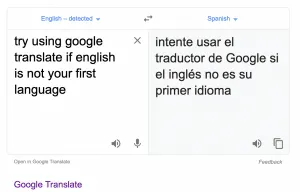
If your english is not as good as you like, that is totally fine. If anything it is an advantage as you can now have a bilingual artist bio.
You can have your artist bio written in your native language for your native audience and then ask someone you trust to translate it to English or pay a small fee on Upwork or Freelancer to translate your artist biography for you.
If you do not want to pay someone, you can give Google Translate a try and see how that comes up. Speaking from experience when I tried to translate text from English to Italian, be careful as this does not always give the best results.
Review and review again
Again, with anything your write you should review it yourself and then ask someone you trust to review it again for you.
Check for grammar and spelling.
Common mistakes in artist biographies
Contrary to my advice about writing in the first person, some say that your artist biography should be written in the third person to give the impression that it was written by someone else and that it sounds more authoritative.
Unless your artist biography was actually written by a third person I disagree with this advice. We know you wrote this so why pretend it wasn’t.
Secondly, if you are an unknown and not professionally represented, most people in the industry will know you bring little authority with you. That’s the sad truth.
The next mistake is to fail to tell an interesting story about your journey as an artist. Note down any gaps in your career and explain why, sometimes the gaps are as interesting as the art journey itself.
Taking care of children, sick family, going to war, being in accident can all be used as part of your narrative and drawn on for inspiration.
Think of all the books you read that you could not put down, they told an interesting story you could relate to and the characters were usually likeable and not pretentious.
Which leads to the next mistake, do not big note yourself or embellish your achievements. Do not lie about your achievements. With the internet available to most people on their phones, most facts can be easily verified.
The next mistake is to write an artist statement when an artist biography was requested.
Other mistakes when writing an artist bio are spelling mistakes grammar mistakes, not proofreading your draft, and the final mistake artists make when writing their artist biography is forgetting to tell the why they became an artist.
How to write an Artist Bio – Wrap up!
As I mentioned earlier, writing an artist bio is a bit like a resume but it’s all part of the art business. It can feel cold, impersonal and detached. This is the reason why I prefer an Artist Profile instead.
I would format the artist profile to include the initial hook paragraphs to get your readers interested in knowing more.
I would then follow the lead from the examples provided and include information that you would usually see in an artist biography.
Keep it up to date
Remember, as artists we are always changing and progressing. This means whether you are using an Artist Biography, Artists Statement or Artist Profile, these should be updated to reflect where you are in life and as an artist at that point in time.
It should change as you change. Keep some of the older information in there so your reader can follow your career and influences progressions.
These tell a story about you and remember there is no such thing as a perfect artist bio or artists cv. You just want to convey enough about yourself for potential clients and for a fellow artist.
Rewrite and Review
Each time you make an update, review what you wrote and do not be afraid to re-write it all if it no longer applies to who you are today.
Get someone to proofread your artist bio and take on any constructive criticism.
Good luck! If you have any of your own artist biographies that you would like linked to this article, please send through a message on the contact-me page.
If it is suitable, I will include it in the list of Artist Biography Examples.

Joseph Colella (Joe Colella) is an Editor and Writer at WastedTalentInc. As a frustrated artist with over 40 years experience making art (who moonlights as a certified Business Analyst with over 20 years of experience in tech).
While Joseph holds a Diploma in Information Technology, in true wasted talent fashion he spent years applying for various Art degrees; from the Accademia di Belle Arti (Napoli), to failing to get into the Bachelor of Arts (Fine Arts) at the University of Western Sydney.
While he jokes about his failures at gaining formal art qualifications, as a self-taught artist he has had a fruitful career in business, technology and the arts making Art his full time source of income from the age of 18 until 25.
His goal is to attend the Julian Ashton School of Art at The Rocks Sydney when he retires from full time work. Joseph’s art has been sold to private collectors all over the world from the USA, Europe and Australasia.
He is a trusted source for reliable art advice and tutorials to copyright/fair use advice and is committed to helping his readers make informed decisions about making them a better artist.
Leave a Reply
Your email address will not be published. Required fields are marked *
{{widget.title}}
{{widget.description}}
{{attribute.label}}

How to Write an Artist Biography? (BONUS: Artist Biography Examples)
- Last Updated: March 7, 2024

Art Ignition is supported by its audience. When you buy through links on our site, we may earn an affiliate commission. Learn More.
Are you going blank at the thought of writing an artist bio?
It’s okay! Artist bios are actually not all that complicated to write, there’s not much for you to learn about before you can start doing it.
As for what you do need to know, continue reading below to see some artist biography examples and find out:
What Is an Artist Bio?
1. point of view, 2. keep artist bios short and concise, 3. focus on answering the key questions, step 1. state your name and background, step 2. introduce your artist journey, step 3. talk about your art style, step 4. discuss your personal influences and inspiration, step 5. list your artistic achievements, 1. professional presentation, 2. gallery or exhibition submission, 3. personal or business website, final thoughts:.
Artist bios are short pieces of writing that include the details of an artist’s life and work. It’s written to serve as the connecting bridge between the artist and the rest of the world.
You can put it on your website, social media, art portfolio, resume, etc. so that your audience and other interested parties can get to know you and your art without having to do deep research themselves.
Things You Should Know Before Writing an Artist Bio
Before we move on to the tutorial, let’s talk about some general rules for drafting a good bio agreed upon by most artists:

The point of view most accepted by most people is third-person POV. Third-person POV is best because it looks more formal and is more easily acceptable for others to read.
To say it bluntly, most people think that writing distantly like this makes it sound like others are talking about you. Rather than you bragging or selling yourself directly.
Of course, not everyone writes their artist bios so distantly. There are some artists who still prefer the more intimate first-person POV for their artist bios. Primarily because it always sounds like you’re talking to your audience directly in this way. So it seems more personal.
Although there is no strict rule when it comes to exactly how long an artist bio should be, it’s always best to keep it short and concise — lest visitors lose interest as soon as they see it.
The general rule of thumb for creating the perfect artist bio is to keep it to a single paragraph — two at most! The paragraph can be a bit longer if need be but try not to make it so long that it takes up the whole page.
Note! It makes sense for artist bios to be long on some occasions. But if you take a look at the artist bio in the image below, you can see how easy it is to lose your focus when you see a page with such a large word count. Readers call long bios that take up a whole page like this ‘wall labels’ because there are so many words that it becomes visually distracting.

If you want to write a long artist bio like this, it’s best to preface it with a short and concise sentence or paragraph, like the one shown on Timothy Goodman’s website.
Put it in bold and make the font bigger so that it can stand out! That way, you can grab the reader’s attention at the first line and allow them to sink their teeth in first.

As a plus, this practice of keeping artist bios short is helpful for search engine optimization. At least, it makes it more likely for your art website to show up above other artists on search engines.
Finally, the most important thing about writing the perfect artist bio is to give the reader the information that they want. For exact details, you can take a look at the tutorial written in the next section.
The key thing is to remember that the purpose of creating an artist bio is to introduce yourself and your value as an artist. So, try not to get too side-tracked.

To give you some reference, have a look at Alexander Calder’s artist bio. Alexander Calder is an American sculptor best known for creating the first mobile art in history.
Most people who go to his website are looking for information about this detail. As such, his accomplishments in this area are the focus of his bio. Not only does it mention the fact that his father was also a sculptor, but also that he had created his first sculptures when he was a child.
It even talked about a specific sculpture that he had worked on and emphasized his talent in that area. And it does all of this without overstating anything, which only makes the audience reading the summary more interested in his professional work and style.
How to Write an Artist Bio?
Alright, now that we’ve finished getting to know some of the more important rules, let’s start drafting artist bios ASAP! For this, we’ve prepared an in-depth tutorial:
To start writing a bio, your first sentence should include your name and your background.
As can be seen in the artist bio example below, Sophie Kahn introduced her name in the first sentence and then talked about her modern art career and background — she was born in Melbourn, Australia and now lives in Brooklyn, New York.

This part usually only takes up one sentence. The artist bio example above takes up two sentences, which is okay, but it’s still preferable to state this as briefly as possible — like in Samantha Keely Smith’s bio below.

After stating your name and background, you can spare a sentence or two to talk about your artist journey.
How did you get your start? Are you like Michelle Carlos, who slowly developed a love for art after doodling on the walls of her home? What about after? Did you also go to professional art school with your fellow artists to further your career?

These are things that are easy for your audience to relate to. Which makes it the perfect conversation starter. Much better than tossing out academic jargon right off the bat, at least.
What makes you unique as an artist? Or rather, what makes you as an artist important? The purpose of talking about your style in artist bios is to answer these questions.
It allows other artists and art enthusiasts to get to know the real you and maybe get in touch with your artist’s practice.

Next, you can talk about your influences and the source of your inspiration. Influences involve idols that act as spiritual support. Maybe you were influenced by other artist’s practices. Or maybe you’re particularly fond of a certain style used by an artist in history.
You can mention this briefly to let others know what influenced you to create your art.
As for inspiration, you can give some examples like Ashley in the artist bio example below. It’s worth noting things like this in your biography so that other artists can understand where the source of your creativity comes from as an artist.

Next up, it’s finally time to talk about your achievements. These don’t have to be particularly fancy or formal. Try to draft a description of your achievements in simple language. Whether it’s about awards won, exhibitions opened, illustrations sold, etc.

Note, even if you have many achievements to talk about, it’s best to focus on one or two in your bio. You can talk about the rest in a separate artist statement.
For example, for artists who focus on architecture , having their art exhibited at the Venice Biennale is one of their biggest achievements. Making it worth noting over other awards they may have received during their career.
If you really don’t want to limit the information shared, there are many examples of artists who create separate artist statements along with their shorter artist bio so that interested parties can get a more comprehensive view of their work experience and views. Just like the example artist statement shown below, which focuses on the artist’s practice and style:

3 Unique Artist Biography Examples for Different Purposes
Although we’ve taught you how to write a bio, these are just basic standard rules. You have to be open to making some changes based on the requirements of the bio that needs to be written. To illustrate this, have a look at the following list of examples:

The first type of bio that we’ll be talking about is the ‘professional’ type. This is used by artists who want to create an art portfolio where fellow artists and other interested parties can view their art. For this reason, the structure of the bio is often very formal and neat.
Just like the artist bio example above. It has all the key points but focuses more on her works and uses formal language.

If your purpose for writing an introduction is to submit your art to galleries and exhibitions, then the focus should be on successful exhibitions and the style of your work. That way, the reader can quickly verify whether you match the requirements of their show.

Most of the ‘bios’ we’ve shown thus far have been taken from the websites of artists. Different websites have different purposes. Just like Livia’s art business shop shown above.
The ‘About Me’ section is very clean and formal. Whereas Jon’s bio below, written for a personal site, is written in first-person POV — making it more engaging and personal.

Now that you’ve learned the basic rules for writing a good bio, it’s time to start working! Best if you could get it up on your site ASAP.
(BTW! If you haven’t started looking for website builders yet, you can check out the Wix website builder or read this article for other relevant recommendations.)
Related posts:
- 74 Easy Drawing Ideas For Beginners To Fuel Your Creative Fire
- 75 Cool Sci Fi Spaceship Concept Art & Designs
- How to Make an Art Portfolio That Stands Out In 5 Easy Steps
- 64 Badass Cyberpunk Girl Concept Art & Female Character Designs
- 42 Best Gifts for Artists, Painters & Art Lovers in 2024
Like our Content? Share It With Other Artists
Article Written By
Let's Be Friends
Affiliate Disclaimer
Art Ignition is reader-supported. When you buy through links on our site, we may earn an affiliate commission. As an Amazon Associate we earn from qualifying purchases.

Copyright © 2024 by Art Ignition

How to write an artist bio with examples
- Best Practices
Whether you’re a visual artist, writer, or musician, a quick and compelling summary of your career is essential for introducing the world to your work. You’ll need a short bio that sums up your career for grant applications, posts about gallery openings, the back cover of your novel, and, of course, your website.
As a creative person, no project seems cut-and-dry, not even writing a bio. You’re probably already thinking about the unique spin you’ll put on it. But before stressing yourself out writing a bio that’s got as much flourish as your novel, know there’s an industry standard.
We’ll explain how to stick to the script and provide some artist bio examples to point you in the right direction. When the editor featuring your work in their ‘zine writes asks for a bio to accompany the publication, you’ll be glad you got this task out of the way.
What is an artist biography?
If your portfolio or CV is the long-form summary of your career, an artist bio is the elevator pitch.
This blurb shouldn’t be more than a few lines, short enough that someone introducing you at a conference could read it quickly. Brevity will also make it easy to fit your bio on applications or in a magazine’s “about the authors” section.
The perfect artist bio should:
- Include your name in the first sentence
- Be written in the third person
- Include career highlights (awards, publications, degrees, etc.)
- Describe any relevant facts about your career (such as boards you sit on or organizations you’ve founded)
- Include the link to your website
Keep in mind that a bio is different from an artist statement, which is generally longer, written in the first person and explains why you create the work you do.
3 short artist bio examples to use as inspiration
We said there’s an industry standard for artist bios, and we’ll demonstrate what we mean with the following examples. Even though these three mockups describe very different career paths, you’ll find that each artist’s bio follows a similar format:
- Kate Lee is the author of three poetry chapbooks and a short-story collection. Her work has appeared in The New Yorker and The Atlantic , and one of her poems was nominated for a Pushcart Prize. She’s the recipient of two grants and a writer’s residency. You can learn more about her work at the following link: [Kate’s Linktree URL ].
- Alejandro Ruiz is a self-taught photographer and collagist based in New York City. They have had three solo shows in the last year, the most recent of which received a write-up from Art Forum. Alejandro is the founder of a non-profit organization that runs free art workshops for children, and they sit on the selection committee for a prestigious art award. Learn more at [Alejandro’s Linktree URL ].
- Fran Wright writes and directs short films. She graduated from Stanford University with a BA in Film Studies and has gone on to produce 15 short films, the most recent of which was showcased at the Sundance Film Festival. She is currently working on a feature-length documentary about climate change. Follow Fran’s career at [Fran’s Linktree URL ].

Why an artist’s “about me” is so important
After reading the examples above, you’ll see that writing an artist bio shouldn’t be too intimidating. The most challenging part is narrowing down your accomplishments to just a few. Although you may be able to write a bio in just a few minutes, take your time to get it right. The value of this blurb will pay out for years to come. Here’s how:
- Your bio gives you credibility: When you list your accolades, degrees, and publications, the reader gets a better idea of the seriousness of your career. In a bio, name-dropping isn’t just recommended – it’s encouraged.
- You become searchable: Not only can readers learn more about your work at the link you provide in your bio, but they can also look up the awards, publications, shows, etc., that you list. If the galleries and magazines you’ve been featured in host your pieces online, the reader can get an even broader view of your work. When your bio starts circulating online, you also become more organically visible. Search engines will pick up on keywords like “New York” and “muralist” in the text, and your site will be included in the search results for these terms, making it easy for a new fan or patron to stumble upon your page.
- You get to tell your story: While having a bio template you can use on every application and publication is smart, remember that you can also tweak this text for different opportunities. Perhaps you want to highlight your work in translation for a bilingual writing contest or the time you spent as a critic for a position at a fine art gallery.
Creating your online identity
So you’ve gathered the energy to tick writing your bio off your to-do list, and now you’re on a roll. Don’t stop there. Here’s how to create an entire online identity that supports your career :
- Make a website: Whether you’re a painter, writer, or underwater basket weaver, you should have a professional website. Hosting your CV, portfolio, press, and publications in one place makes it easy for people to explore ( and even buy ) your work, review images and texts, and contact you.
- Get on social media: Shamelessly post about your career. Your gallery or press might do some of the work for you, but artists often have to advocate for themselves and their colleagues. Create an artist’s Instagram profile , Facebook page, and Twitter account to show followers what you’re working on. Give them a peek into your process, and be sure to announce upcoming events and publications. Write an even shorter description of your career for your social media bios , and remember to include a link to your website. If you want to include multiple URLs, get a Linktree , which can branch out to several locations on social media and the web.
- Go live: Use Facebook Live, Twitch, and other streaming platforms to host live content such as readings, gallery openings, or film premieres. Not all your fans can attend every event, but live streaming can make your supporters feel closer to your work. And don’t just stream in-person events – create virtual ones too. Online readings or studio tours help to build community and generate hype around your work.
You might also like these
Jumpstart your corner of the internet today.

Limited Time Offer! Save up to 50% Off annual plans.* View Plans
Save up to 50% Now .* View Plans
Artist Bios 101: Here’s How To Write An Amazing Artist Profile
Wondering what makes an unforgettable artist bio? Follow our how-to guide to learning everything about writing an artist bio that will make people remember you! (160 characters)
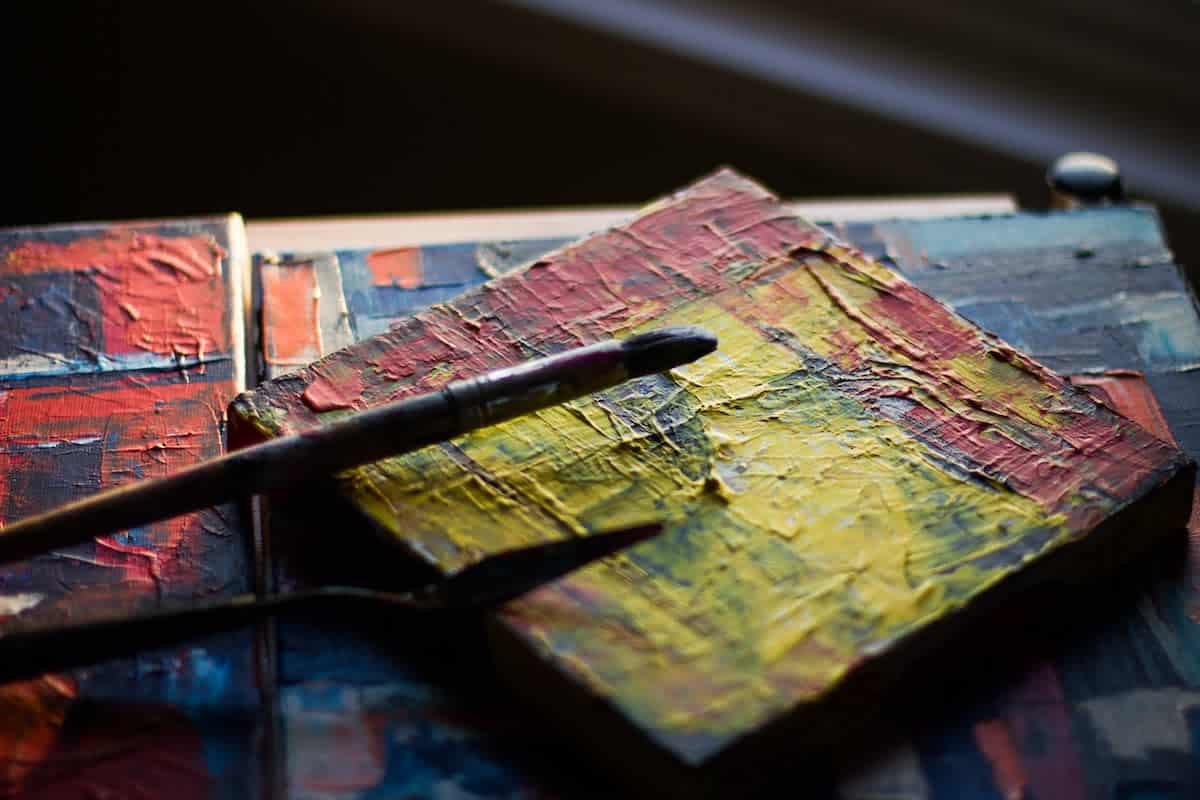
Your artist bio is your chance to really grab the interest of potential clients and make them understand what it is about your art that’s different from the rest. It can be a powerful art marketing tool, so you want to make sure you take the time to craft an amazing artist profile that does your incredible artwork justice!
When building online portfolios, many artists (and even brands) overlook the importance of the about-me page . But, no matter what kind of art you make, visitors to your website are highly likely to click it within a little while of landing on your page. Think of your artist bio as your chance to craft the lens that they’ll view your work through.
Don’t have an artist portfolio website just yet? Your About the Artist page will live on your online portfolio, of course, so it’s a good idea to have one up and running before you start crafting that artist profile. Make sure to choose a website builder that lets you easily add custom pages, so that you can add an artist bio page and place it wherever you want in your website’s menu (Hint: you should put it somewhere that’s easy to find, so your visitors don’t have to look for it).
Choose an online portfolio with beautiful website templates that allow you to make easy, fast tweaks to your artist profile whenever you want—no code required! The best website builders will have lots of typography options built right in, so that you can really customize the look of that About the Artist page without having to mess around with importing fonts.
Okay, you have some ideas for how to build your artist bio into your portfolio website, but what makes a really strong artist profile in the first place? What should you include, and what is better left out? Where do you start?
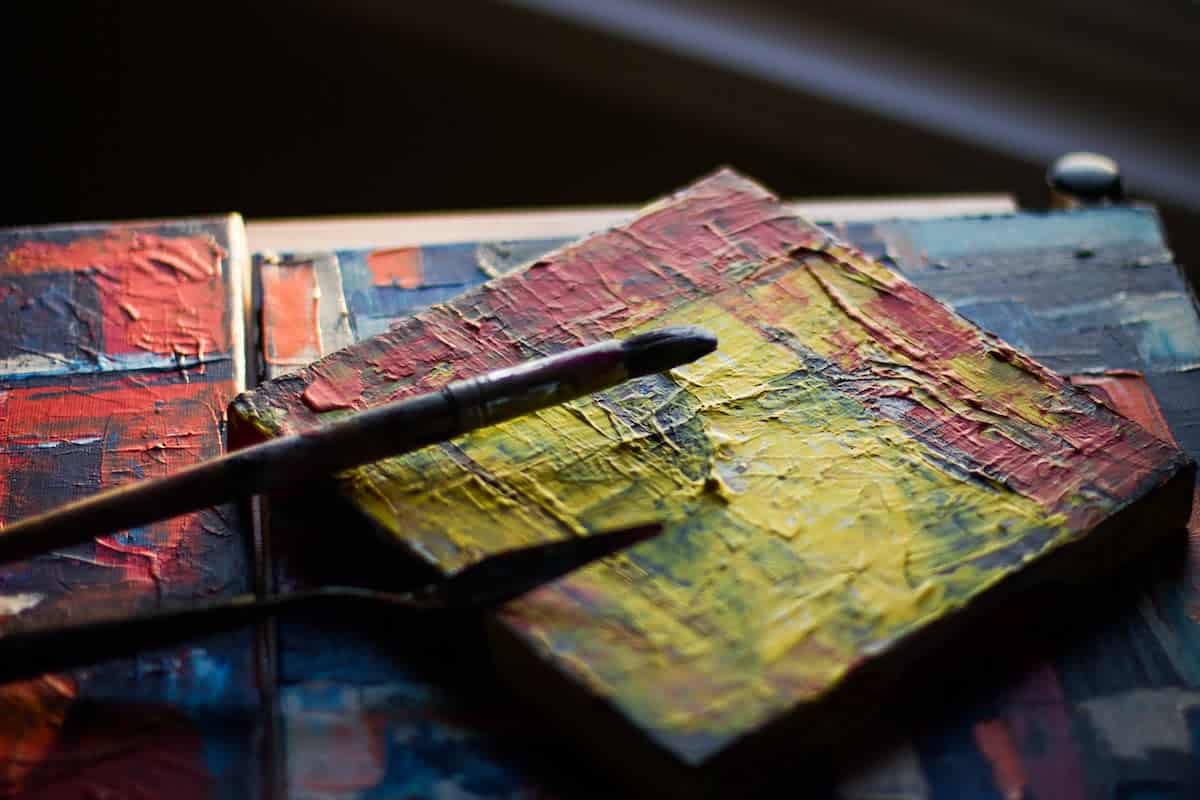
Craft the Perfect Opening Sentence
A short artist bio is usually better than a lengthy one. Check out some short artist bio examples and some longer ones, and notice which tend to stick in your mind more. (Not sure where to find them? Check out the online portfolios of other artists you respect to find some good artist bio examples.) Attention spans are limited online, so if you want to get your point across and make sure your reader goes through your whole artist profile, it’s best to keep things concise. That means every sentence matters.
The opening sentence is important because that’s where the reader gets hooked. This sentence should be able to stand alone, communicating who you are and something unique about the kind of art you make. Check out some successful artist bio samples online; a tried-and-true method is to use the first sentence to state the artist’s name as well as their preferred medium or the style of their art.
Remember, your artist profile is also a chance to improve the SEO ranking of your portfolio website. Consider the kinds of keywords that people who might buy your art would search for. Are you an oil painter ? Then you should use that keyword early in your artist bio, since search engines will rank that higher than if you mention it at the very end of your artist bio.
The same goes for subject matter: if you usually photograph landscapes in a certain region, you should make sure that first sentence includes something like “Pacific Northwest landscape photographer,” which will let your reader know what it is that you do—but will also be SEO-friendly. If you’re confused about where to start with search engine optimization, no worries. Our guide will answer a ton of your questions and help you make your portfolio website super SEO-friendly.
Know Your Audience
Another thing you’ll see across the best artist profile samples is that they’re speaking to a well-defined audience. Think about who you hope will see your website, and who you’re hoping will take the next step and want to work with you or buy your art.
If you’re selling your work directly to consumers on your portfolio website, consider writing an artist bio that the average person who doesn’t have a background in art would be able to understand. You definitely don’t want to alienate people with too much art industry jargon in that artist profile! It’ll fly over their heads and, worst of all, it will make them feel less comfortable buying from you.
Look up some artist profile examples from artists in your field, and try to pick out some descriptive words that you like, that explain your art, and that are understandable to laypeople. A good test to make sure that you’re writing a clearly understandable artist bio is to have a non-artist friend read it over tell you if anything stands out as too technical. You also want to sound like yourself and convey a bit of personality, so try to maintain your own voice as you write.
An exception to this is if your target audience is actually a technical crowd, such as art gallery owners. If your main goal with your portfolio website is to get noticed by galleries , then you can get away with language that would be understood by people in your industry. There’s no one-size-fits-all “meet the artist” template; it’s super important to know your audience and write your artist bio with them in mind.
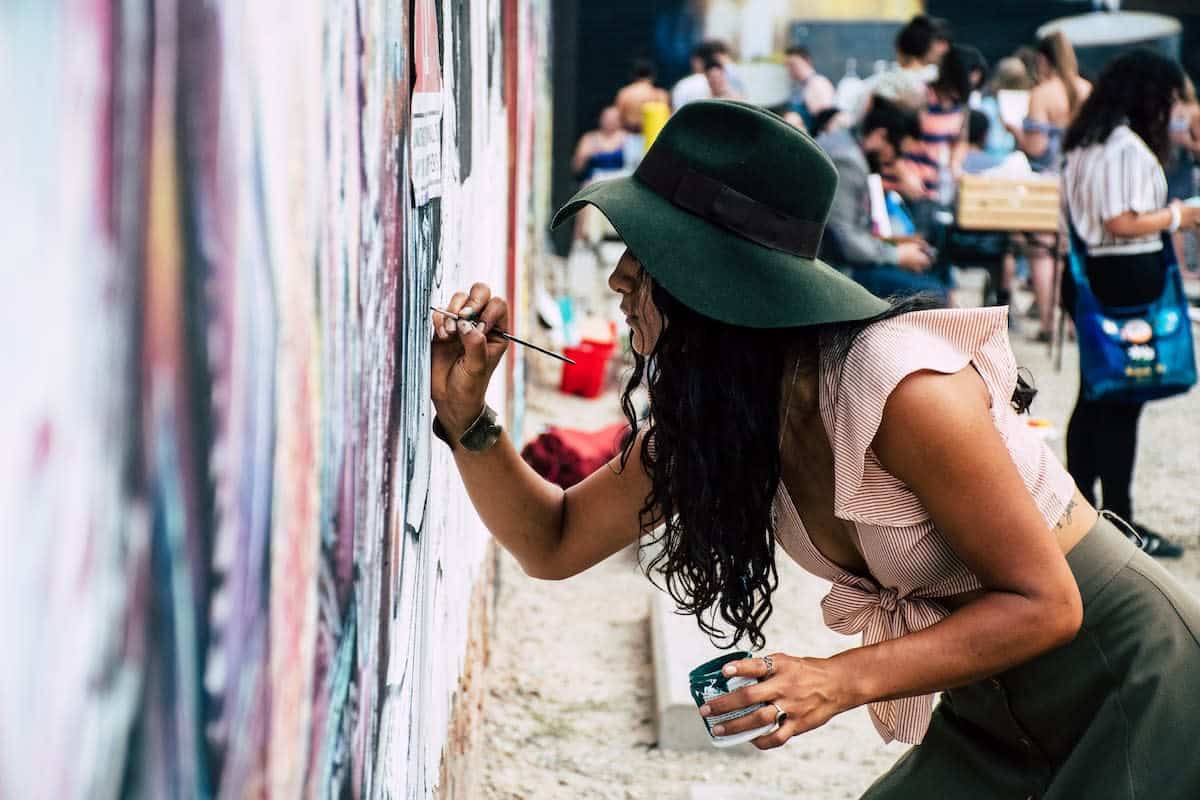
Describe Your Work
Now that you know what kind of language is appropriate for your artist profile, you can start describing the work that you do. Here you can describe a bit about the style that your artwork fits into, the kinds of techniques you use, and interesting tidbits about your process.
Your goal should be to give the reader the understanding that there’s something unique about you and your work (because there is!). Take a bit of time to really think about what defines and characterizes your art. Again, checking out other artist profile examples is a good way to get the creative juices flowing and come up with some effective vocabulary that you can use yourself.
You should also help the reader understand the message of your work, or what it is that you’re communicating through your chosen medium. This can be really helpful in giving people a framework to understand your art, and can make clicking through your online profile much more enjoyable.
Get Personal
You don’t have to share everything about yourself, but plenty of good artist website examples do share a little bit of personal information about the artist. This info should still serve the main purpose of helping readers understand what is different about your art and what you are trying to convey through it, but it’s always easier to connect to a piece with a little bit of personal information.
For example, if you spent some studying or practicing in a cool art city and that experience impacts your work today, that would be a cool piece of information to share in an artist profile. You definitely don’t need to share all of your hobbies and interests, but anything that helps contextualize your art and your purpose in making it will help people connect to your art in a deeper way.
Provide A Visual
If you look up visual artist bio samples you’ll probably see that many of them include a little visual along with the text. Having a visual reference of one of your pieces on the same page as your artist profile lets readers see your philosophy in practice without having to navigate away to a gallery on your website. Make sure to choose a piece that exemplifies the things you talked about in your bio!
Even the best artist bios need to be revised as you develop in your career. Try to review your About the Artist page regularly—every six months, at a minimum—to make sure that it’s up-to-date. Maybe you’ve snagged some art contest wins or written a stylish new case study for a recent design piece. That’s the kind of info you should definitely keep your artist profile updated with!
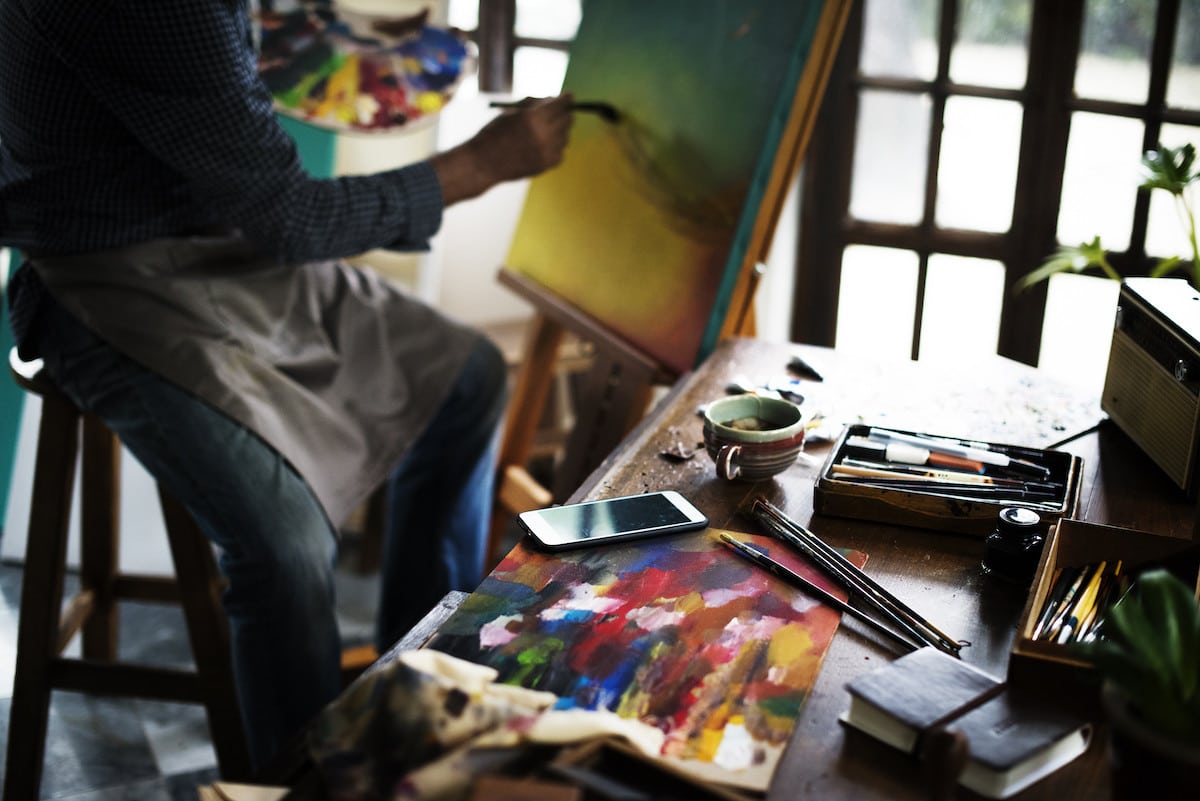
While you’re at it, it’s a good idea to update the actual content of your online portfolio as well. Keep your artist bio and the work in your portfolio as fresh as possible—that gives people good reason to keep checking back to stay on top of what you’re up to. (Need some more tips on curating your portfolio? Check out our guide to picking images for your website .)
Want a head-turning art portfolio website? Curate your work and design your website exactly the way you want it. Start your free trial with Format today!
Marketing your art business and landing new clients isn’t always easy, but an awesome, informative artist bio can really help your portfolio stand out and make your name stick in people’s minds. Take the time to write a good one!
Looking for more writing tips for artists? How To Write Product Descriptions That Really Sell Write a Better Artist Grant Application in 15 Steps Here’s How to Write An Amazing Instagram Bio in 10 Minutes
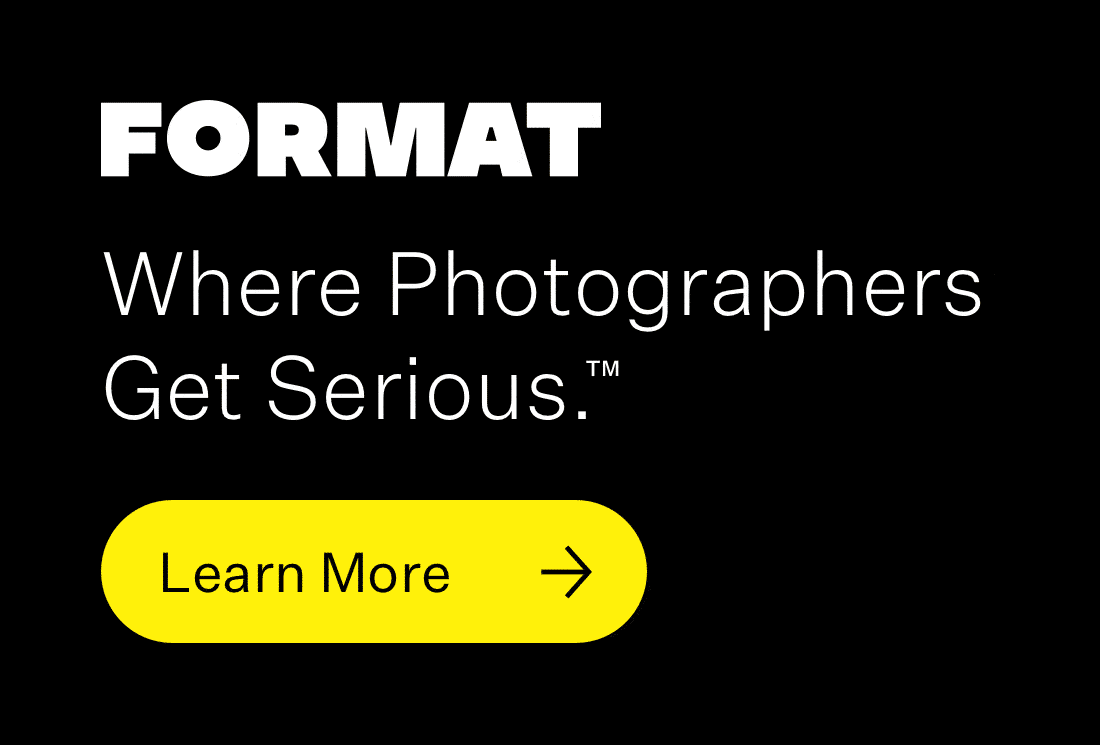
A Guide to Improving Your Photography Skills
Elevate your photography with our free resource guide. Gain exclusive access to insider tips, tricks, and tools for perfecting your craft, building your online portfolio, and growing your business.
Get the best of Format Magazine delivered to your inbox.

Nigerian Artist Abraham O. Oghobase on Exploring Identity and Representation
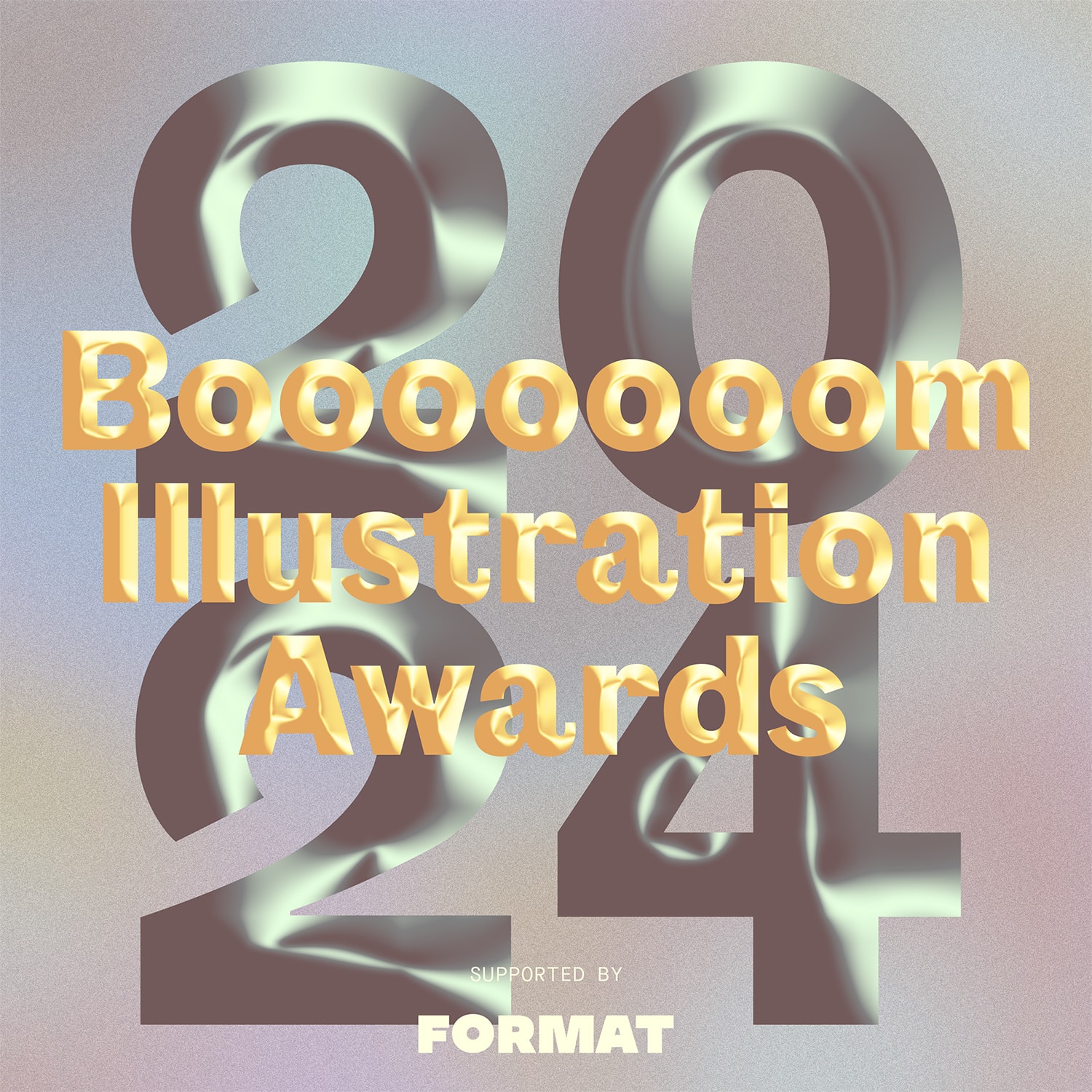
Enter the Booooooom Illustration Awards: Supported by Format

Winners Announced: Format Online Portfolio Giveaway in Partnership with BWP

How to Edit an Impactful Montage Reel for Your Portfolio That Highlights Your Skill

21 Essential Design Blogs to Spark Your Creativity in 2024

World Humanitarian Day and the Power of Visual Storytelling

Mastering Pet Photography: 29 Tips for Perfectly Capturing Your Clients’ Pets
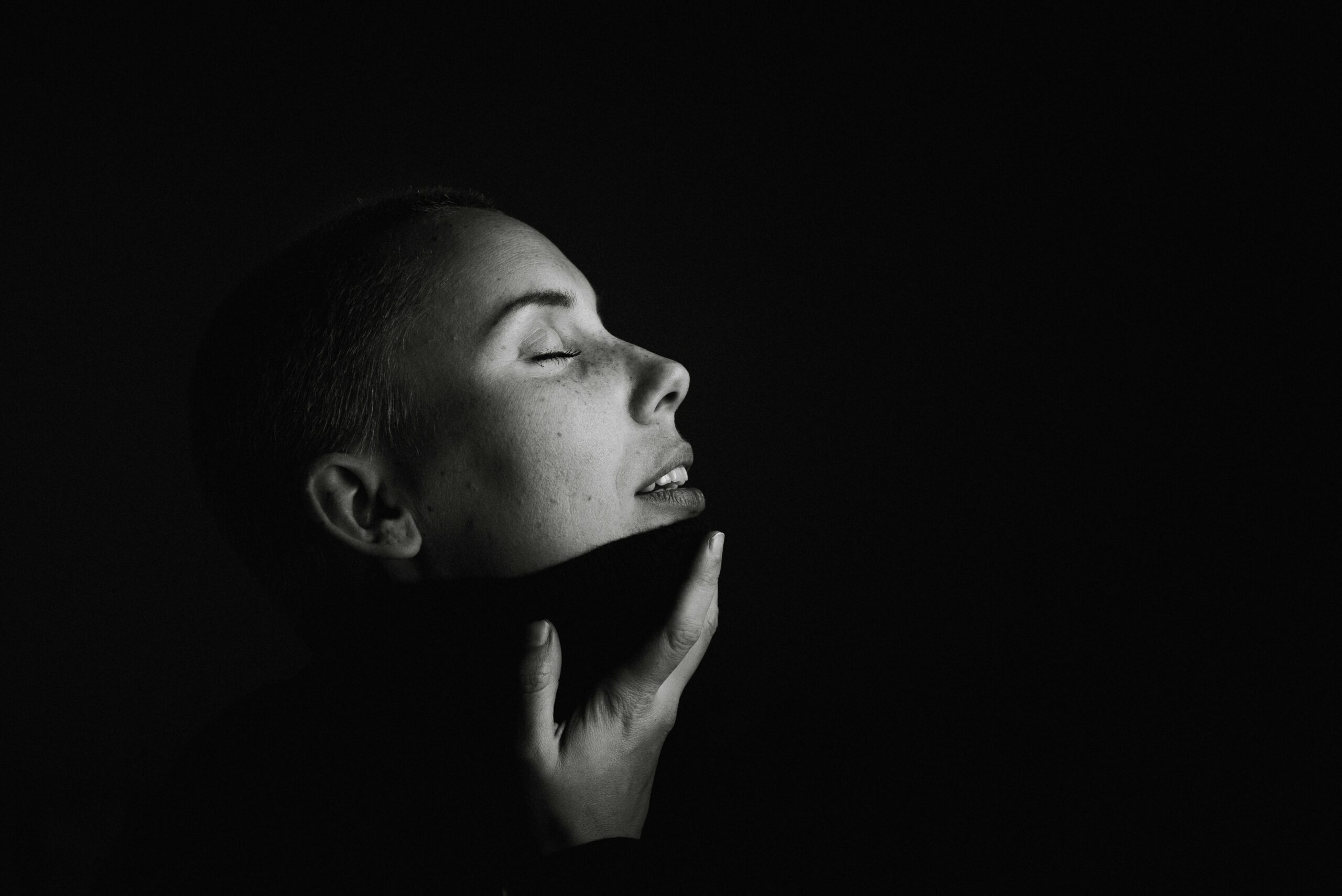
Capturing Stunning Images: A Comprehensive Studio Lighting Guide
*Offer must be redeemed by September 30th , 2024 at 11:59 p.m. PST. 50% discount off the subscription price of a new annual Pro Plus plan can be applied at checkout with code PROPLUSANNUAL, 38% discount off the price of a new annual Pro plan can be applied with code PROANNUAL, and 20% discount off the price of a new Basic annual plan can be applied with code BASICANNUAL. The discount applies to the first year only. Cannot be combined with any other promotion.

- Join Free Training
Writing An Artist Bio: The Ultimate Guide for Fine Artists
SHARE ARTICLE:
As a visual artist, you may not consider yourself a writer, and that’s OK.
But your Artist Bio is an important piece of writing you do need to nail down.

You will need it for exhibition or gallery applications, artist websites, press releases, publicity materials, etc…
The good news is once you have it done and dusted, you won’t need to do it again!
At most, you will simply refine it over the years.
So read along, and let’s get your Bio done right…
Artist Statement and Artist Bio: What’s the difference?
The two powerful tools you can use to communicate the meaning and intentions behind your art to your audience are your artist statement and artist bio.
Your artist statement is a great way to share your creative process, inspiration, and philosophy with your audience. It’s like a manifesto for your art, where you can dive deep into what drives you to create and what you hope to achieve through your work.
On the other hand, your artist bio is like a snapshot of your artistic journey so far. It’s a potted history of your life as an artist, highlighting your achievements, experiences, and background. Your artist bio serves as an introduction to your work, and it helps your audience understand your perspective as an artist.
In other words, while your artist statement focuses on your art and medium, your artist bio is all about YOU as an artist.
When you introduce your art in your artist statement, it’s like saying, “Hey folks, check out my art!” But when it comes to your bio, you’re basically saying:
🙋♂️ “Hey folks, here’s a little bit about me!”
Important Considerations Before Crafting Your Artist Bio
We get it – talking about yourself can feel awkward, but the details about your passion, inspiration, and dreams are just as crucial as your artwork. People are naturally curious creatures, so it’s no surprise that viewers and readers want to know a bit about you. After all, your art is a reflection of who you are as a person and an artist.
There are a few things you might want to consider before you get started with your artist bio. Let’s go through them together!
✅ It’s OK to show a glimpse of your personality.
Starting off your artist bio with a hook is crucial to grabbing your readers’ attention.
A little bit of humor can go a long way in reeling them in and warming them up to both you and your art. So why not give it a shot and inject some personality into your bio?
✅ Your artist bio should not be too corporate—it’s not a CV or a resume.
When it comes to crafting your artist bio, it can be tempting to list out every single accomplishment and accolade you’ve received throughout your career.
But most of the time, less is often more.
Instead of overwhelming your readers with a laundry list of accomplishments, it’s important to be selective and choose only the most noteworthy and relevant highlights of your career. This will not only make your bio more concise and easier to read, but it will also give your readers a better sense of who you are as an artist.
Crafting Your Artist Bio: Tips and Tricks for Fine Artists
Okay, it’s time to roll up our sleeves and get started on writing that artist bio.

To help you out, we’ve gathered some handy tips and tricks that will make the process easier and more effective.
✅ Write in the third person (e.g., he, she, his, hers, they)
Have you ever considered what someone else might write about you if given the task of crafting your bio?
It may seem like a strange exercise, but putting yourself in someone else’s shoes and imagining what they might say about you can be an incredibly helpful tool in crafting your own bio.
This exercise can help you identify the most important aspects of your career and artistry from an outsider’s perspective, as well as highlight any strengths or unique qualities that may not have been immediately apparent to you.
So, what might someone else write about you? Perhaps they would focus on your bold use of color or your ability to create intricate and detailed works of art.
Maybe they would highlight your commitment to environmentalism and the use of sustainable materials in your artwork. Or perhaps they would focus on your professional accomplishments and exhibitions.
Regardless of what they might say, the exercise of imagining someone else’s perspective can help you gain clarity and insight into your own career and artistic identity.
Use these insights to inform your own bio and make it truly stand out to potential clients and fans.
✅ Keep it concise and straight to the point.
As a fine artist, you want your artist bio to leave a lasting impression on your readers – but you don’t want to bore them with a lengthy essay. That’s why it’s important to use simple and direct sentences that will keep your readers engaged and interested in what you have to say.
By using concise language and avoiding complex sentence structures, you can make your bio easy to read and understand. This will not only help to hold your reader’s attention, but it will also give them a better understanding of who you are as an artist and what you have to offer.
So, the next time you sit down to write your artist bio, remember to keep it simple and direct. Your readers will thank you for it. 😉
✅ Be creative.
Your creativity is your greatest asset – and that should extend to your artist bio as well. While it can be tempting to stick to a standard format or template, your bio is an opportunity to showcase your unique personality and artistic style.
So, don’t be afraid to get creative with your bio!
Your bio can be a combination of
➡️ where you came from
➡️ where you went to school
➡️ your inspirations
➡️ your artistic process and philosophy
➡️ your interests
➡️ and your accomplishments as a human being.
All of these add more dimension to your narrative. You can tackle different angles, but make sure that the subject is always your artistic development.
But let’s be real, how can you make your bio stand out and tell a compelling story?
One way is to use timelines and narrative progression to organize your thoughts and show your artistic journey in a clear and coherent manner. Break down your career highlights into different time periods, so readers can see how your work has evolved over time and how you have grown as an artist.
To get started, make sure your timelines are easy to follow. Use bullet points or subheadings to separate different phases of your career and highlight your key achievements and milestones from each era.
And don’t forget about the importance of narrative progression – by framing your career journey as a progression from past to present , you can help readers understand how each phase of your career has influenced the next.
With these tips in mind, you can create a killer artist bio that showcases your artistic development and highlights the unique qualities that make you a standout in your field.
Should Previous Non-Art Related Degrees and Jobs Be Included in an Artist Bio?

The answer is simple – yes, you may include them! Your bio is the perfect place to share your unique journey as an artist.
The trick to including non-art-related experiences in your bio is to connect them with your current artistic career . How did those experiences shape your perspective and inspire your work? For instance, if you worked in the field of child welfare, how did that experience influence your artistic vision?
Including non-art-related experiences can make you a more interesting artist and give viewers a deeper understanding of who you are as a person. It’s not just about your art degree but about the experiences that make you who you are today.
When writing your bio, don’t keep your previous jobs and degrees separate from your artistic career. Integrate them into your story and tell your audience how they have impacted your artistic process.
What’s the Perfect Length for Your Artist Bio?
If you have been wondering how long your biography should be, we’ve got you covered!
Here are some pointers to help you decide on the length of your artist bio:
✅ Your biography can be as short as a few paragraphs or as long as two to three or four pages. It really depends on how much information you want to include.
✅ If you want to keep it short and sweet, a brief summary or biographical statement at the back of your portfolio or on your website is perfectly fine. This gives a quick overview of your background and accomplishments.
✅ If you want to provide more detail, an extensive biography can be very helpful and effective in making sales. This can be from three to seven pages long, written in the third person, and laid out in a magazine-style format. This type of bio is ideal for artists who want to give collectors a more in-depth look at their life and career.
✅ Your biography is a document that can evolve over time and can grow or shrink in length. Keep it up to date with your latest achievements.
✅ Sharing your background, life, and career development can help establish additional credibility for you as an artist. Potential buyers find it fascinating, and it creates a deeper connection with them.
✅ You can combine your short bio with elements of your artist statement to weave together your work and life. This can make your bio a little lengthier, but it gives readers a more holistic view of your artistic vision and process.
There’s no one-size-fits-all answer to how long your artist bio should be. Consider your goals and the level of detail you want to share, and use that as a guide when crafting your biography.
Oops! Don’t Make These Mistakes When Writing Your Artist Bio
Did you make these mistakes when writing your artist bio? Don’t worry—it’s not too late to fix them! Let’s take a look at some of the most common pitfalls to avoid when crafting your artist bio.
✅ Poor Writing
When it comes to your artist bio, it’s crucial to make sure it’s well-written and polished. You don’t want any errors or awkward sentences to distract your audience from your amazing work.
So, take the time to proofread it multiple times and make sure it’s free of any mistakes. Even small writing errors can give off an unprofessional impression to your readers.
✅ Sharing too much information
While it can be tempting to include every detail of your life, it’s best to stick to information that is relevant to your artistic identity. Avoid sharing too much information about your personal life or unrelated accomplishments and instead focus on highlighting your artistic achievements and aspirations.
✅ Lack of personality
Let your artist bio be a reflection of your one-of-a-kind personality and style. Avoid using generic terms and concepts that make you sound like a robot. Instead, infuse your bio with your unique voice and perspective on life to make it stand out.
Ready to share your Artist Bio with the world? Here are a few things you should do first
So, you’ve written your artist bio, and you’re eager to share it with the world. But before you hit that publish button, there are a few crucial steps you should take to make sure your bio is polished and ready to impress.
✅ Read, reread, and proofread
Have you read your artist bio out loud yet? This is a crucial step in making sure that your bio sounds both natural and professional while still being approachable to your audience.
Now, chances are, your first draft is going to need a lot of trimming down. That’s why it’s important to reread it multiple times and make changes to any areas that need improvement.
And don’t forget to ask a friend to proofread it for you as well. They can give you valuable feedback on how to make it look and sound even better. Trust us, it’s always helpful to have a fresh set of eyes review your work!
✅ Have a fellow artist review your artist bio—hear that second opinion 😉

It’s always a good idea to have someone else take a look at your artist bio before sharing it with the world. And who better to turn to than a fellow artist? They can give you honest and objective feedback that can help you refine your message and make sure that your bio truly reflects your identity as an artist and your body of work.
So, if you have an artist friend who’s willing to take a look, don’t hesitate to send them a copy of your bio and ask for their thoughts. Ask them what they loved about it and what could be improved. Their insights could help clarify your message and make your bio even more effective.
How Often Should You Update Your Artist Bio?
Well, the answer is pretty straightforward – as often as you need to!
Your artist bio is an important tool for introducing yourself to potential buyers, galleries, and employers, so it should be kept up to date as your career progresses.
Revisiting your biography every year is a great way to ensure it still accurately represents your current work and achievements. As you continue to create new pieces and gain recognition, you’ll want to make sure your biography is showcasing your latest and greatest.
It’s easy to fall into the trap of using an outdated biography. You may have created a biography early on in your career, and it may not be relevant anymore. That’s okay! Take some time to review and update it, and make sure it reflects your current work and accomplishments.
Your artist bio is a BIG deal.
And the good news is that once you have it ready, you feel a BIG relief.
It’s what can set you apart from the rest and help you connect with your audience. So, when you sit down to write it, take your time and put in the effort to craft something that really reflects who you are as an artist.
Your bio can add that extra layer of interest and intrigue to your art, so make it count!
Want one on one help with your bio? If you would like to have word-by-word artist bio templates, your own bio revised and edited by a professional art writer, then consider applying to our flagship program – the Professional Artist Accelerator .
Similar Posts You Might Also Like...
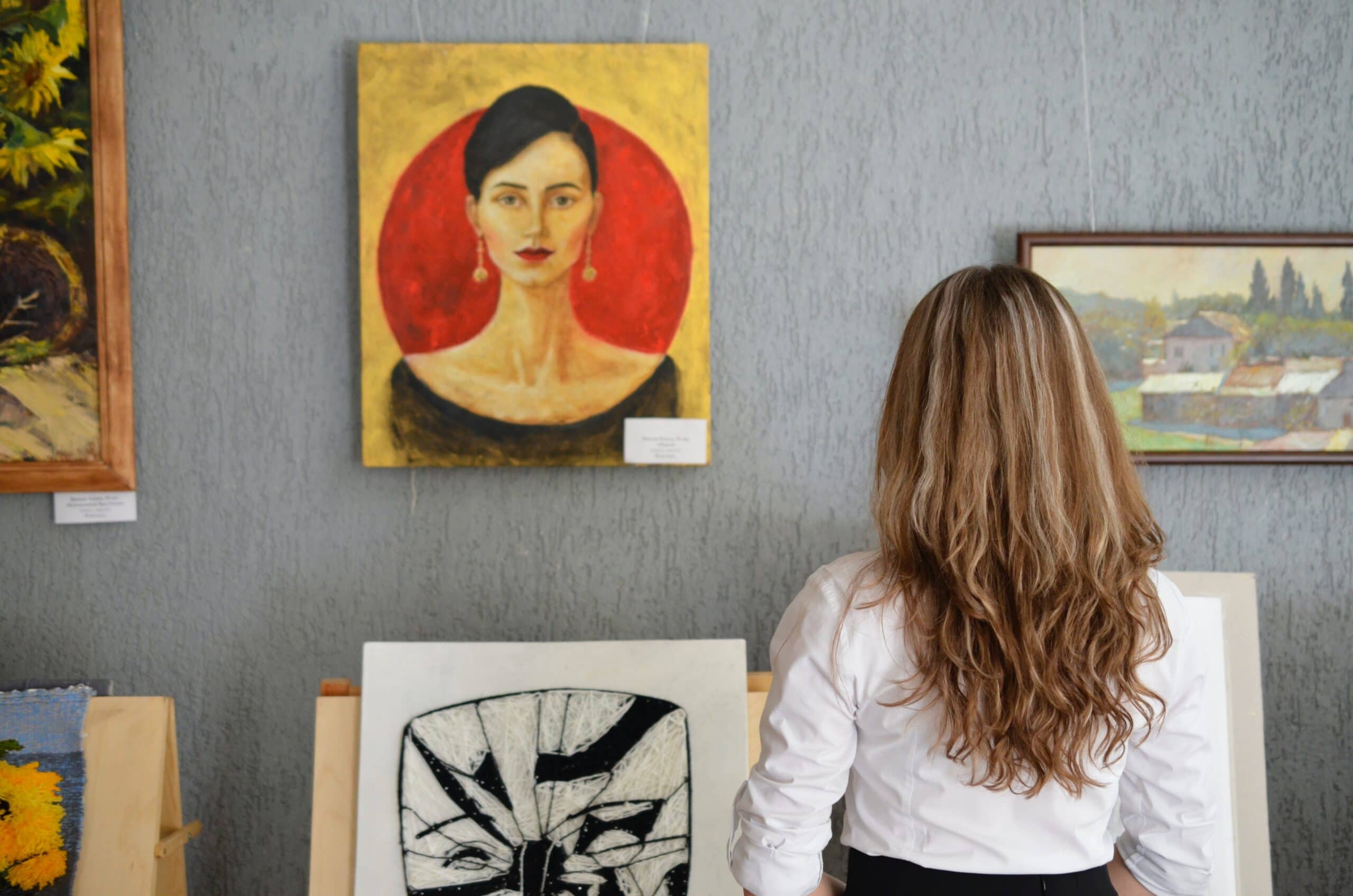
Crafting a Professional Artist Portfolio for Galleries: An Ultimate Guide
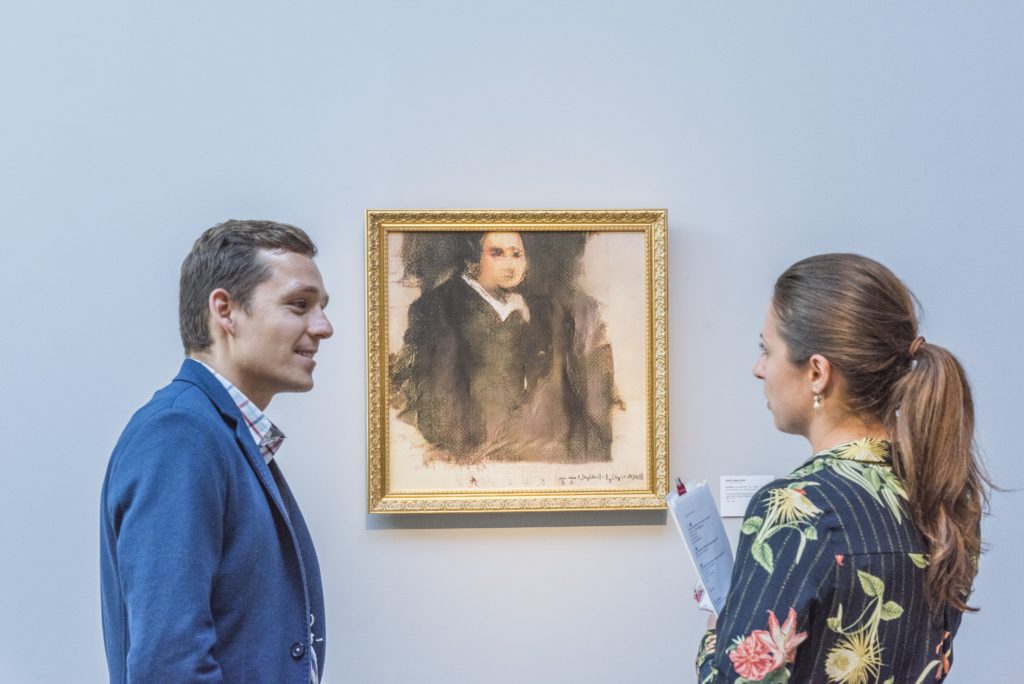
AI Art: The Ultimate Guide for Fine Artists

NFTs: The Ultimate Guide for Painters, Sculptors & Fine Art Photographers
Leave a reply.
Your email address will not be published. Required fields are marked
Save my name, email, and website in this browser for the next time I comment.

HOW TO WRITE A GREAT BIO FOR YOUR ARTIST PROFILE

- First Impression: It's often the first thing people read about you.
- Connection Tool: Helps audiences and clients relate to you and your work.
- Professional Summary: Showcases your artistic journey and achievements.
Key Components of an Artist Bio
1. artist profile introduction: crafting a compelling opening, name and artistic discipline.
- Full Name: Start with your full name. If you have an artistic pseudonym, include it, but ensure your real name is also present for professional transparency.
- Artistic Field: Clearly state your primary artistic field or specialty. For example, are you a painter, sculptor, digital artist, photographer, etc.?
Unique Selling Point (USP)
- Defining Characteristics: What makes your art stand out? Perhaps it's your use of color, thematic focus, innovative techniques, or a unique blend of styles.
- Engaging Description: Use descriptive, emotive language to engage readers. Instead of saying, "I paint landscapes," try, "I capture the untamed beauty of the natural world through vibrant landscapes."
- Connection to Audience: Think about what aspect of your work might resonate most with your audience. Is it the subject matter, your artistic process, or the emotions your work evokes?
Tips for SEO Optimization
- Keywords: Use keywords that potential clients or art enthusiasts might search for. If you're a "contemporary landscape painter in New York," make sure these keywords are naturally integrated.
2. Artistic Background and Education: Key Elements for a Rich Narrative
Artistic journey.
- Start of Your Journey: Describe how and when your interest in art began. This could be an early fascination with drawing, a pivotal moment that sparked your passion, or a gradual evolution into your art form.
- Development Over Time: Highlight key moments and experiences that have shaped your artistic path. This could include significant projects, personal challenges, or turning points in your career.
Education and Training
- Formal Education: If you've attended art school or university, mention this, including any majors or specializations.
- Workshops and Courses: Include any relevant workshops, online courses, or informal training that have contributed to your skills.
- Self-Taught Skills: If you're largely self-taught, emphasize this aspect. Discuss how you've developed your skills independently, showing your dedication and self-motivation.
- Artistic Influences: Talk about artists, art movements, or even specific artworks that have influenced your style or approach.
- Personal and Cultural Influences: Mention any personal experiences, cultural heritage, or other factors that have shaped your artistic perspective.
- Relevant Keywords: Integrate keywords related to your educational background, influences, and artistic journey. For instance, "self-taught mixed media artist," "influenced by Impressionism," or "graduate of [Art School Name]."
- Hyperlinks: If you mention any notable institutions, workshops, or artists, consider adding hyperlinks to their websites (if available). This not only provides additional context but also helps with SEO.

3. Exploring Artistic Style and Philosophy: Defining Your Unique Voice
Describe your style.
- Visual Characteristics: Explain the key visual elements of your work. Do you favor bold colors, intricate details, abstract forms, or a minimalist approach?
- Techniques and Mediums: Discuss the techniques and mediums you use and why you choose them. For instance, if you're a painter, do you prefer oil, acrylic, watercolor, or mixed media? What about these mediums speaks to your artistic vision?
- Evolution of Style: If your style has evolved over time, briefly touch on this journey. It helps demonstrate growth and adaptability in your artistic career.
Philosophy and Inspiration
- Artistic Philosophy: What are the core principles or beliefs that drive your art? This could be a commitment to realism, a focus on social commentary, an exploration of emotions, etc.
- Sources of Inspiration: Share what inspires your work. It could be nature, urban landscapes, personal experiences, social issues, or historical events.
- Connection with Viewers: Explain how you hope your work will resonate with viewers. Do you aim to provoke thought, evoke emotions, or simply provide aesthetic pleasure?
- Descriptive Keywords: Include keywords that describe your style and philosophy. These might be genre-specific (like "surrealist" or "landscape photographer") or technique-oriented (like "encaustic painting" or "digital collage").
- Artistic Movements or Techniques: If your work aligns with specific artistic movements or uses unique techniques, mention these with relevant keywords. For example, "inspired by Abstract Expressionism" or "specializing in chiaroscuro technique."
4. Highlighting Achievements and Exhibitions: Showcasing Artistic Success
Exhibitions and shows.
- List of Exhibitions: Include a list of notable exhibitions or shows where your work has been featured. This can include solo shows, group exhibitions, or participation in art fairs.
- Galleries or Venues: Mention the names of significant galleries, museums, or venues where your work has been displayed.
- Dates and Locations: For each exhibition, provide the date (or year) and location. This information adds credibility and context to your experience.
Awards and Recognition
- Awards: If you've received any awards, grants, or honors for your work, list them here. Even smaller, local awards can add to your credibility.
- Residencies: Mention any artist residencies you've participated in, highlighting what you accomplished or learned during these experiences.
- Media Mentions: If your work has been featured in art journals, magazines, blogs, or other media, include these as well. Hyperlinks to the articles or features can be very beneficial.
- Relevant Keywords: Use keywords related to your exhibitions, awards, and recognitions. For instance, "award-winning sculptor," "exhibited at [Gallery Name]," or "featured in [Art Magazine]."
- Hyperlinks: Include links to the galleries, art fairs, or articles where your work has been featured. These links enhance your bio's SEO and provide readers with easy access to more of your work and achievements.
- Structured Format: Presenting this information in a structured, easy-to-read format (like bullet points) helps with both readability and SEO.
5. Adding Personal Touches: Incorporating Quotes in Your Bio
Future goals.
- Aspirations: Talk about what you hope to achieve in the future, whether it's a specific project, a new style or technique you want to explore, or broader career goals.
- Upcoming Projects: If you have upcoming exhibitions, collaborations, or projects, mention them to generate interest and showcase your ongoing commitment to your art.
Including a Quote
- Personal Quote: Include a quote that encapsulates your artistic philosophy or approach. This could be something you often say about your art or a reflection on what art means to you.
- Contextualize the Quote: Don’t just insert the quote randomly; introduce it in a way that flows naturally from the rest of your bio. For example, after discussing your artistic journey, you might add, “As I often say, ‘Art is not just a practice, it's a way of living.’”
- Keywords in Stories and Quotes: Use relevant keywords in your quotes, but ensure they fit naturally. For instance, if you’re known for landscape paintings, you might say, “I’ve always believed that every landscape painting is a story of nature untold.”

ARTIST BIOS: EVERYTHING YOU NEED TO KNOW
As an artist, one the most important tools you have to market yourself and your brand is your artist bio. This single paragraph describes who you are and what your vision is all about, and it’s basically your first introduction to potential clients. We know that many artists struggle with trying to come up with something catchy and compelling that accurately describes who they are and what they do, so we put together this handy guide on how to write an awesome artist’s bio.
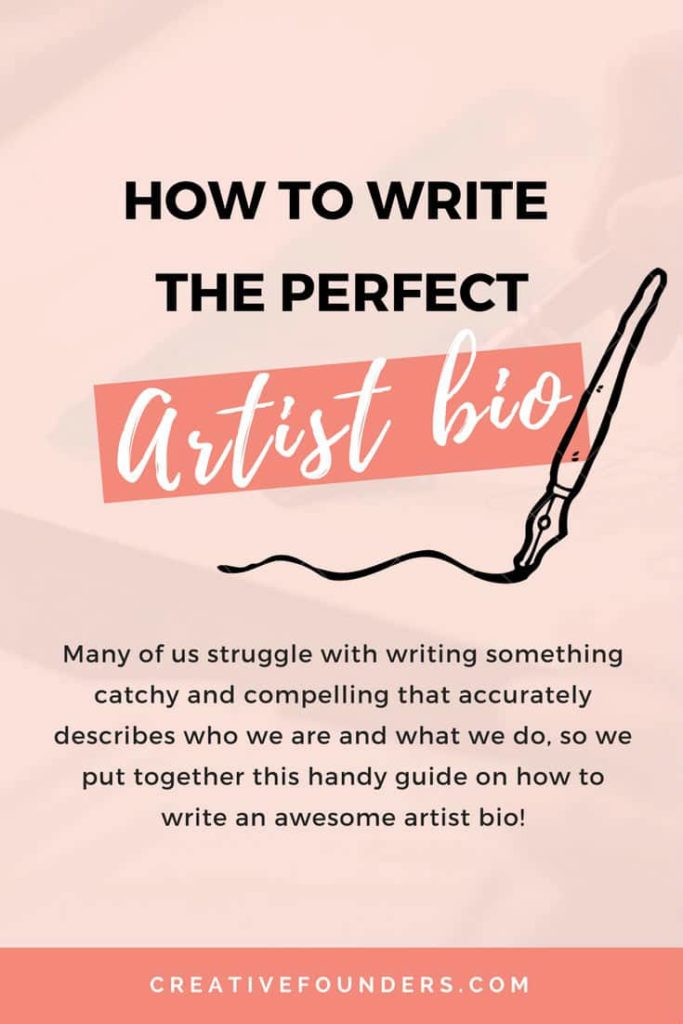
HOW TO WRITE THE PERFECT ARTIST BIO
What are artist bios and why are they important.
An artist’s biography is basically a brief paragraph that explains who you are as an artist, why you do what you do, and what you create. Artist’s bios are almost always written in the third person and are usually around 150 words. Your bio can be placed on your website, in your portfolio or submitted with your work for an exhibition or show.
Many people confuse the artist’s bio with an artist’s statement or even a CV, but they’re actually quite different. While an artist’s statement provides information about your artwork like a particular collection of works or a particular piece, and a CV lists your experience and accomplishments, your artist’s bio should be all about you, your practice and your philosophy.
Artist bios are important because they provide potential clients or fans with an introduction to you as an artist so that they can better understand you and your work. Your artist biography can also be great for SEO, as the keywords in your bio will help search engines connect you to people who are looking for artists who do the type of work you do.
WHAT SHOULD I INCLUDE IN MY ARTIST BIO?
At the very least your artist’s bio should include:
– Your name – The medium and techniques you use – Key themes in your artwork – Your philosophy
Other information you may or may not want to include could be your influences, previous experiences like education, exhibitions or awards received and current projects or collaborations. Remember though, your bio should be roughly 150 words, so you need to keep it brief and only include the most relevant information.
SOME THINGS TO THINK ABOUT BEFORE WRITING YOUR ARTIST’S BIO
Before sitting down and writing your artist’s bio, think about what makes your work special. Do you use a unique medium or technique? Does your work speak to a particular segment of society or provide value to a certain group of people? What do you want to achieve with your work and what do you hope people take away from it?
We know that it can be difficult to try and write about yourself, especially when you’re trying to big yourself up and make a good impression on potential clients. We recently watched a great TED Talk by Simon Sinek about why great leaders inspire action, and he suggested that when talking about yourself, you should always talk about the ‘why’ first.
Sinek says that most people talk about what they do and how they do it, but that doesn’t really inspire or motivate people to buy a product or become loyal to that person or brand. However, he said that when people talk about why they do what they do, it resonates with other people on a deeper more heartfelt level. So before writing your artist bio, think about why you create what you do and use that as a starting point.
TIPS ON WRITING ARTIST’S BIOS
Keep your bio simple, straightforward and to the point. After all, the goal is to help the reader better understand you and your vision, so you don’t want to confuse them with flowery language or jargon or lose their interest by rambling off on a tangent.
* Try not to use superlative language (i.e. ‘the best’ or ‘the most amazing’) or exaggerated claims. Yes, you want to make yourself sound good, but don’t overdo it. After all, people have a tendency of seeing right through the overblown hype.
* Try to make your bio flow nicely. Remember, this is not like a CV where you simply list your accomplishments. Your bio should be engaging for the reader and inspire them to find out more about you and your work.
* Proofread your bio for spelling mistakes and grammatical errors. You may also want to get someone else to read it over for you so they can catch anything you might have missed and offer suggestions for improvement.
Still stuck for ideas? Do an Internet search for other artist’s bios and make notes of what you like and dislike about them. While we definitely don’t suggest copying another artist’s bio word for word, you can get some great ideas of what works from looking at other people’s examples.
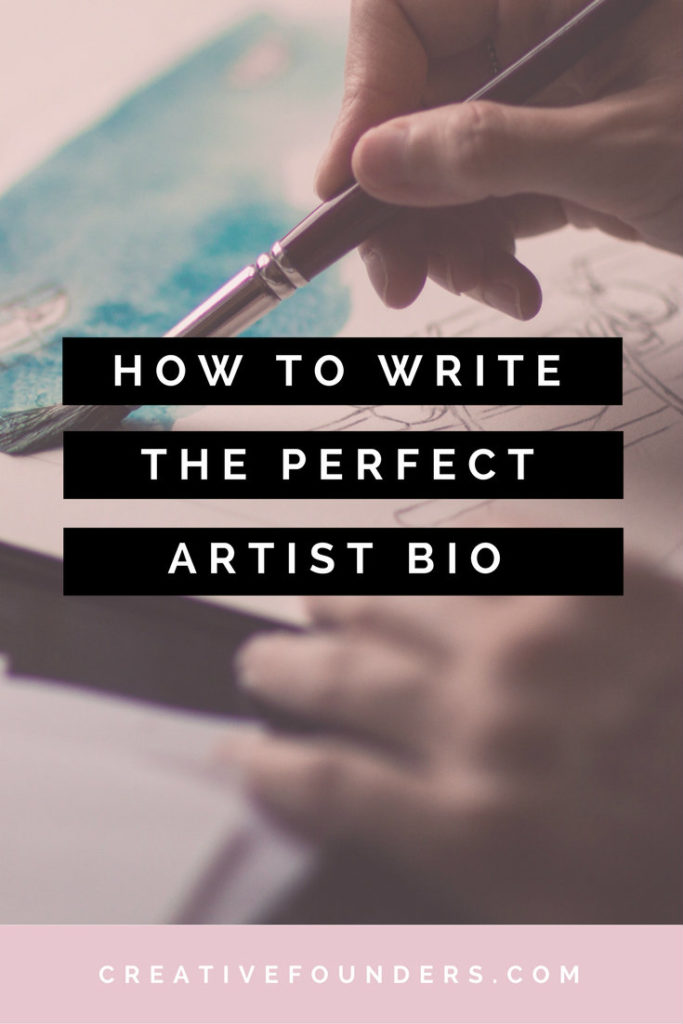
How to Write an Appealing Artist Biography
Paige Simianer | October 16, 2015 (Updated September 1, 2022)

Your artist biography is a paragraph of many talents.
It weaves the story of your art career - instilling trust as it goes - allowing you to share your credentials and achievements without speaking a word. The importance and utility of this emissary cannot be stressed enough.
Armed with this knowledge, all that’s left is to write and perfect your artist biography. Easy, right? Unfortunately, staring at a blank page trying to condense your art career into a paragraph or two is anything but. That’s why we’ve put together the five steps to writing an appealing artist biography, from start to strong finish, to get your creative juices flowing.
“The Artist’s Biography serves to provide the reader with a story about you as an artist and learn about your career credentials.” - Renee Phillips
Step 1: Understand Your Audience
Before you dive into the nitty-gritty of writing your artist biography, make sure you have a firm understanding of your audience. Will they be more interested in your past exhibitions and awards or excited about an upcoming residency or project? Sometimes it can be beneficial to adjust your biography for different readers and objectives.
For instance, if a biography is going to a gallery that frequently holds exhibitions, you’ll want to focus more heavily on your exhibition history and less on a residency.
Step 2: Choose the Right Information
Your artist biography should be a summary of significant facts about your art career written in third person. Begin by introducing yourself with your name, medium, and some background information. This can include where you were born, where you work, and when you first became interested in art. Next, discuss any art training or schooling you had and degrees earned. If none, state you’re self-taught.
Then move on to discuss your exhibitions, awards, and any other professional achievements. You can also mention if you’re featured in any important collections or prominent art publications. But, be sure not to overwhelm the reader with too much self-promotion - choose the best nuggets.
Then segue into any recent shows or important projects you’re working on such as a public art installation. End strong with any upcoming exhibitions, residencies, or projects.
Step 3: Write Multiple Drafts
Lucky are the writers who can craft masterpieces without ever moving past the first draft. If you’re not one of these gifted few (if you are, spread your wisdom), we recommend writing two to three drafts. You can try different tones and play around with language in each one. And don’t be afraid to inject a bit of personality into your biography.
While some of the components seem a bit dry, the tone and voice behind them can be anything but. You can weave in a few of your art-related interests and passions among the facts. Just remember to make sure it resonates with your audience. And save the full discussion of your purpose and the inspiration behind your art for your artist statement .
Step 4: Edit and Edit Some More
Make sure you keep your artist biography short and concise with a focused structure. It’s very easy to wax lyrical about your career and lose your readers in the process. Simple and readable will always trump jargon and flowery language when it comes to your biography. Each short paragraph - two to three max - should be succinct and flow easily into the next.
We suggest taking your drafts to a friend with an excellent grasp of grammar and blessed with writing brilliance. Your friend can help you pull the best parts together into one outstanding piece of writing. And check for spelling, grammar, word choice, and sentence structure errors.
Step 5: Show It to Another Artist
Have an artist you trust and admire read your final draft. A fresh set of practiced eyes can do wonders for your biography and help you polish it to perfection. Another reader with a trained eye will be able to tell you if your biography correctly reflects you and your art.
Bonus Step: Continue to Enhance Your Biography as You Evolve
When you write your artist biography you want it to be the best expression of your career, but don’t forget that your career is continually developing. Make sure your artist biography progresses with you. Add in and switch out professional achievements as your success and knowledge grows. You might even need to rewrite it one or more times. This means you are evolving and maturing as an artist.
Need Inspiration and a Sample? Renee Phillips has graciously included a sample artist biography on her blog. You can find it here .
Want to organize your art business and receive more art career tips?
Sign up for artwork archive (for free) here..

Share This Article
Related articles.

Monthly Art Opportunities: The Best Opportunities with July Deadlines

Here's Your Game Plan to Help You Best Prepare For Holiday Art Sales

How to Optimize Your Public Page for Art Buyers

8 Best Sites for Artists to Learn New Art Business Skills

Popular Posts
- 9 Things You Should Give Up to Be a Successful Artist
- How to Inventory Your Artwork
- Complete Guide to 2024 Artists Grants
- Seven Rules for Pricing Your Artwork
- How to Make Money as an Artist on Instagram
Love what you see?
Get the latest art news & tips delivered once a week, straight to your inbox.

How To Write A Super Artist Bio Using This Simple Example
Sharing is caring!
Stand Out By Using This Brilliant Artist Bio Example
Every artist needs one, but that doesn’t mean we enjoy writing them. The artist bio is something you’ll be asked for time and time again, but how do you write it? When in the process of writing, it’s usually very beneficial to refer to an example or template. This is particularly applicable to an artist bio example and template where you can edit and make the document your own. Luckily we’ve got one for you within this simple artist bio guide.
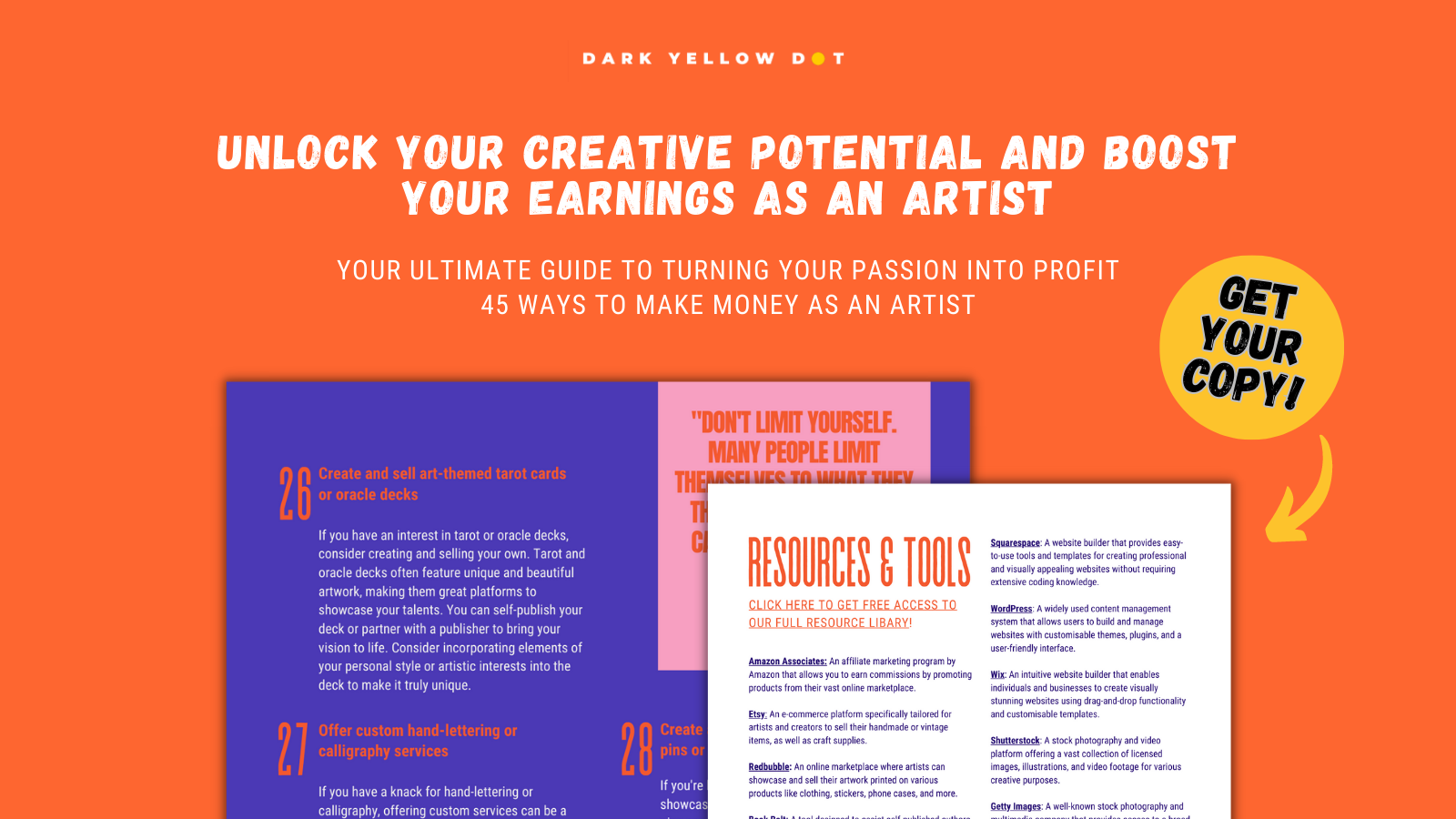
What is an artist bio?
In the complex and fairly large ‘art world’, there are a few fundamental parts appear time and time again, no matter what stage you find yourself in. Such things are usually considered industry standard and can help establish someone as a professional artist in their practice, career and beyond.
One of these crucial parts is an artist bio. But what exactly is its purpose?
Essentially, this short description is used to sum up you as a person and your career as an artist. When reading an artist bio example, you’ll realise it’s very focused on the individual themselves. Whereas, an artist statement varies significantly. Rather than discussing the artist at hand, an artist statement takes a closer look at your work, influences and processes behind it. In the case of an artist bio, we’re only focusing on you, the creative.
The job of the artist statement is to explain why you make art with the job of the artist bio to discuss who is making the art.
Why write an artist bio?
If you haven’t got an artist bio written already, here’s why you should. Firstly, everyone requires an introduction. Whether it be on their CV , when they’re networking or when they’re filling out an Instagram profile, artists should have some kind of small description ready. Not to mention, a lot of institutions, galleries and competitions will require some kind of bio when you’re working with them.
In an increasingly online world, an artist bio is some of the first information that a potential customer or fan is going to read. This is why it’s so important to have a good one, or at least one at all. Without it, a reader is going to click off because they can’t gauge an overview of who you are. Artist bios can also help drive SEO for your benefit, bringing more people to your page through search engines like Google.
This piece of text may be short and concise, but it can have a positive impact on your overall artistic career, subsequent contacts and opportunities.

How do you write an artist bio?
Now that we understand the importance of a bio, how exactly do we write one? The following advice is what we recommend applying to your text when it’s time to start writing.
Use your creativity
Artist bios have the tendency to be slightly dull. At the end of the day, it’s only there to be a summary of the artist. But this doesn’t mean you can’t show off your creative flare. Grab the reader’s attention with an interesting and smart opening sentence to keep them reading.
A simple, certified way to begin is with your name, date of birth and origin. A top artist bio example will show you that key information can still be included but in a different style. Don’t prolong the introduction of that kind of information to the end of the bio; but just kick it off with some informative but imaginative text beforehand.
Keep it short
This piece of text may be some of the shortest you’ll write in your career, other than art titles . Don’t overlook it though, it may prove to be the most pivotal. It’s recommended you aim for around 120 words, or 1-2 small paragraphs.
Be straight to the point without waffling as someone isn’t going to spend ages reading your bio to get required information. Notably, audiences are struggling to pay attention for long periods, therefore your artist bio should include all the relevant facts whilst staying concise.
Should an artist bio be written in the first person?
Preferably, artist statements should be written in the third person. This is done by using words like her, she, they, him, his. It’s a professional way of writing and is normally expected within the art industry.
However, don’t completely disregard the first person. It’s applicable when writing your artist statement and when you don’t require your artist bio to be so formal. If in doubt, check where your artist bio is being used for, and make your decision based on that.
Things to include
To make the artist bio worth yours and the reader’s time, make sure to include these key pieces of information.
– Your name
– Where you’re based
– Key art themes and techniques
– What medium you mainly work with
– Your related education
– Recent/best artistic achievements
– Any other prevalent facts that set you apart from others.
Now we have the essentials out the way, it’s time to look at topics you should be mentioning amongst them. When briefly discussing the work and overall themes, you could name drop individual works with their correct labels so that the audience has a direct reference to search for.
It’s also worth placing the artist within their historical and cultural context. For example, try referencing how they contribute to a certain discourse, including the time and movements that influence their work. This would also be a good time to introduce their current political, social and everyday context. Without realising, these factors play a huge part in making the artist and the art what they are.

Check spelling and punctuation
As with a lot of art text, they’re quite formal. You want to provide the best impression possible – so your grammar and punctuation is going to play a big part. Consider your font and ensure it looks professional by using something clear and easy to read like New Times Roman, for example.
If mentioning an exhibition title or artwork name, make sure they’re properly formatted using italics and quotations. Of course, check for spelling and punctuation errors throughout. The more credible the artist bio is – the more likely the reader will want to find out more.
Ask for feedback
Once you’ve completed a draft, ask as many people as possible for feedback. Sometimes when you’re immersed into your own writing, you’ll fail to spot errors. You can ask anyone for feedback, including family and friends, but it’s also worth asking someone within the art industry. This way, they’ll know exactly what to look out for, having read countless art bio examples in their time.
Remember to update
This is particularly worth noting when it comes to young and beginner artists. Each time you send or print your artist bio, make sure you’re double checking to see if any new information needs adding. Your themes may have shifted, your choice of materials may have changed and you could have relocated.
These key points need to be up to date if you want readers to come away with the correct information and idea of you. It’s useful to always save a digital version of your artist bio that you can revisit and update when needed.

Common artist bio mistakes to avoid
╳ too much praise/bias.
Be aware of sounding too biassed in these artist bio’s. As much as you want to praise yourself (or other artists), the bio must be neutral. Avoid sounding too commercial like you’re selling the art and focus on educating.
╳ Not updating
Don’t forget about your artist bio, and only update it when you need to. If not, you’ll more likely to rush writing a new one – forgetting how to structure a good bio altogether. See it as a regular job, updating it as you progress through your career. That way, it’ll be ready to go whenever it’s called upon.
╳ Art jargon
The point of an artist bio is to get all the relevant information across in a simple and concise manner. Purposely filling your text with fancy art jargon isn’t going to allow for an accessible read, and it’s lieky even the smartest art collector will see through it. Use appropriate language that actually communicates an idea with overcomplicating it.
╳ Too long
A common issue that arises in art bio’s is a long piece of text. Perhaps try to write your artist statement first, so you’re less inclined to cover everything all over again in the bio. This text is supposed to be short, so don’t worry that you can’t fit every exhibition you’ve ever done. Save that for your artist CV.

3 artist bio examples
If you’re looking for some additional help, check out the included artist bio examples below. Remember, everyone’s bio’s follow different structures and requirements. To write your perfect bio, dig deeper into what your version is for and why.

Sarah Lucas – artnet.com
Sarah Lucas is a contemporary British artist known for her kinesthetic photographs, performances, and sculpture. Appropriating commonplace materials, the artist creates crude and often inflammatory comments on sexuality, death, and gender. She is recognized as among the most prominent members of the Young British Artists alongside Damien Hirst , Tracey Emin , and Gary Hume .
Born in 1962 in London, United Kingdom, she studied at the Working Men’s College, the London College of Printing, and Goldsmith’s College where she received her BFA in 1987. The artist rose to prominence and critical acclaim during the late 1980s. Her work has been exhibited at the Walker Art Centre in Minneapolis and the Tate Liverpool. In 2015, Lucas represented the United Kingdom at the Venice Biennale, where she exhibited her controversial installation I SCREAM DADDIO . The artist currently lives and works in London, United Kingdom. Her works are in the collections of the Museum of Contemporary Art in Chicago, The Museum of Modern Art in New York, and the Centre Georges Pompidou in Paris.
Artist bio example taken from artnet.com
Patrick Heron – tate.og.uk
Patrick Heron (30 January 1920 – 20 March 1999) was a British abstract and figurative artist, critic, writer, and polemicist, who lived in Zennor, Cornwall. Heron was recognised as one of the leading painters of his generation. Influenced by Cézanne, Matisse, Braque and Bonnard, Heron made a significant contribution to the dissemination of modernist ideas of painting through his critical writing and primarily his art.
Heron’s artworks are most noted for his exploration and use of colour and light. He is known for both his early figurative work and non-figurative works, which over the years looked to explore further the idea of making all areas of the painting of equal importance. His work was exhibited widely throughout his career and while he wrote regularly early in his career, notably for New Statesman and Arts New York , this continued periodically in later years.
Artist bio example taken from tate.og.uk
Alexander Calder – artsy.net
Alexander Calder changed the course of modern art with his three-dimensional kinetic sculptures, which Marcel Duchamp named “mobiles.” Resonating with tenets of Futurism , Constructivism , and early non-objective painting, Calder’s mobiles consist of boldly colored abstract shapes, which are made from industrial materials and hang in lyrical balance. Calder was an international phenomenon during his lifetime. He won the grand prize for sculpture at the 1952 Venice Biennale, where he represented the United States. He earned the French Legion of Honour and the American Presidential Medal of Freedom, among other honours.
Calder has been the subject of solo exhibitions at the Museum of Modern Art , the Rijksmuseum , the Louisiana Museum of Modern Art , and the Museo Reina Sofía . His work regularly sells for eight figures on the secondary market. Though Calder is best known for his mobiles, his diverse practice also encompassed standing sculpture, painting, set and costume design, large-scale public installation, and jewellery-making.
Artist bio example taken from artsy.net

Free artist bio template
If you’re a beginner artist and you’re wanting to get started straight away, an artist bio template will able to help you out. Simply replace and fill in the blanks with your own details and you’ll have a basic artist bio in no time. Feel free to rearrange the layout and come up with your own intriguing opening sentence.

Free Artist Bio Template Covers:
– What materials you use
– Where/what/when you studied
– What type of artist you are
– The year and place of birth
– Your notable exhibitions
– Your applicable awards, residences and projects
In Conclusion
Every artist needs an artist bio, so there’s no point putting off the creation of one. It’s better to have a rough idea or draft that you can work with, than nothing at all. You never know, your next big opportunity could be around the corner – and they’ll want an artist bio for sure. Follow these steps and take inspiration from our examples to make sure yours is the best it can be, when the time comes.
WHAT ARTIST BIO EXAMPLE DID YOU FIND MOST HELPFUL? LET US KNOW IN THE COMMENTS BELOW.
Also, don’t forget you can always share your art with us or tag us on Instagram – @darkyellowdot .
Thank you for reading and if you found this article useful, share it around, that makes us happy. To receive more posts like this and updates, join our mailing list, everyone is welcome.
N EED MORE ADVICE?
Articles to help:.
5 Easy Tips For Building Your Instagram Presence As A Digital Artist
How to Write Successful Art Proposals In 2022 (Easy Tips For Artists)
How To Write An Artist CV When You Don’t Have Much Experience
SITES TO HELP:
Tate.org.uk
COURSES TO HELP:
Write an Effective Artist Bio, Build Your Creative Business, Series for Artists & Makers
How to write an Artist Bio that will Impress Art Directors + Gallery Curators.
Write Your Artist Statement In 3 Simple Steps

Discover More Here
I am constantly searching online for ideas that can facilitate me. Thanks!
Oluwole Olurinde
Quite excited. I gained a lot from the lesson. All examples excellent most attractive is the well outlined for beginners. I really appreciate Thanks a lot.
Leave a Reply Cancel reply
Your email address will not be published. Required fields are marked *
Save my name, email, and website in this browser for the next time I comment.
Post comment _
The Beginning Artist
Artist Statement & Artists Bio Examples
As an artist you normally only have a few seconds to grab the attention of your audience. If there is something slightly off and your art doesn’t captivate someone right away, people are just going to pass along.
Your artist statement and artist bio are the same. You want them to quickly hit on all the important point without losing someone’s attention, similar to an elevator pitch.
Artist Statement Vs. Artists Bio
The artist statement and artist bio are very different. The most important difference is that the artist statement should be about your art, and the artist bio should be about you as a person and artist. The artist statement is written in the first person and the artist bio in the third person.
Things that you can include in your artist statement:
- The current direction of your work
- Why people should look at your art
- How people can interpret your art
Things that you can include in your artist bio:
- Your art style
- The driving force behind your art
- Main achievements
- Teachers you studied with
- Artists and artworks that inspire you
Let’s first go over some artist statements examples and look at the artist biographies afterwards.

Examples of great artist statements
.ugb-e273d12 .ugb-blockquote__quote{width:70px !important;height:70px !important}.ugb-e273d12.ugb-blockquote > .ugb-inner-block{max-width:90% !important} My subject matter is nature, whether it is a traditional landscape or a bird and flower painting. I use traditional materials, ink and brush on rice paper, to capture movement and life – making the brush dance and the ink sing. Everything is captured in the spontaneous dance and movement of the brush as it meets the rice paper. There is no going back and correcting when painting with ink and rice paper. By Charlene Fuhrman-Schultz
.ugb-6cfd880 .ugb-blockquote__quote{width:70px !important;height:70px !important}.ugb-6cfd880.ugb-blockquote > .ugb-inner-block{max-width:90% !important} My work investigates technology as a meeting point of concurrent, overlapping systems; a nexus of cultural, computational, biological, and economic forces. In uncovering, augmenting, and creating systems of intertwinement, I am trying to touch a sense of “liveness” or a nearly-living quality, the dynamism resulting from the unpredictable performances of various actants pulling independently in collective balance. Through a variety of media – installation, kinetic sculpture, sound, computational image-making – I employ the visual culture of commercial technologies as a core vocabulary, displacing them into an artistic context. Placing technologies in unconventional and absurd relationships to one another, I aim to create a fissure in their conventional functions, reflecting on their roles as contemporary prosthetics with which we co-exist in a hybrid ecology. My research and creation processes involve a balance of qualitative and quantitative approaches. I am particularly interested in the interplay between the two seemingly polar-opposite, binary viewpoints, and strive towards a cross-pollination in which one feeds and complicates the other, and vice versa. By Adam Basanta
.ugb-b48ad63 .ugb-blockquote__quote{width:70px !important;height:70px !important}.ugb-b48ad63.ugb-blockquote > .ugb-inner-block{max-width:90% !important} Inflatables have had an important place in my work since 1989. In most of these sculptures and installations I have used industrial fans and simple valve mechanisms to animate sewn forms with lifelike gestures. Most of these works have been made of lightweight and papery fabrics such as Tyvek or nylon spinnaker. The weightlessness of these materials allows them to respond with surprising subtlety to the action of air within and around them. Generally inflatables are an expression of naive optimism. In an art context they signal popular culture, anti-art and irony. I play with and against these expectations. The movement of air within my forms recalls our own sensation of breath—of breathlessness, of holding our breath, etc. My work exists in moments of kinesthesia, when the movement of air within a form causes something to stir within the physical being of the viewer. This response is to more than just the obvious action of inflation and the robust occupation of space. What I feel is even more moving is the recognition of deflation, shrinking, vulnerability, silence and dying. My choice of extremely light and papery materials enhances this sense of absence and transience, of the nearly not there at all. Thus, the awakening comes more in our awareness of the tenuousness and fleeting nature of our existence. My work with the inflatable medium is about moving the viewer from a playful and ironic headspace toward a physical connection to his or her most vital forces. By Max Streicher
.ugb-a6eb3a6 .ugb-blockquote__quote{width:70px !important;height:70px !important}.ugb-a6eb3a6.ugb-blockquote > .ugb-inner-block{max-width:90% !important} I make art because I want to create life. My sculptures are oil-filled kinetic glass cylinders I call Sea Cores. The name and shape are loosely based on core samples scientist take to study the ocean, but I make no attempt to represent any known sea life. Instead, I invent my own inhabitants for these magical worlds. I choose glass as my medium because it allows me to manipulate the color and transparency of each individual creature. Since Sea Cores are designed to be looked through, rather than simply looked at, the transparent colors blend and form new colors from every vantage point. I focus on the movement of the air bubbles, and the patterns created by the bubbles as they weave through the glass and travel up the core. I plan the placement of each suspended creature in the bubble path to get subtle lifelike movement throughout the sculpture. This allows me to create living environments that generate the same excitement I felt as a child. By Alison Sigethy

How to write an artist statement
An artist statement is normally only a few sentences long. So you will have to convey your art and the intention behind it in a clear and concise way.
Following these steps may help you write your artist statement:
- Take a look at your most recent art pieces.
- Note all the similarities and try to find a general theme.
- Write a short description of your work without worrying about length.
- Go over what you wrote and distil is down to the essentials.
- Let some friends or colleagues critic your artist statement.
Keep in mind that an artist statement should not only be informative, but also interesting and intriguing. If your statement fails to rouse someone’s attention, you will have to go back to the drawing board. Make sure to sprinkle in a few action verbs and powerful adjectives to spice up your writing.
How long should an artist statement be?
As a general rule of thumb for artist statements: the shorter, the better. Your artist statement should be roughly 200 to 300 words long.

Examples of great artist bios
.ugb-e8cf920 .ugb-blockquote__quote{width:70px !important;height:70px !important}.ugb-e8cf920.ugb-blockquote > .ugb-inner-block{max-width:90% !important} Julie Mehretu’s work is about layers: the physical layering of images, marks, and mediums, and the figurative layering of time, space, place, and history. Working in a large scale, Mehretu draws on the 21st-century city for inspiration, transferring its energy into her gestural sweeps of paint and built-up marks in ink and pencil—often transposed from projections—and condensing seemingly infinite urban narratives, architectural views, and street plans into single unified compositions. “The narratives come together to create this overall picture that you see from the distance,” she says. “As you come close to it […] the big picture completely shatters and there are these numerous small narratives happening.” Mehretu layers a range of influences and art historical references as well, from the dynamism espoused by the Futurists , to the scale and physicality of Abstract Expressionism , to the divergent markmaking of Albrecht Dürer , Eastern calligraphy, and graffiti. Mehretu was awarded a MacArthur Fellowship in 2005. By Julie Mehretu
.ugb-abeda64 .ugb-blockquote__quote{width:70px !important;height:70px !important}.ugb-abeda64.ugb-blockquote > .ugb-inner-block{max-width:90% !important} In her decades-spanning practice, Carol Rama has explored sexuality and desire through different materials and mediums. Self-taught, Rama began painting as a means of dealing with family tragedies. In her early work in the 1930s and 1940s, she created lustful images of the female body, highlighting sexuality and pleasure as major themes. Rama later experimented with abstraction and assemblage in the vein of arte povera, using bicycle tires from her father’s factory before he declared bankruptcy and committed suicide. She returned to making paintings and watercolors in the 1980s. The recipient of the Golden Lion at the 50th Venice Biennale, Rama falls outside the confines of any particular artistic movement or period, but she remains a seminal figure and an important influence to artists such as Cindy Sherman and Kiki Smith. By Carol Rama
.ugb-9bd14c2 .ugb-blockquote__quote{width:70px !important;height:70px !important}.ugb-9bd14c2.ugb-blockquote > .ugb-inner-block{max-width:90% !important} Los Angeles based photographer, Mallory Morrison, has been honing her skills in underwater photography for the past several years. Originally a dance photographer, Mallory blended her photography skills with her twenty-four years of dance experience, bringing about a perfect marriage of her two passions. Mallory’s evolution into underwater photography allowed her to introduce another element to this union and extend the range of her talent even further. Her use of dancers in an underwater environment allows Mallory to challenge the boundaries of people photography – utilizing weightlessness to tell stories, which explore the depths of movement and composition. Mallory has sold her fine artwork to collectors across the U.S. as well as Australia, South Africa, Germany, Switzerland, Canada, Mexico, and Belgium. She was included in Saatchi’s Art’s 100 Voices 100 Artists catalog, celebrating their Top Women Artists. By Mallory Morrison
.ugb-d877ffb .ugb-blockquote__quote{width:70px !important;height:70px !important}.ugb-d877ffb.ugb-blockquote > .ugb-inner-block{max-width:90% !important} A pioneer of the Japanese Mono-ha (School of Things) movement, Lee Ufan arranges his installations and sculptures to emphasize the equal relationship between the artwork, the viewer, and the space, a philosophy best illustrated by his “Relatum” series, a series of stretched canvases on the floor, each topped by a single stone. Ufan uses materials including glass, steel, rubber, and stones in shades that are usually subdued and often monochromatic. His paintings exhibit a similar logic, applying muted color on a light, plain background in a style reminiscent of East Asian calligraphy, whereby the brush stroke fades as it ends. By Lee Ufan
How to write an artist bio
When writing an artist bio, it can be tempting to include your entire life story. But you won’t be doing yourself any favors.
Just like the artist statement, you want your bio to be short and concise. So include all the important moments that shaped your artistic career, but don’t mention irrelevant details such as your high school.
The following tips might help you write an artist bio:
- Include your art mediums, art style, and techniques.
- Mention your education and teachers.
- Highlight your awards or achievements.
- Explain what you want to achieve with your art.
- Keep it short (<300 words).
- Find someone to proofread your bio.
The Gallery’s Guide to Writing Good Artist Bios
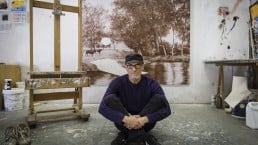
Including artist bios on your gallery’s website is an excellent way to engage readers and collectors, and to help you frame your gallery’s artistic focus and position the artists you represent. A good artist bio will inspire collectors to want to find out more about the artists and their work and lead them to keep browsing the artist’s works on your website. See the artist bios as your artists’ business cards – you want them to stand out, to provide all the essential information, and to convince collectors to become interested and, eventually, to reach out and buy works. Read on to discover how to write a stellar artist bio thanks to our 10 tips.
1. Create a concise summary
An artist bio should concisely summarise the artist’s practice. It’s not about covering an artist’s entire CV or full biography. Focus on a few main points that you believe to best introduce the artist and their art. Always include the medium, themes, techniques, and influences the artist works with.
2. Use clean, simple language
Use clean, simple language and avoid academic jargon and exaggerated language. Readers respond to authentic, simple texts and will take you much more seriously than if you use over-embellished language.
3. Grab the attention with a creative first sentence
Try to start the bio with a first line that is not simply a standard biographical introduction. Instead, be more creative and write a first sentence that grabs your readers’ attention while also telling them what is the most important thing about this artist and their work.
4. Include the artist's date of birth and nationality
Always add the date of birth (and in the case of artists who have passed away, the date of death) and the nationality of the artist. Also mention where they are mainly based – readers are interested in knowing where an artist is living and working, as this adds to a certain understanding about the artist’s influences and way of working.
5. Keep the bio around 120 words
The bio should be between 80 and 140 words. An ideal artist bio is 120 words. Research at museums has shown that visitors lose interest in reading wall labels accompanying art works after 150 words. That’s why it’s better to limit your word count to around 120 words – your readers will get enough information and be curious to learn more on their own, without getting bored and leaving your page because they don’t want to read an unnecessarily long text.
6. Discuss medium, techniques and style
Include all the important tangible aspects of the artist’s practice including: the medium and techniques the artist uses and the artistic style. Give examples of the artist’s key works that clearly elucidate these qualities.
7. Describe the main themes
Describe the main themes which the artist depicts in the work. What are the subjects and issues that inspire the themes in the artist’s pieces?
8. Position the artist in art history
Briefly reflect on the artist’s position in art history. What makes this artist important, what impact does he or she have on the history of art, which artists have influenced this artist and in what way has the artist redefined a certain medium or artistic technique?
9. Place the artist in his/her specific context
Position the artist in his or her cultural, political, social or technological context. Consider which events and which influences from the artist’s background and everyday life influence the way they work, and the art they produce.
10. Add a relevant quote
If you can find a short, relevant quote from the artist which supports the above-mentioned points, it can be a nice touch to add this to the bio in order to make it stand out more as an engaging, original piece.
Follow our ‘Gallery’s Guide’ series for more useful tips and strategies to improve your gallery’s online presence and business.
Get an individual session with an online strategy specialist
Get up to an hour free sparring with an specialist in online strategy and start improving your gallery's online presence and drive sales online. let us know which area you need help with an we find the right ones to help..
Art Gallery / Dealer Artist Art Fair Auction House Design Gallery Institution / Museum
The advisor service is FREE
Learn more about being a partner with artland, learn how we can help to improve your online activities as a gallery and get free sparring with our team to start improving your gallery's online presence and drive sales online..
- Apple IOS App
- Android App
- Coaching & Mentoring
- Success Stories
- Graduation 2024
- Beginner Art Program
- Oil Painting Essentials
- Portrait Painting Essentials
- Drawing Essentials
- Mixed Media Essentials
- The Young Artist Program
- All Art Courses
- How to Paint a Portrait in Acrylics
- Acrylics Remastered
- How to Create an Acrylic Floral Painting
- How to Create an Abstract Floral Painting
- Acrylic Painting Made Easy
- Oil Painting Simplified
- All Masterclasses
- Our Reviews
- Free Mini Courses
- Media & PR
- Milan Art Store
- Milan Art Gallery
How to Write a Professional Artist Bio
Crafting the right documents to showcase your work as an artist is essential for your professional journey and knowing how to sell your art .
It’s not just about listing your accomplishments—it’s about telling your story and articulating your vision in a way that resonates deeply with your audience. Whether you are applying to be in one of your local galleries, trying to be accepted for a public art commission, or even looking to sell your art online or at art fairs, you'll need to create documents that effectively convey who you are as an artist and what your work represents.
A strong artist bio, along with a compelling artist statement, CV, and resume, not only supports your applications but also plays a critical role in attracting potential buyers and collectors. These documents act as a bridge between you and your audience, helping them understand the person behind the art.
At Milan Art Institute, we believe that your voice is unique, and it deserves to be presented in a way that resonates with your audience. Your story is your strength, and it’s what will draw people into your work.
In this guide, we’ll explore how to write and craft a professional artist bio that truly reflects who you are and what your art stands for, ensuring you leave a lasting impression.
What is an Artist Bio?
An artist bio is more than just a summary of your artistic career; it’s a brief, powerful narrative that introduces you to your audience—whether they are curators, gallery owners, or art collectors.
It is your first opportunity to connect on a personal level, giving readers insight into what inspires you and how your artistic journey has evolved over time.
Your bio should convey the essence of your artistic practice, offering a glimpse into your inspirations, process, and achievements. Think of it as the story of your artistic journey, told in a way that captivates and resonates with those who encounter your work.
It’s about creating that emotional connection with your audience and allowing them to understand your motivations and vision on a deeper level.

Why Your Artist Bio Matters
When you sit down to craft your artist bio, remember that this is so much more than just a piece of writing—it’s a reflection of your unique journey and the vision that fuels your work as an artist.
Your bio is the first introduction to your audience, a way to invite them into your world and give them a glimpse of the passion that drives you to create. It helps establish a relationship between you and your audience, creating a narrative that not only showcases your accomplishments but also reveals the deeper meaning behind your work.
One of the most powerful elements of your bio is your power statement—a clear, compelling declaration of what makes you and your art unique. This statement should encapsulate your superpower as an artist, that special quality or perspective that only you bring to the table.
It’s this superpower that resonates with others and draws them into your creative journey. Your story is what sets you apart; it’s the essence of who you are as an artist, and it’s what makes your art connect on a deeper level with those who experience it.
Your bio becomes the vehicle through which your audience gets to know not just your work, but also the heart and soul behind it.
If you’re looking for inspiration on how to articulate your journey and harness your superpower, listen to our Light Movement Podcast episode on “Transforming Pain into Creativity ” with Story Worthy author Matthew Dicks. It’s a powerful reminder that your experiences—especially the painful ones—can become a source of strength and creativity, and your bio is where you can start weaving that narrative of your power statement.
The podcast explores how every story, including your own, has the potential to transform the way others view your art and connect with your journey.
What Does an Artist Bio Include?
A compelling artist bio typically covers the following key elements:
- Introduction : A snapshot of who you are as an artist—your name, medium, and the themes or ideas you explore in your work.
- Background : A brief overview of your education, training, and any pivotal experiences that have shaped your path as an artist. This section offers the foundational context that informs your work and provides insight into how your journey has unfolded.
- Artistic Influences : Insight into the artists, movements, or personal experiences that have influenced your work. By sharing your influences, you provide your audience with a deeper understanding of the aesthetic and conceptual decisions you make.
- Exhibitions and Awards : Highlights of your key exhibitions, awards, and recognitions that establish your credibility. These achievements underscore your growth as an artist and validate your work in the eyes of collectors and galleries.
- Current Work : A description of your current projects or the direction your art is taking right now. Keeping your bio up to date with your most recent work gives your audience a sense of where your art is headed and keeps them engaged in your ongoing journey.
- Conclusion : A closing statement that might include your artistic philosophy, future goals, or upcoming projects. This is where you tie everything together and leave your audience with a lasting impression of your mission and vision as an artist.

How to Write an Artist Bio
Crafting an artist bio is an art in itself. It requires you to be concise, have clarity about yourself and your work, and most importantly, be authentic. Here’s how you can create a bio that speaks to the heart of your artistic journey:
Start with Your Introduction : Begin with a clear and concise statement about who you are, what medium you work in, and what themes or concepts drive your art. This is your chance to make a strong first impression and set the tone for the rest of your bio.
Example : "Jane Doe is a Los Angeles-based mixed-media artist whose work delves into the intersection of nature and human experience."
Provide Context with Your Background : Share your educational background, any formal training, and significant experiences that have influenced your growth as an artist. By doing this, you paint a fuller picture of your journey and allow your audience to better understand the evolution of your artistic practice.
Example : "With a BFA from the Art Institute of Chicago, Jane’s work has been deeply influenced by her travels across Asia, where she immersed herself in the study of traditional and contemporary art forms."
Discuss Your Artistic Influences : Mention the artists, movements, or life experiences that have shaped your artistic vision. This adds depth and context to your narrative, showcasing how your influences inform the choices you make in your work.
Example : "Drawing inspiration from the raw textures of Anselm Kiefer and the spiritual depth of Mark Rothko, Jane’s work is a meditation on the beauty and fragility of life."
Highlight Your Achievements : Include notable exhibitions, awards, residencies, or other recognitions that underscore your experience and credibility as an artist. Achievements not only lend authority to your bio but also demonstrate your dedication and success in your field.
Example : "Jane’s work has been exhibited in prestigious galleries across the U.S., and she was recently awarded the Artist of the Year title at the Baltimore Potters Guild."
Describe Your Current Work : Give your audience a glimpse into what you’re currently working on or the direction your art is taking. Keeping your bio current with your most recent projects ensures that it remains relevant and reflective of your current creative pursuits.
Example : "Currently, Jane is exploring the concept of impermanence through a series of sculptures made from organic materials that decompose over time."
End with a Personal Touch : Conclude your bio with a statement that encapsulates your artistic philosophy and what you hope to achieve through your art, or introduce your power statement. This final touch allows your audience to connect with you on a more personal level and provides a sense of closure to your narrative. You can also mention any upcoming projects or exhibitions.
Example : "Through her work, Jane seeks to create a dialogue between the viewer and the natural world, inviting contemplation and connection in an increasingly disconnected world.”

Your Story is Worth Telling
As you write your artist bio, consider exploring art-related books for inspiration and insights.
Whether it’s an artist’s biography, a guide on professional practices, or a creative writing book for artists, these resources can enrich your perspective and help you articulate your story more effectively. They offer practical tips and examples that can make your bio more compelling and true to your vision.
Embrace the process with confidence and authenticity. Remember, writing about yourself may feel daunting at first, but it’s an essential skill for your professional journey.
Overcome your fear of failure. Whether you're just starting out or have years of experience, your voice matters, and your story is powerful. As you continue to grow and evolve as an artist, your bio will evolve with you, becoming a living testament to your artistic journey.
So, take a deep breath, trust in your creativity, and let your story shine through every word you write. Your art has the power to inspire, and so does your story.
Milan Art Institute
Related articles.

Tips on How to Write an Engaging Artist Bio

Whether for galleries, exhibitions, or your portfolio website, an artist bio is a valuable asset that introduces your creative career and provides context to curators, viewers, or potential buyers. Besides the artist statement the first person, the bio is written in the third person and tells how you evolved as an artist, your accomplishments, credentials, and your creative journey. The statement and bio complement each other and form a complete picture of your work and personality, creating a sense of trust and connectivity with the reader.
To craft a compelling artist bio, we can use techniques and tools from professional wordsmiths. After all, authors and copywriters are experts in selecting words that work.
One go-to resource for every professional selling with words is “The Copywriter’s Handbook by Robert” W. Bly. While the author doesn’t specifically detail how to write an artist bio, it offers numerous principles for compelling copywriting that we can apply to the artist bio. Here are some key principles from the book, followed by examples generated with the help of Open AI’s GPT-4 to illustrate.
Know Your Audience
Before you write your bio:
- Consider who will read it. If you write it for a specific gallery exhibition, for example, you might want to attract potential buyers. Your artist bio is never set in stone but changes depending on the occasion and the audience.
- Put yourself in their shoes.
- Remember buyers from the past and what they said about your art. Why did it appeal to them?
Engage Immediately
The first two sentences of your bio decide if potential buyers will continue until the end. So, it’s crucial to engage them from the get-go. Start with a hook: Introduce a question or conflict that defines your artistic work. To get a basic idea, here are two rough examples:
- Is it possible for discarded materials to carry hidden stories waiting to be retold? Laura Whitmore believes so. Every forgotten photograph, frayed piece of cloth, or rusted key has a memory of the past within it.
- Do coffee stains become planets or mysterious galaxies in your imagination? For digital illustrator Nina Hayashi, everyday spills and splotches are the start of her cosmic adventures on digital canvas.
Amplify Benefits over Features
One golden copywriter rule is always to translate features into benefits. Benefits speak directly to the emotional needs or desires of the reader. They answer the question, “What’s in it for me?” This emotional resonance is far more persuasive than simply listing features. Let’s take a look at an example to clarify:
Focus on features:
Alice Williams is a professional photographer who specializes in landscape photography. She uses a Canon 5D Mark IV and has been published in National Geographic, Time Magazine, and The Guardian. She’s traveled to over 50 countries to capture her shots.
Focus on benefits:
Alice Williams offers viewers a ticket to unseen corners of our world. Her lens reveals the breathtaking beauty of landscapes that most can only dream of. Published in renowned media outlets like National Geographic, Alice doesn’t just take photos; she crafts stories of nature and culture, making viewers feel as if they’ve traveled to over 50 countries with her.
Use Clear, Simple Language
Especially when falling into the trap of using the so-called International Art English, a lot of text that appears in museum press releases or gallery exhibitions sounds rather pretentious than engaging. Clear and concise language helps you better communicate your ideas and values to connect with your audience.
Artspeak-Example:
"In Alexander Smith’s latest oeuvre, there’s an undeniable juxtaposition of postmodern disillusionment with the pre-Raphaelite celebration of nature. The ephemeral quality of his brushwork, combined with a chiaroscuro technique, evokes a dichotomy between the ephemeral and the eternal. "
Simple language:
From the first brushstroke, Jane Smith transports you directly into the serene countryside or chaotic cityscapes. With each painting, you don’t just see a location—you experience it. Jane doesn’t merely showcase her technique; she delivers a passionate visual journey inspired by her global travels.
Be specific
Specific information and facts are more credible than vague language. By stating numbers and details, you capture the reader’s attention. For example:
“Jane has showcased her work in over 20 international galleries, including the Louvre and the Metropolitan Museum of Art,” is more convincing than “Jane has showcased her art in various galleries.”
Use active tense
Many writing guides and styles, especially in journalism and academic writing, encourage active voice over passive voice, as it benefits the clarity and conciseness of your artist bio. It also fosters a more dynamic rhythm and speaks directly to the reader.
Passive voice:
Born in the coastal town of Riverview, artistic passion was discovered early by Alex Gray. A rich tapestry of marine life and sun-bleached landscapes are portrayed in his artworks.
Active voice:
Born in the coastal town of Riverview, Alex Gray discovered his artistic passion early on. His artworks portray a rich tapestry of marine life and sun-bleached landscapes.
Provide a call to action
Finally, close with a call to action. What do you want your readers to do? Visit your gallery exhibition? Get in touch on social media? Check out your portfolio website? Tell them the next steps. For example:
Experience the world through Aria’s eyes. Visit her latest exhibition, “Whispers in Color,” now at the Genesis Gallery until December 15th.
Artist bio example from start to finish
Engage Immediately: Since her childhood in Barcelona, Aria Mendez has been spellbound by the world around her. Every street corner, every shadow, every forgotten artefact became a canvas for her imagination.
Show Benefits: Her artwork isn’t just to be gazed upon; it’s an invitation. Viewers don’t just see her art—they experience it. It connects, evokes emotion, and provokes thought, turning passive onlookers into engaged participants.
Use Clear, Simple Language: Aria paints, but she tells stories more than that. With each stroke, a tale unfolds, capturing moments, emotions, and memories.
Offer Specifics: Having showcased in over 40 exhibitions globally, Aria has left her mark from the Tate Modern in London to the Museum of Modern Art in New York. Her signature style—a blend of realism infused with abstraction—has earned her numerous accolades, including the Prestigious Art Innovator Award in 2022.
Provide a Call to Action: Experience the world through Aria’s eyes. Visit her latest exhibition, “Whispers in Color,” now showing at the Genesis Gallery until December 15th.
This text was created in collaboration with Open AI’s GPT-4.

Power Up Your Creative Process
Are you stuck in a creative rut? Here we’ll guide you through the creative process, exploring the different steps

How to Write an Artist Statement
What is the artist statement all about? When do you need it? And most importantly, how do you write one?
Great! You’ve successfully signed up.
Welcome back! You've successfully signed in.
You've successfully subscribed to The Overview.
Your link has expired.
Success! Check your email for magic link to sign-in.
Success! Your billing info has been updated.
Your billing was not updated.

How to Make the Most of Your Artist Bios: The Essential Guide for Galleries
It’s important to make the most of your artist bios. If they’re both well-written and used effectively they can also be a great tool for your digital marketing strategy.
An effective artist bio is a great way to introduce and engage collectors in an artist’s work. Unlike an artist statement or CV, it is usually a concise summary about the artist and their work. A good artist bio will provide the collector with enough information to make them want to learn more, without overwhelming them with too much detail. It’s important to make the most of your artist bios. If they’re both well-written and used effectively they can also be a great tool for your digital marketing strategy.
Read our guide below for all you need to know about writing the perfect artist bio and how to incorporate it into your marketing strategy.

What Things Should You Consider to Write an Effective Artist Bio?
Use this list below as a helpful guide when writing your artist bios. Don’t worry about including every item on the list, in some cases, some criteria may not work depending on the artist. Use this as a guide to figure out what works best for your gallery and artists.
The Length of the Artists Bio
The length of your bios should be no more than 150 words. As mentioned before, the artist’s bio is a concise summary, not a detailed list of the artist’s exhibition history and achievements. Why should you stick to a 150 word cut off? An article by Artsy notes that museum studies on audience engagement have shown that anything longer than 150 words does not keep the reader’s attention. Note that is the recommended maximum length so if you keep your bios shorter, 80-100 words, that works too. It’s best to keep them succinct and to the point, rather than adding too many embellishments.
Craft an Engaging First Sentence
The first sentence is the most important part of the bio. It’s where you grab the reader’s attention and make them want to learn more. Spend time crafting an engaging first sentence. Try to open with a sentence that summarizes the artist’s work and states what is most important about them, rather than opening with biographical information.
Readability
The user experience is important to keep in mind. It seems simple, but there are plenty of published artists’ bios that are unpleasant to read.
Confusing layouts, ugly font, hyperbolic praise, artspeak, too much information in one place: they all add up to a cluttered and irritating experience for readers.
Keep it clean and simple. You may want to try to fit a lot of information in, but don’t get too bogged down in details or flowery language. Keeping it short and to the point will make sure it’s readable and friendly for your audience.
Educate First Vs the Hard-sell
Describe the artist’s work. To do this, focus on their medium technique and style. As well as the subject matter or main themes of their work. You can also include information that may not be too obvious from images of their work, like further insight into their method or process. Try to highlight what sets them apart and what is significant about their work. You can also include where they draw their inspiration from.
If possible, position the artist and their work in the context of art history, by time period, or art movement. Or you can place the artist in a wider cultural context. This could be specific to the political, social, or technological climate that they work in.
Engage the Audience With Artist Quotes
Include a quote by the artist, if it’s relevant and it adds substance to any of the topics listed above. However, don’t include it as filler content just to add length to the bio.
Stay up to date on the latest from ARTERNAL
Most common artist bio mistakes to avoid, lengthy artists bios .
Avoid writing bios that are too long and have too much information about the artist’s CV, awards, and exhibition history. However impressive the information may be, long lists are a good way to lose your reader’s attention, it’s best to keep it short and to the point. You could always highlight a single notable award or exhibition, but careful not to go overboard.
Spelling and Punctuation
Avoid spelling and grammar mistakes. Proofreading is important. We recommend having at least one or two other eyes review your bios. Mistakes are easy to make, especially when you’re close to the material. But missing these simple errors can diminish your gallery’s reputation and authority. Don’t underestimate the value of a good proofreader.
Out of Date Artists Bios
Make sure to keep your bios up to date. Avoid outdated bios by regularly checking them, once a year or so, to be sure they have the most up to date information. This is also an easy mistake that can damage your gallery’s credibility. This is especially important if you work with talented emerging artists.
How Can Artist Bios Help Your Digital Marketing Strategy?
Now that you know the foundation of how to write a great artist bio, it’s time to make the most of them and incorporate them in your larger digital marketing strategy.
SEO and Artists Bios
One important factor to consider is SEO or search engine optimization. SEO is defined by Moz as “the practice of increasing the quantity and quality of traffic to your website through organic search engine results.” In other words, producing quality content in a way that search engines recognize as valuable to your audience so you rank higher in searches. A well-written bio with SEO in mind can help your gallery website continue to rank for keywords and search terms over time. So when writing your artist bios, think about what terms your audience will be searching for and incorporate those keywords into your bios. Keywords could include the artist’s name, subject matter, medium, or style of work.
Backlinks from Artists Bios
Along with using relevant keywords in your artist bios, another SEO factor to consider is link building. Search engines recognize your website as more important when reputable websites link to your website (also called backlinks). This, in turn, will also help you rank higher and get more organic traffic. To accomplish this start building relationships with organizations that you want links from. When it comes to backlinks, quality is more important than quantity.
You can also use internal links to help with your SEO strategy. Link keywords or phrases in your artists’ bios to other pages on your website, again only if relevant. Moz offers a detailed beginners guide if you’d like to learn more about link building.
Use Social Media and Digital Tools to Share Your Artist Bios and Track Engagement
Social media strategy and artists bios .
Work with your artists and make sure that you’re on the same page when it comes to posting on social media. This way your social media initiatives will be mutually beneficial. When artists post about their work, it’s important they tag your gallery in the body of the post as well in the image they post. This will help drive traffic to your gallery website where you can engage with clients and continue conversations.
After your artist bios have been published make sure you’re set up with Google Analytics to track website engagement. Google Analytics collects and records user data so you can see what’s working and what areas might need improvement on your website. With Google Analytics you can find out which content or artists are performing best, how your visitors are finding your content, and information about your visitors. Check out expert digital marketer, Neil Patel’s blog to learn more about Google Analytics and how you can make the most of this free service.
Advanced Social Marketing Strategies with Artists Bios
The new battleground for galleries working with artists is the artist’s social media profile bio page. It’s now some of the most valuable real estates in the digital world.
Influencer marketing is a powerful strategy for galleries to use with their artist bios. Andrew Chen, a startup growth expert, mentioned that “Whoever controls the link controls the business model for the new economy that’s being built.” Once a gallery has established a mutually beneficial relationship on social media with the artists, they can create a pseudo influencer marketing program that can treat artists as influencers and give galleries how to measure each artist’s Social Media ROI.
Let’s dive into this in more detail. Here’s a screenshot of Andrew Cranston social media profile.
If we look at the link on his profile we can see it’s from INGLEBY Gallery. Upon clicking on the link it goes into Andre Carnston’s artist bio on their gallery webpage.
Andrew has linked his social media profile to his artist bio from INGLEBY. Every time Andrew makes a post and viewers click on his profile link, the gallery is getting more exposure. This is an actionable strategy most galleries can put into action. Establishing an influencer marketing program with your artists is a great way to grow your following.
You can take your Google Analytics to the next level by using UTM Parameters to see which individual artist brings the most traffic from social media. Check out Neil Patel’s blog article on UTM Parameters to learn more.
Examples of Artist Bios
If you need more inspiration, before you start writing your artist bios, check out a few examples of our favorites on Artsy:
Jean-Michel Basquiat
Yayoi Kusama
Kehinde Wiley
Sophie Calle
You might also like these articles:
- How to Make Smart Investment that Increases Art Sales
- Settling into Click-and-Mortar: The New Prime Real Estate
- The Art Gallery Business Model Needs to Change – Let’s Discuss
Interested in taking your gallery to the next level? Contact us today to learn more.
Dive into the world of ARTERNAL
Arternal has a new look.
We’re still the same ARTERNAL, just with more space to grow....

How Anti-Money Laundering Regulations Will Help Democratize Art Collection
Anti-money laundering (AML) regulations might help increase transparency by demanding galleries to list their prices. This would help…...

Get Your Head in the Cloud. The Art Game has Changed.
Fully vertical cloud-based - inventory management, sales workflow, relationship management and payment processing is integral to the new…...

Selling Art Isn’t About Working Harder… It’s About Working Smarter
CRM software gives you the tools that you need as a dealer to understand the economics of your…...

The ARTERNAL All-in-One Experience for the Art Dealer
We spent the last three years perfecting the ARTERNAL experience to provide our clients and art dealers with…...

How Sales Tools Increase Revenue for Galleries
Sales tools are the technologies that sales professionals use to carry out and streamline their activities to close…...

The Delicate Dance Between Marketing and Sales: A Guide for Art Galleries
Has the art world been spending too many resources on marketing and not enough on sales strategies? How…...

Inventory Management: Streamlining Art Galleries
Learn about the pivotal role of inventory management in enhancing the efficiency and success of art galleries....

Art Gallery CRM: Enhancing Customer Engagement & Loyalty
Learn about the important role of Collector Relationship Management systems in art galleries. Discover how they can strategically…...

Art Gallery Inventory Analytics: Optimizing Collections
In the dynamic world of art galleries, the emergence of data-driven art curation marks a significant shift in…...

Art Gallery CRM: Transforming Client Relationships
Learn about how Collector Relationship Management systems transform collector relationships in art galleries. Discover the strategic impact of…...

Get Your Music Heard and Accelerate Your Career
Artist biography example: how to convince in a few lines.
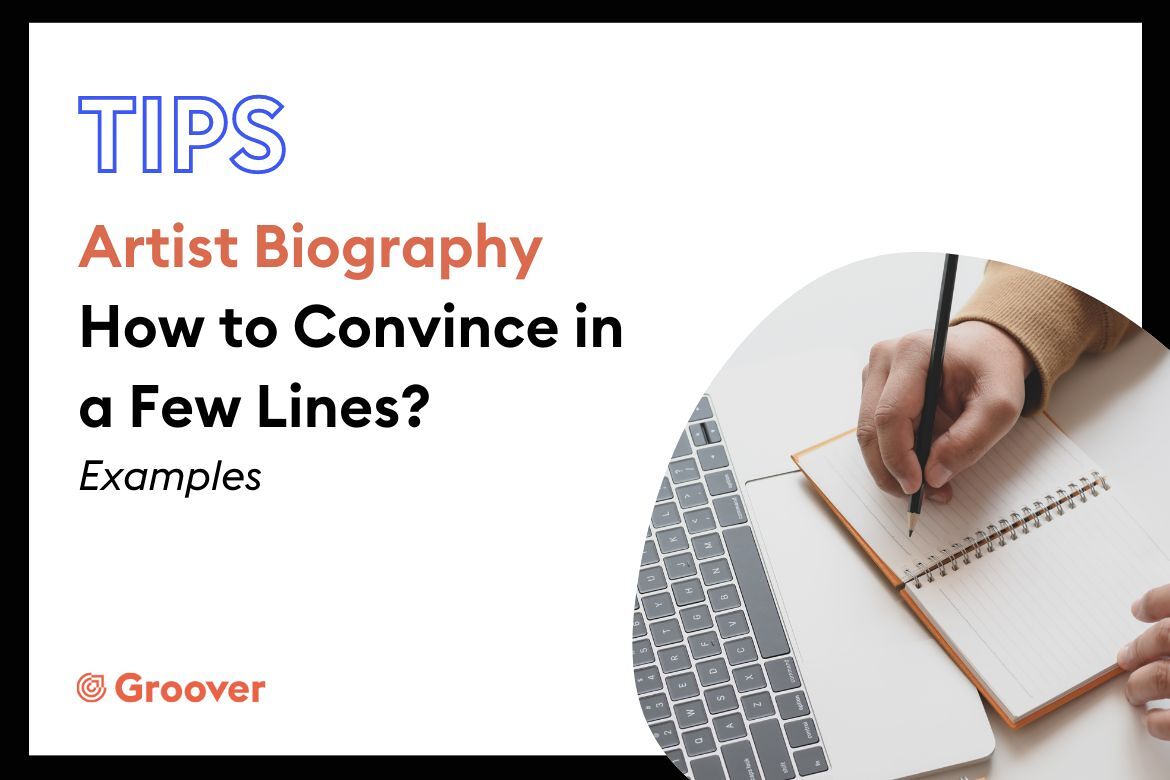
It’s not always about the music. An artist or band has a story to tell. A story about how they got from A to B. How they had a vision of what they wanted to say and how they wanted to say it. With a band or an artist biography , you’ve got to convince the reader in a few lines why they should listen to your music , buy your music, and come to your shows . Easy right?
So you’ve written a bunch of songs, played a few shows, and started to get a name for yourself. So what next? Time to write your artist biography, because after all, people want to know your story. And sometimes you have to convince them in a few lines why your music is important to them. So how do you do that? How do you write an effective artist biography and improve your musical status so that you’ll convince people you’re the next big thing? Read on my friend.
Are you looking to get your music heard? ⬇️

1. How to write a Good Artist Biography?
We’ll break this section up into easy parts so you know what to put into your artist or band biography. You don’t have to be an expert writer either. Getting it right is like following a cake recipe. With all the right ingredients, in the right order, you’ll have a top-class biography.
This will change as you progress. It’ll get smoother and easier to write as you live your story. Following these steps will help you write your artist biography.
You’ll have to Write at least Three Biographies
Don’t panic, you’re not going to write three different stories . One story only. In various lengths.
- Start with the hardest. The big one. The full-length biography. Depending on your story this can be anything from around 750 to 1000 words. Perfect for your website or in your record sleeve.
- The second should be a medium-length biography. Shorten your main one to around 500+ words with the relevant points. Perfect for promoters, emails, press releases, labels, etc
- The last one should be around 100 to around 200 words which are the one for social media. Your best points in one or two paragraphs.
Write a Paragraph for Each Section
For each section of your artist biography, write a paragraph for each. This will make it easier for your reader to get what you’re about and learn about you as a band or artist.
Need help writing your biography?
👉 The editorial team at Groover can take care of it for you 👈
2. Biography Structure
2.1 intro paragraph.
This is the killer line. The definitive opener that hooks your reader into your band or artist biography . You need a well-written engaging introduction to hook your reader in. If you’re starting out, take a couple of bands or artists that you sound like or admire and put them together. Fleet Foxes meets the Black Keys at a hotel and parties. Or Self Esteem and Freddie Mercury’s adopted child take the musical reigns. Instantly, with this brief description, you’ll know how the music sounds. Try it yourself.
Once you’re further into your musical career, you might have a quote from a music journalist or another artist that makes you sound amazing. Use that as an opener.
| Also read: How to contact music media outlets, blogs, journalists with Groover
2.2 Give them some Background
How did it start? Was it a bunch of mates at the pub wanting to change the world? Perhaps you had the vision to turn music into art.
Follow your opening paragraph and write about the history of how you started out. With a background on how you got to where you are now. Also, make it interesting.
‘We got together over a few pints is a little boring. ‘After one crazy night of drinking and indulgence, we decided to change the world with our music’ sounds better.
2.3 Make sure you Mention your Achievements
Anything that you or your band achieves make sure you sing it out loud. Whether to highlight a favorable album review, a sold-out show at a popular venue, or a warming interview. Gently insert your accomplishments into your biography. People love to hear their favorite band or artist doing well.
2.4 Quotes and Testimonials
Hopefully, as a musical performer, you should be sparking the interest of your peers. Bloggers that love your album or a local radio DJ that keeps playing your songs. See if you can get a few quotes or a testimonial from their blog posts or radio mouths. And drop it into your bio. In the beginning, it might only be a local music blogger. As you progress through your career, you should collect more quotes and testimonials from the music-industry folk. Any influencers, radio DJs, promoters, and anyone that’s in the music industry wanting to praise your musical venture.
2.5 Keep your Information Up-to-date
The great thing about bios , especially if they’re online or a regular slot on your socials. Is that they can be frequently updated. In the last paragraph of your biography, you should talk about new shows, records, and events. You should climb the nearest hill and shout about any new gig or radio interview. Include anything significant. From local radio play to a blog that sings your praises.
| Also read: How to get your songs successfully on the air
3. Artist Biography Example Layout
To break it all down, you should set your biography like this. Into five easy paragraphs .
- Intro Paragraph
- Background and History
- Mention your Achievements
- Quotes and Testimonials
- Up-to-date Information
4. Best Artist Biographies Examples
Looking at popular band biographies there are a few that stand out. Take 90’s grunge phenomenon Nirvana . They have bullet points of the band’s history and timeline. Simple yet effective. Highlighting the band’s career highlights for all to see.
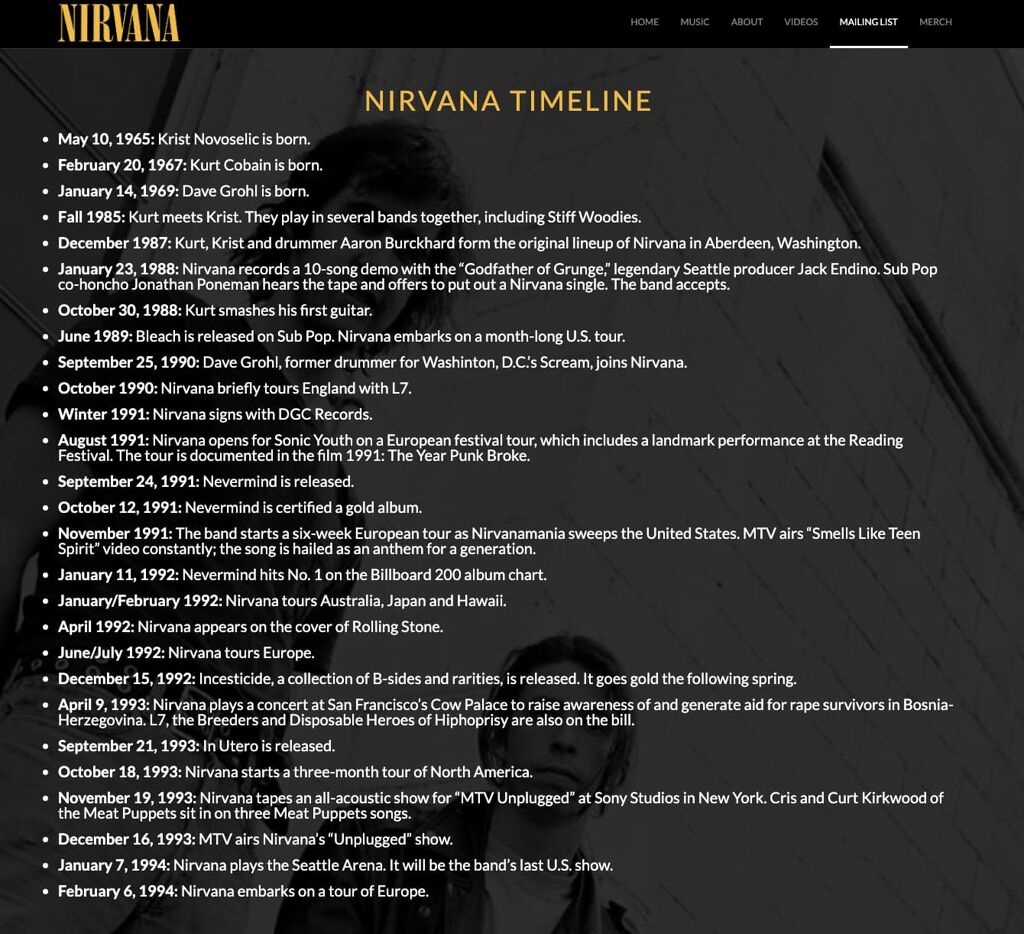
Electronic music pioneer ‘ The Funk Hunters ’ is a great example of a clean band biography. Intro hook, with history, achievements, and notable shows. A bit like my layout.
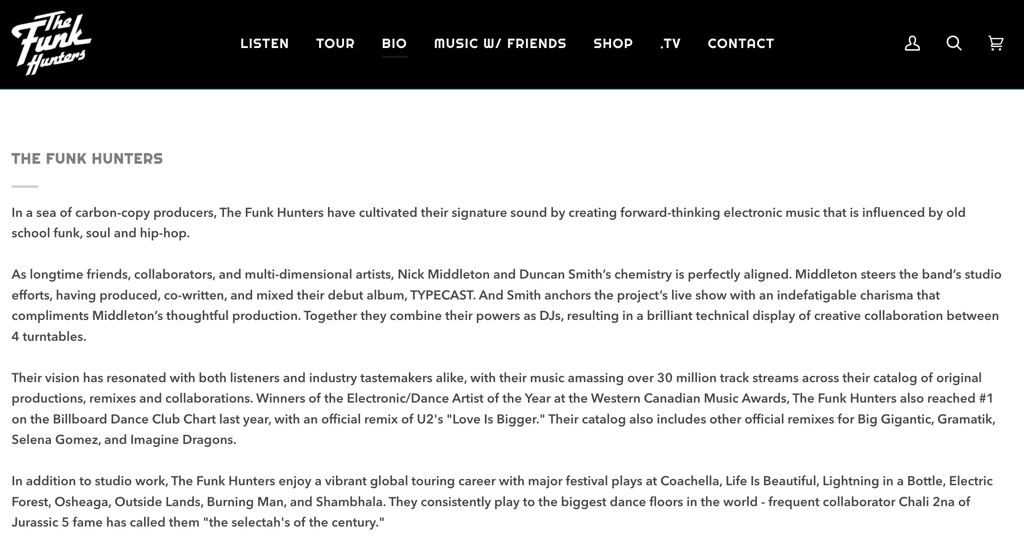
Hip Hop and 90’s Rave enthusiastic brothers, ‘ Everyone You Know ‘ has a nice little FAQ after a short bio . The FAQ leads you on a path to their music and videos. Nice.
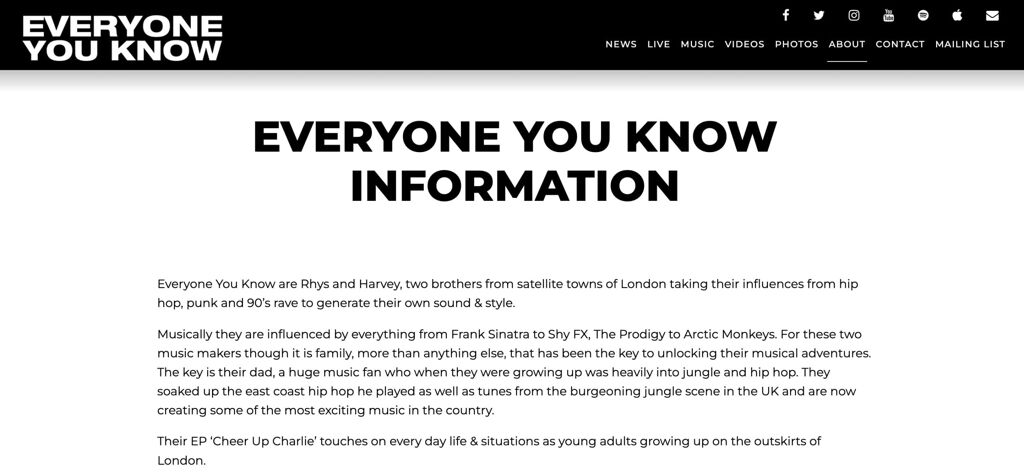
The main thing about creating an artist bio is that you make it interesting. No vanilla content. Make it snappy and readable. If you’re not a pioneer of words and don’t want to learn how to write effective hooky words then hire a copywriter to give it some pizazz. They can revise your bio if you’ve tackled the writing process . Even just getting someone to proofread your bio can make a difference. Experiment and don’t be constrictive. Bend the truth but don’t lie. And you’ll form the perfect biography.
Get your music heard 👇

Cameron Baxter
Cam Baxter has been in the music industry for at least 20 years. From humble beginnings in local bands, musical instruments and pro audio retail to playing on various stages around the UK. With plenty of knowledge in the music industry sector, Cam is a seasoned professional when it comes to all things musical. Now a prolific writer, Cam uses this knowledge to write entertaining and insightful music-related articles.
Why your Music needs a Radio Plugger
Promote after song release: attract more listeners, you may also like, how to break into rap, how to set up ableton for live performance, why and how to get constructive musical feedback, album release checklist: your comprehensive guide for a..., music promotion: how to promote your music online, how to get paid to be an artist, how to reach out to spotify rock playlist..., the best distribution tips from horus music, 5 mixing tips and tricks: how to make..., 4 content ideas to promote my music on..., laisse un commentaire cancel reply.
Save my name, email, and website in this browser for the next time I comment.

GET YOUR MUSIC HEARD
🔸 Connect with curators & music pros
🔸 Get added on playlists, featured by media outlets, broadcasted by radio stations…
🔸 Receive honest feedback on your music
🔸 Expand your audience
Begin your journey with Groover and enjoy a special 10% discount!

AI Generator
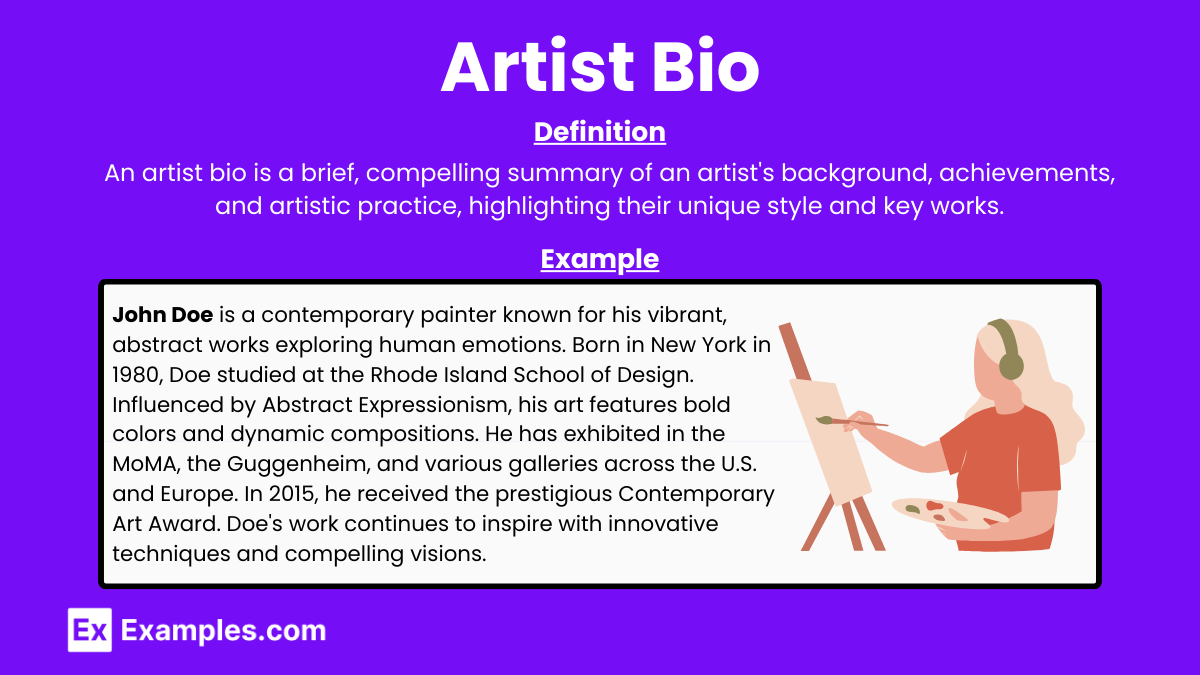
In the world of art , capturing the essence of an artist’s journey and creative expression is essential for connecting with audiences and potential opportunities. Crafting a compelling artist biography is a valuable tool that can open doors and provide insight into the artist’s background, inspirations, and artistic style. This article showcases a diverse range of 29+ artist bio examples, compatible with popular document formats like Google Docs, Word, PDF, and Apple Pages. Whether you’re an emerging talent or an established artist looking to refine your professional bio , this collection offers inspiration and guidance to help you create a captivating narrative that truly reflects your artistic identity.
What is an Artist Bio?
An artist bio, also known as an artist statement or biography, is a written document that encapsulates an artist’s professional journey and artistic vision. It serves as a concise overview of the artist’s background, achievements, inspirations, and artistic style. An artist bio acts as a powerful tool to introduce and contextualize the artist’s work, enabling viewers, curators, and potential collaborators to gain a deeper understanding of their creative process and motivations.
Format of Artist Bio
1. early life and education.
[Artist Name] was born on [Birth Date] in [Birth Place]. Growing up in [City/Town], [Artist Name] developed an early interest in art, influenced by [specific influences, family background, or events]. [He/She/They] pursued [his/her/their] passion by studying [Art/Design/Specific Art Form] at [Educational Institution], where [he/she/they] earned [his/her/their] [Degree] in [Year].
2. Artistic Style and Influences
[Artist Name]’s work is characterized by [describe the artist’s style, techniques, and mediums used]. [He/She/They] draw(s) inspiration from [influences such as other artists, movements, nature, personal experiences, etc.]. [Artist Name]’s art often explores themes of [specific themes, e.g., identity, nature, social issues], and [he/she/they] is known for [specific traits or techniques, e.g., vibrant colors, intricate details].
3. Career Highlights
Throughout [his/her/their] career, [Artist Name] has exhibited [his/her/their] work in various prestigious galleries and exhibitions, including [list notable galleries, exhibitions, and dates]. Some of [his/her/their] most significant works include [mention notable works and brief descriptions]. [He/She/They] has received numerous awards and accolades, such as [list awards, grants, recognitions].
4. Major Works and Projects
Among [Artist Name]’s notable projects are [describe major works, collaborations, or series]. [He/She/They] collaborated with [other artists/organizations] on [specific projects], which [gained significant recognition/impacted a certain community]. [His/Her/Their] works have been featured in [publications, media outlets], further establishing [him/her/them] as a prominent figure in the art world.
5. Personal Philosophy and Impact
[Artist Name] believes that [describe personal philosophy or approach to art]. [He/She/They] aim(s) to [describe goals or messages intended through the art]. [His/Her/Their] work has not only contributed to the art community but also [mention any social, cultural, or environmental impact].
6. Current and Future Endeavors
Currently, [Artist Name] is [working on new projects, exploring new mediums, teaching, etc.]. [He/She/They] continue(s) to push the boundaries of [his/her/their] art, with upcoming exhibitions at [mention upcoming exhibitions or projects]. [Artist Name] is dedicated to [mention any future goals or aspirations].
7. Conclusion
[Artist Name]’s journey as an artist is marked by [summarize key points of their career and impact]. [His/Her/Their] unique style and dedication to [specific aspects of their work] make [him/her/them] a notable figure in the contemporary art scene.
Jane Doe Introduction: Jane Doe, born on March 15, 1985, in New York City, is a contemporary painter known for her vibrant abstract landscapes. Early Life and Education: Growing up in a family of artists, Jane was exposed to the world of art from an early age. She studied Fine Arts at the Rhode Island School of Design, where she honed her skills in painting and sculpture. Artistic Journey: Jane’s career began with a solo exhibition at a local gallery in Brooklyn. Her work quickly gained attention, leading to numerous exhibitions across the country. Notable milestones include her participation in the Whitney Biennial and a residency at the Art Institute of Chicago. Style and Technique: Jane’s style is characterized by bold colors and dynamic compositions. She often uses mixed media, incorporating elements of collage and texture to create depth in her paintings. Her work explores themes of nature and human emotion. Achievements and Awards: Jane has received several prestigious awards, including the Pollock-Krasner Foundation Grant and the Guggenheim Fellowship. Her work is part of permanent collections at the Museum of Modern Art and the Los Angeles County Museum of Art. Current Work: Currently, Jane is exploring the intersection of digital art and traditional painting. She is preparing for a solo exhibition in Paris and collaborating with other artists on a public art project in San Francisco. Personal Insight: “I believe art is a reflection of the world we live in, and through my work, I hope to evoke a sense of wonder and connection to the natural world,” says Jane. Conclusion: Jane Doe continues to push the boundaries of contemporary art with her innovative approach and evocative works. Follow her journey on Instagram @JaneDoeArt or visit her website www.janedoeart.com .
Examples of Artist Bio for Students
1. high school student.
Alex Brown Introduction: Alex Brown, born on March 3, 2005, in Denver, Colorado, is a high school junior who loves painting and drawing. Early Life and Education: Alex has enjoyed art since childhood. They are currently studying at East High School and taking advanced art classes. Artistic Journey: Alex started sharing their artwork online in 2021 and quickly gained a following. They have won first place in the Denver Youth Art Competition. Style and Technique: Alex’s style is colorful and imaginative, using both traditional paints and digital tools like Procreate. Current Work: Alex is working on a series of paintings for a local gallery show and plans to study art in college. Conclusion: Alex Brown is a talented young artist with a bright future. Follow them on Instagram @AlexArt or visit their online portfolio at www.alexbrownart.com .
2. College Student
Mia Johnson Introduction: Mia Johnson, born on August 15, 2002, in Boston, Massachusetts, is a sophomore at Boston University, majoring in Fine Arts. Early Life and Education: Mia has been passionate about art from a young age. She excelled in art classes throughout school and is now pursuing her degree at BU. Artistic Journey: Mia’s work focuses on sculpture and mixed media. She has participated in university exhibitions and community art projects. Style and Technique: Mia uses recycled materials in her sculptures, creating pieces that explore environmental themes. Current Work: Mia is working on a series of sculptures for a campus exhibit and plans to apply for an art residency program. Conclusion: Mia Johnson is an innovative artist with a unique approach to sculpture. Follow her on Instagram @MiaSculpts or visit her website at www.miajohnsonart.com .
3. Graduate Student
Liam Chen Introduction: Liam Chen, born on June 10, 1998, in San Francisco, California, is a graduate student at the Rhode Island School of Design, specializing in graphic design. Early Life and Education: Liam discovered his love for design in high school. He earned his BFA from UCLA and is now completing his MFA at RISD. Artistic Journey: Liam’s design work includes branding, posters, and digital art. He has interned with top design firms and exhibited his work in several student shows. Style and Technique: Liam’s style is clean and modern, using bold typography and striking visuals. Current Work: Liam is developing a series of posters for his thesis project, exploring social issues through design. Conclusion: Liam Chen is a skilled graphic designer with a keen eye for detail. Follow him on Instagram @LiamDesigns or visit his portfolio at www.liamchenart.com .
4. High School Student
Sophia Ramirez Introduction: Sophia Ramirez, born on April 22, 2006, in Miami, Florida, is a high school sophomore who loves photography. Early Life and Education: Sophia started taking photos with her phone and quickly fell in love with photography. She attends Coral Gables High School and is part of the photography club. Artistic Journey: Sophia shares her photos on Instagram, where she has a growing number of followers. She has won awards in local photo contests. Style and Technique: Sophia’s photography captures everyday moments with a unique perspective, using natural light and creative angles. Current Work: Sophia is working on a photo series about her city for an upcoming school exhibit. Conclusion: Sophia Ramirez is a promising young photographer with a unique vision. Follow her on Instagram @SophiaShoots or visit her portfolio at www.sophiaramirezphotos.com .
5. College Student
Ethan Kim Introduction: Ethan Kim, born on November 5, 2001, in Seattle, Washington, is a senior at the University of Washington, majoring in Fine Arts. Early Life and Education: Ethan has always loved drawing and painting. He is now finishing his degree in Fine Arts and has taken many art courses. Artistic Journey: Ethan’s work has been featured in several student art shows and local galleries. He enjoys experimenting with different styles and mediums. Style and Technique: Ethan’s paintings are known for their vibrant colors and abstract forms. Current Work: Ethan is preparing for his senior thesis exhibition and plans to apply for graduate programs in art. Conclusion: Ethan Kim is a talented artist with a bright future in the art world. Follow him on Instagram @EthanPaints or visit his website at www.ethankimart.com .
Short Artist Bio Examples
1. visual artist: emily carter.
Emily Carter is a contemporary visual artist based in New York City. Her work explores the intersection of urban landscapes and human emotions, often incorporating mixed media techniques. Emily graduated with a Master of Fine Arts from the Rhode Island School of Design and has exhibited her pieces in galleries across the United States and Europe. She draws inspiration from the bustling city life, using bold colors and dynamic compositions to evoke a sense of movement and vitality.
2. Photographer: Michael Thompson
Michael Thompson is a professional photographer known for his breathtaking landscape and wildlife photography. Based in Denver, Colorado, Michael has spent over a decade capturing the natural beauty of the American West. His work has been featured in National Geographic, Outdoor Photographer, and numerous other publications. Michael’s passion for the outdoors is evident in his stunning images, which often highlight the delicate balance between nature and humanity.
3. Sculptor: Sophia Martinez
Sophia Martinez is a renowned sculptor whose work delves into themes of identity, culture, and transformation. Originally from Mexico City, Sophia now resides in Los Angeles, where she creates large-scale installations and intricate sculptures using reclaimed materials. She earned her Bachelor of Fine Arts from the University of California, Los Angeles, and her sculptures have been displayed in both solo and group exhibitions around the world. Sophia’s art challenges viewers to reflect on their own experiences and the world around them.
4. Painter: Alex Kim
Alex Kim is a contemporary painter based in San Francisco, California. His vibrant, abstract paintings are characterized by their bold use of color and texture. Alex holds a Bachelor of Fine Arts from the San Francisco Art Institute and has participated in numerous art residencies and exhibitions. His work is inspired by the natural world, music, and personal experiences, and he aims to evoke a sense of joy and contemplation in his viewers.
5. Digital Artist: Mia Liu
Mia Liu is a digital artist and illustrator from Austin, Texas. She specializes in creating imaginative digital artworks that blend reality with fantasy. Mia graduated with a degree in Graphic Design from the Savannah College of Art and Design and has worked with various clients, including tech companies, publishers, and indie game developers. Her art is known for its intricate details, vibrant colors, and whimsical themes, capturing the imagination of audiences of all ages.
Examples of Artist Bio for Music
1. singer-songwriter: olivia turner.
Olivia Turner is an acclaimed singer-songwriter hailing from Nashville, Tennessee. With a soulful voice and a knack for storytelling, Olivia’s music seamlessly blends country, folk, and pop influences. She began her musical journey at a young age, performing at local venues and honing her craft. After earning a degree in Music Performance from Belmont University, Olivia released her debut album, “Wandering Heart,” which quickly gained critical acclaim and a devoted fan base. Her heartfelt lyrics and melodic compositions reflect personal experiences and universal themes of love, loss, and self-discovery. Olivia’s performances are known for their intimate and emotional connection with the audience, creating unforgettable live experiences. She has toured extensively across the United States, performing at renowned venues and festivals. Olivia’s music has been featured on popular TV shows and playlists, cementing her place as a rising star in the music industry.
2. Jazz Musician: Marcus Bennett
Marcus Bennett is a talented jazz musician and composer based in New Orleans, Louisiana. Known for his virtuosic skills on the saxophone, Marcus has been a prominent figure in the jazz scene for over two decades. He studied Jazz Performance at the prestigious Berklee College of Music and has played with some of the biggest names in the industry, including Wynton Marsalis and Herbie Hancock. Marcus’s compositions are deeply rooted in the traditions of jazz, but he often incorporates elements of blues, funk, and contemporary music, creating a unique and dynamic sound. He has released five albums, each showcasing his innovative approach and technical prowess. Marcus is a regular performer at jazz festivals around the world and has been a featured artist at the New Orleans Jazz & Heritage Festival multiple times. His passion for jazz is evident in his energetic performances and his dedication to educating the next generation of musicians through workshops and masterclasses.
3. Pop Artist: Lily Brooks
Lily Brooks is a pop artist and songwriter from Los Angeles, California. Her infectious melodies and relatable lyrics have quickly made her a favorite in the pop music scene. Lily started her career as a teenager, posting covers and original songs on social media, which gained her a substantial following. She signed her first record deal at the age of 19 and released her debut single, “Echoes,” which became a viral hit. Lily’s music is characterized by its catchy hooks, polished production, and themes of empowerment and self-love. Her debut album, “Dreamscape,” topped charts and solidified her place as a rising pop star. Lily has performed on major television shows and at some of the biggest music festivals worldwide. With a strong social media presence and a dedicated fan base, Lily continues to push the boundaries of pop music while staying true to her artistic vision.
4. Classical Pianist: Elena Rossi
Elena Rossi is an internationally renowned classical pianist based in Vienna, Austria. She has captivated audiences with her expressive playing and technical mastery. Elena began playing the piano at the age of four and went on to study at the Vienna Conservatory, where she graduated with honors. She has won numerous international piano competitions and has performed in some of the world’s most prestigious concert halls, including Carnegie Hall and the Royal Albert Hall. Elena’s repertoire spans from Baroque to contemporary classical music, and she is particularly noted for her interpretations of Chopin and Rachmaninoff. Her recordings have received critical acclaim, earning her multiple awards and nominations. In addition to her performing career, Elena is also a dedicated teacher, sharing her passion for music with students around the globe through masterclasses and online courses.
5. Rock Band: The Midnight Riders
The Midnight Riders are a high-energy rock band from Austin, Texas. Comprised of four members – Jake (vocals/guitar), Sam (lead guitar), Mike (bass), and Alex (drums) – the band is known for their electrifying live shows and raw, authentic sound. Formed in 2010, The Midnight Riders quickly gained a loyal following in the local music scene with their blend of classic rock, blues, and modern alternative influences. Their debut album, “Road to Nowhere,” was a commercial success and earned them a spot on the national tour circuit. The Midnight Riders have since released three more albums, each showcasing their evolution as musicians and songwriters. They have shared the stage with major acts such as Foo Fighters and Kings of Leon and have performed at renowned festivals like Lollapalooza and SXSW. With their infectious energy and undeniable talent, The Midnight Riders continue to make waves in the rock music world.
Examples of Artist Bio for Painting
1. abstract painter: sarah reynolds.
Sarah Reynolds is an abstract painter based in Brooklyn, New York. Her vibrant and dynamic works explore themes of emotion and memory, using bold colors and intricate textures to create a sense of depth and movement. Sarah holds a Master of Fine Arts from the Pratt Institute and has exhibited her work in galleries across the United States and Europe. Her paintings invite viewers to embark on a journey of introspection and discovery, offering a unique perspective on the abstract art form.
2. Landscape Painter: Thomas Green
Thomas Green is a landscape painter from Santa Fe, New Mexico, renowned for his evocative depictions of the American Southwest. With a background in fine arts from the University of New Mexico, Thomas captures the beauty and majesty of the natural world in his detailed and atmospheric paintings. His work has been featured in numerous solo and group exhibitions, and he has received several awards for his contributions to landscape art. Thomas’s paintings are celebrated for their luminous quality and profound sense of place.
3. Realist Painter: Emily Harris
Emily Harris is a realist painter based in Boston, Massachusetts. Her meticulous and lifelike portraits and still lifes showcase her extraordinary skill and attention to detail. Emily earned her Bachelor of Fine Arts from the Massachusetts College of Art and Design and has participated in prestigious art residencies both in the U.S. and abroad. Her work has been exhibited in major galleries and is part of several private collections. Emily’s paintings capture the essence of her subjects with remarkable clarity and emotion.
4. Contemporary Painter: David Lee
David Lee is a contemporary painter from San Francisco, California, whose work explores the intersection of technology and human experience. Utilizing a mix of traditional and digital techniques, David creates visually striking pieces that challenge viewers to consider the impact of modern society on individual identity. He holds a degree in Visual Arts from the San Francisco Art Institute and has exhibited his work internationally. David’s innovative approach and thought-provoking themes make him a prominent figure in the contemporary art scene.
5. Impressionist Painter: Anna Martinez
Anna Martinez is an impressionist painter based in Austin, Texas. Inspired by the play of light and color in nature, Anna’s works capture the fleeting beauty of everyday moments. She studied fine arts at the University of Texas and has been featured in several national art shows and exhibitions. Her paintings are known for their expressive brushwork and vibrant palette, evoking a sense of warmth and nostalgia. Anna’s ability to convey emotion through color and light has earned her a dedicated following among art enthusiasts.
More Artist Bio Examples & Samples in PDF
1. resume template.
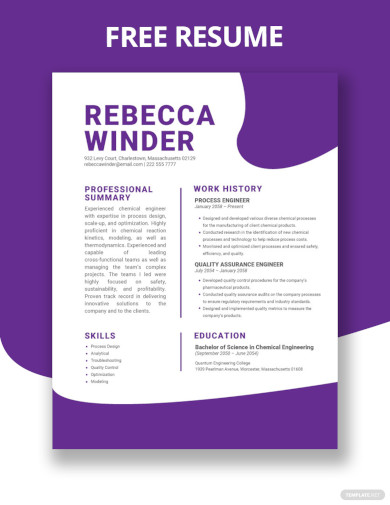
2. Student Bio Template
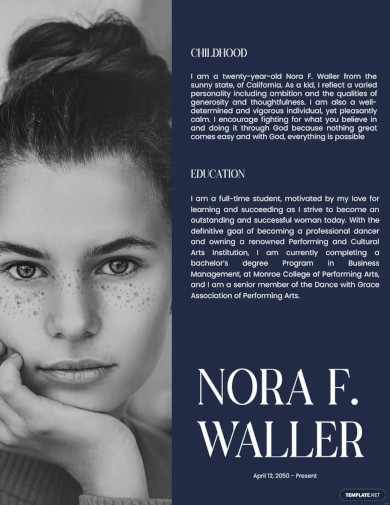
3. Biography Template

4. Creative Bio Template
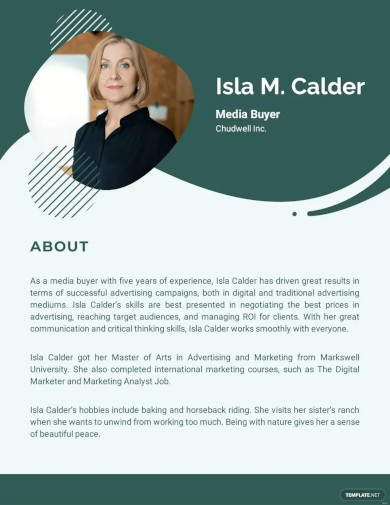
5. Short Artist Bio

6. Music Bio
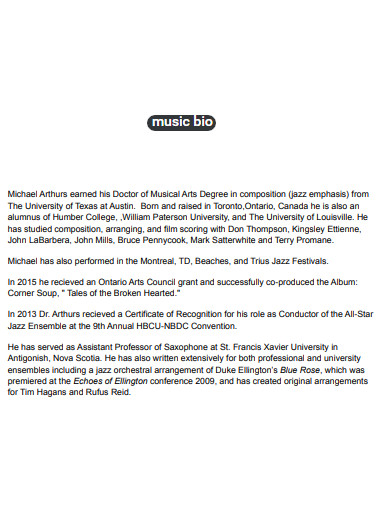
7. Student Bio
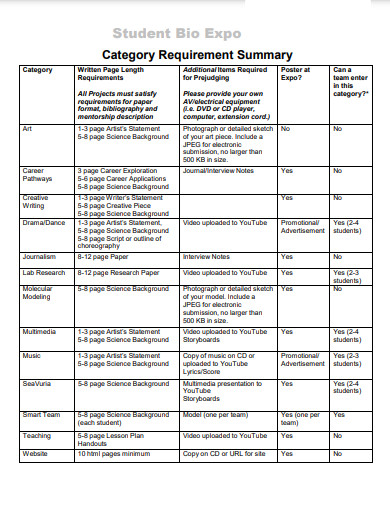
8. New Artist Bio

9. Singer Artist Bio
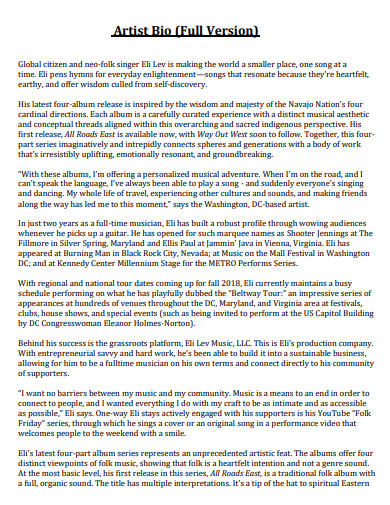
10. General Artist Bio
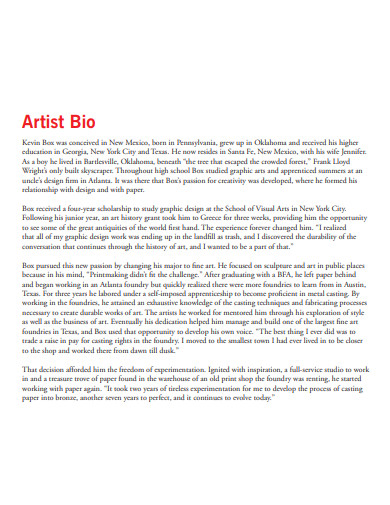
What to include in Artist Bio
An artist bio is an essential component of an artist’s portfolio, gallery, or exhibition. It provides a brief overview of the artist’s career, background, and achievements. Here are key elements to include in an artist bio:
1. Name and Medium
- Start with your name and the primary medium or mediums you work in.
- Example: “Sarah Reynolds is an abstract painter based in Brooklyn, New York.”
2. Location
- Mention where you are based.
- Example: “based in Brooklyn, New York.”
3. Educational Background
- Include any relevant education or training in the arts.
- Example: “Sarah holds a Master of Fine Arts from the Pratt Institute.”
4. Artistic Style and Themes
- Describe your artistic style and the main themes you explore in your work.
- Example: “Her vibrant and dynamic works explore themes of emotion and memory.”
5. Career Highlights
- Mention key exhibitions, galleries, awards, or notable achievements.
- Example: “Sarah has exhibited her work in galleries across the United States and Europe.”
6. Inspirations and Influences
- Discuss what inspires or influences your work, such as specific artists, movements, or personal experiences.
- Example: “Inspired by the play of light and color in nature, Anna’s works capture the fleeting beauty of everyday moments.”
7. Professional Affiliations
- List any memberships in art organizations, collectives, or significant collaborations.
- Example: “She is a member of the National Association of Women Artists.”
8. Publication and Media Mentions
- Highlight any features in publications, media appearances, or critical reviews.
- Example: “Her work has been featured in ArtForum and The New York Times.”
9. Personal Statement
- Include a brief personal statement or philosophy about your art.
- Example: “Her paintings invite viewers to embark on a journey of introspection and discovery.”
10. Contact Information and Online Presence
- Provide your website, social media handles, or any other way people can follow your work.
- Example: “Visit her portfolio at www.sarahreynoldsart.com and follow her on Instagram @sarahreynoldsart.”
Mistakes To Avoid In Your Artist Bio
Writing an effective artist bio is crucial for making a strong impression. Here are common mistakes to avoid:
1. Being Too Vague or General
- Mistake : Using broad or nonspecific language.
- Avoidance Tip : Be specific about your style, medium, themes, and influences. Instead of saying, “I create art that explores emotions,” specify, “I create vibrant abstract paintings that explore the complexity of human emotions through bold colors and dynamic compositions.”
2. Overloading with Jargon
- Mistake : Using too much technical or art-specific jargon that may confuse readers.
- Avoidance Tip : Write in clear, accessible language that can be understood by a wide audience, including those who may not be familiar with art terminology.
3. Being Too Long or Too Short
- Mistake : Writing an overly lengthy bio or a very brief one.
- Avoidance Tip : Aim for a balanced bio that provides enough detail without overwhelming the reader. Generally, 150-300 words is a good length.
4. Focusing Too Much on Personal Life
- Mistake : Including excessive personal information unrelated to your art.
- Avoidance Tip : Keep the focus on your artistic career, achievements, and philosophy. Personal anecdotes should be relevant to your art practice.
5. Lacking Professionalism
- Mistake : Using a casual tone or including inappropriate content.
- Avoidance Tip : Maintain a professional tone and focus on your artistic journey, education, exhibitions, and achievements.
6. Ignoring Achievements
- Mistake : Not mentioning significant accomplishments, awards, or exhibitions.
- Avoidance Tip : Highlight your key achievements and any recognition you’ve received in the art world.
7. Poor Structure and Flow
- Mistake : Writing a bio that is disorganized or difficult to follow.
- Avoidance Tip : Organize your bio logically, starting with your name and medium, followed by your background, style, achievements, and ending with a personal statement and contact information.
8. Not Updating Regularly
- Mistake : Letting your bio become outdated.
- Avoidance Tip : Regularly update your bio to reflect your most recent work, exhibitions, and achievements.
9. Lack of Personality
- Mistake : Writing a bio that is too dry or impersonal.
- Avoidance Tip : Inject some of your personality and passion into your bio to make it more engaging.
10. Ignoring the Audience
- Mistake : Not considering who will be reading your bio.
- Avoidance Tip : Tailor your bio to your intended audience, whether it’s potential buyers, gallery owners, or general art enthusiasts.
Artist Bio vs. Artist Statement

| Summary of background, career, achievements. | Explains creative process, motivations, themes. | |
| Personal/professional history, education, exhibitions. | Conceptual aspects, inspiration, techniques, philosophy. | |
| Galleries, collectors, curators, general public. | Viewers, curators, critics, deeper understanding seekers. | |
| Professional, formal, personal elements. | Reflective, introspective, personal, philosophical. | |
| 150-300 words. | 300-500 words. | |
| Name, medium, location, education, highlights, influences. | Themes, concepts, techniques, motivations, context. | |
| Factual, biographical. | Expressive, narrative. | |
| “Sarah Reynolds is an abstract painter from Brooklyn…” | “In my work, I explore memory and emotion through abstract expressionism…” |
How to Write an Artist Bio
Writing an artist bio involves summarizing your career, achievements, and artistic practice in a compelling and professional manner. Here’s a step-by-step guide:
1. Start with Your Name and Medium
- Begin by introducing yourself and specifying your primary medium or mediums.
- Example : “Sarah Reynolds is an abstract painter based in Brooklyn, New York.”
2. Include Your Location
- Example : “based in Brooklyn, New York.”
3. Outline Your Educational Background
- Example : “Sarah holds a Master of Fine Arts from the Pratt Institute.”
4. Describe Your Artistic Style and Themes
- Provide a brief description of your artistic style and the main themes you explore.
- Example : “Her vibrant and dynamic works explore themes of emotion and memory, using bold colors and intricate textures.”
5. Highlight Career Achievements
- Example : “Sarah has exhibited her work in galleries across the United States and Europe.”
6. Discuss Inspirations and Influences
- Share what inspires or influences your work, such as specific artists, movements, or personal experiences.
- Example : “She draws inspiration from the bustling city life, creating works that evoke a sense of movement and vitality.”
7. Include Professional Affiliations
- Example : “She is a member of the National Association of Women Artists.”
8. Mention Publications and Media Features
- Example : “Her work has been featured in ArtForum and The New York Times.”
9. Add a Personal Statement
- Example : “Her paintings invite viewers to embark on a journey of introspection and discovery.”
10. Provide Contact Information and Online Presence
- Offer ways people can follow your work, such as a website or social media handles.
- Example : “Visit her portfolio at www.sarahreynoldsart.com and follow her on Instagram @sarahreynoldsart.”
How long should an artist bio be?
An artist bio should typically be between 150-300 words, providing a concise yet comprehensive overview of your career and artistic practice.
What should I include in my artist bio?
Include your name, medium, location, education, artistic style, key achievements, inspirations, and contact information or online presence.
How often should I update my artist bio?
Update your artist bio regularly, ideally after significant career milestones such as new exhibitions, awards, or changes in your artistic focus.
Should I write my artist bio in the first or third person?
Write your artist bio in the third person to maintain a professional and formal tone, making it easier for others to use.
How do I make my artist bio engaging?
Focus on unique aspects of your career, use vivid language to describe your art, and highlight personal influences and achievements to capture interest.
Can I include quotes from others in my bio?
Yes, including brief quotes from critics, curators, or media can add credibility and provide external validation of your work.
What tone should I use in my artist bio?
Use a professional yet approachable tone, balancing factual information with engaging storytelling to make your bio both informative and interesting.
How do I balance personal and professional details
Keep the focus on your artistic career while weaving in relevant personal anecdotes that enhance understanding of your work and artistic journey.
What if I don’t have many achievements yet?
Focus on your education, artistic style, inspirations, and any local exhibitions or projects. Emphasize your dedication and future aspirations.
Can I include my artist statement in my bio?
While related, keep them separate. The bio covers your career and background; the statement delves into your artistic philosophy and methods.
Text prompt
- Instructive
- Professional
10 Examples of Public speaking
20 Examples of Gas lighting
What We Learned from Writing 7,000 Artist Bios
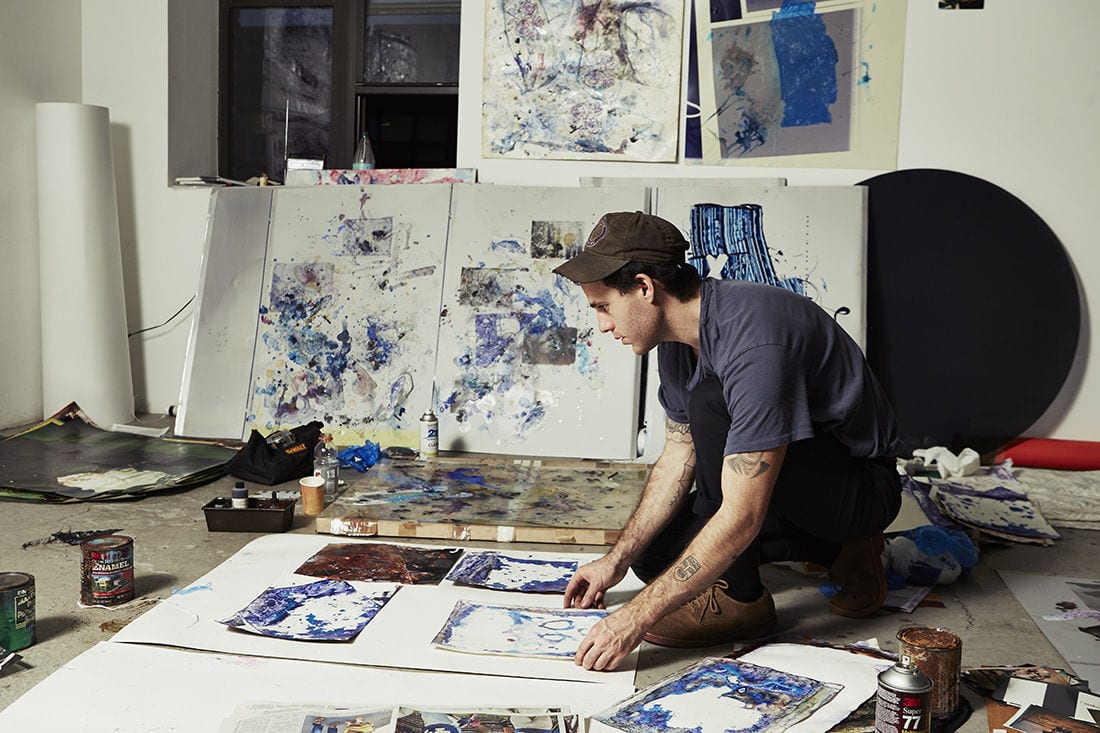
Communication is increasingly being reduced to 140 characters, emojis, and voice memos. Despite this, clear prose remains a powerful sales and branding tool within the art world, and beyond.
Artsy has created over 7,000 artist bios, and over the years we’ve learned a few things about what our audience of collectors and art lovers finds valuable when discovering new art. Since Artsy’s partners can now add their own artist bios, we decided to take this opportunity to invite Jessica Backus, Director of Artsy Marketplace, to share some insights into what makes for a compelling bio and how to eloquently summarize an artist’s practice in 120 words.
If you have—or are planning to include—artist biographies on your website, this article was written for you. Read on for our best practices, mistakes to avoid, and a few SEO tips for your gallery’s artist bios.

Detail from Brie Ruais’s studio by Alex John Beck for Artsy
Why write a bio.
An artist’s bio is often the first piece of information available to readers and collectors, and as such it offers you a chance to frame their practice and give collectors a reason to want to learn more. Bios also drive search engine optimization (SEO). When returning search results, Google and other search engines privilege written content that is “sticky” (i.e. readers spend time on the page and continue browsing), so providing an engaging, well-written bio is a great way to increase discoverability for your artists.
These are the three cornerstones—tried, tested, and used today by our writers at Artsy—of the perfect artist bio:
- The bio should summarize the artist’s practice—including medium(s), themes, techniques, and influences.
- The bio should open with a first line that encapsulates, as far as possible, what is most significant about the artist and his or her work, rather than opening with biographical tidbits, such as where the artist went to school, grew up, etc. For example: John Chamberlain is best known for his twisting sculptures made from scrap metal and banged up, discarded automobile parts and other industrial detritus.
- The profile should be between 80 and 140 words. The ideal bio is ~120 words, though a tightly written 80-word bio is preferable to a longer bio that includes repetition and filler sentences.
Why 120 Words?
Audience engagement researchers at museums have found that visitors lose interest in wall labels after 150 words. Our philosophy for artist bios is to leave your reader wanting more by limiting your word count to ~120 words. At most, a reader should take away one or two key points.
If you want to provide a more definitive overview of an artist’s practice, consider other channels, such as a press release or a blog post.
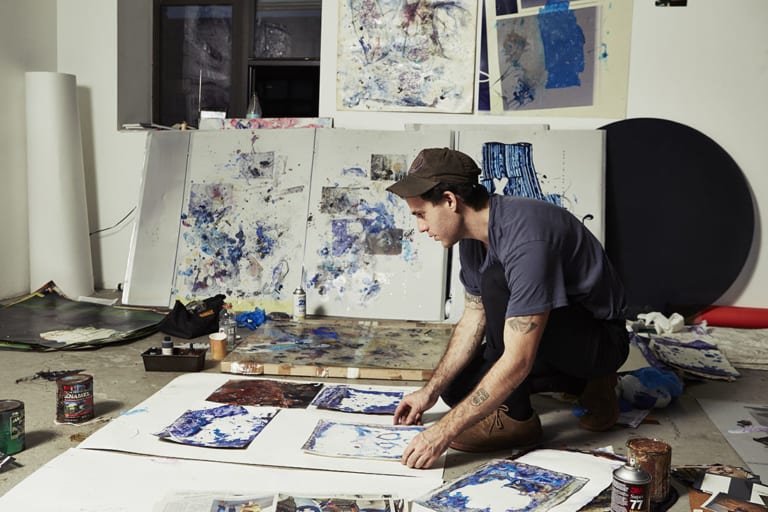
Portrait of Ryan Foerster by Alex John Beck for Artsy
Questions to consider when writing about an artist’s practice.
- What medium/media does the artist work in?
- What is his or her style like?
- What work or works can you talk about that will give a visual description of the above qualities?
Subject matter
- What are common or characteristic themes depicted in the artist’s work?
- What subjects drive the works or provide underlying themes?
Art-Historical
- Why is this artist important?
- What impact has this artist made on history, or what precedent has he or she set in art-making?
- What other artists have impacted the artist’s practice?
- How does this artist redefine a medium or media?
- Who are the artist’s peers or teachers?
- In what political or technological climate is the artist working in? I.e. what historical or political events might have influenced the work?
Popular Culture
- What areas of the arts or popular culture does this artist incorporate into his or her work?
- What other areas of the arts or popular culture does this artist engage with? E.g. creating theatrical sets, costumes, music videos, etc.
- Can any of the above questions be answered in a brief (1–2 sentences), engaging quotation from the artist?
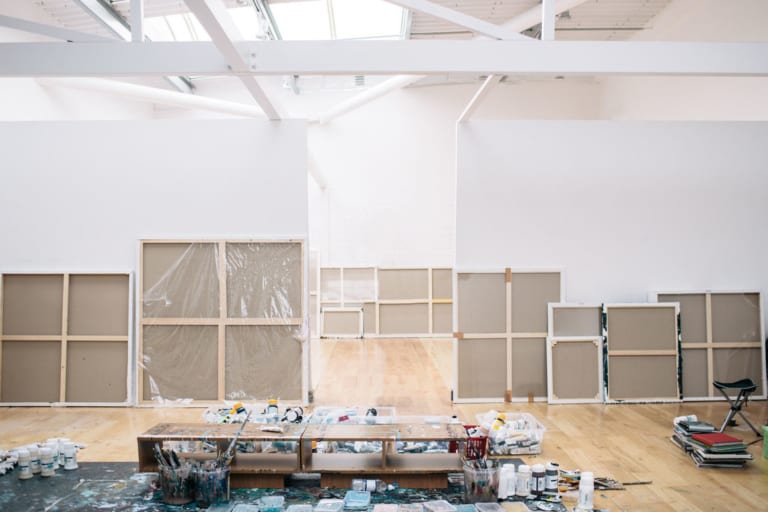
Detail from Genieve Figgis’s County Wicklow studio by Doreen Kilfeather for Artsy.
6 most common mistakes in artist bios, hyperbolic praise.
It can be tempting to sing your artists’ praises. We’ve noticed, however, that readers do not respond positively to unsubstantiated claims about an artist’s import (e.g. “Artist X is considered one of the most important artists of the post-war period,” or, “Artist Y is widely regarded for her beautiful work”). Most readers will see right through trumped-up language and, even worse, may become skeptical of the rest of your program. The best way to maximize the power of a good bio is to try to educate, not “hard-sell,” your reader. Numerous studies have shown that the hard sell doesn’t work, especially for younger audiences (read: tech-savvy collectors), who respond most positively to simple and authentic messages.
The “laundry list of accomplishments”
We recommend keeping exhibition highlights and accolades to a minimum (readers who are interested can refer to the artist’s CV). Impressive as these may be, these laundry lists are tedious to read in prose format. They also take up precious real estate, which you could otherwise devote to a real discussion of your artist’s practice.
There are certainly instances where it makes sense to include one particularly outstanding prize or exhibition, for example, an artist’s inclusion in the Venice Biennale. In this case, try to find a way to naturally include mention of the distinction in the normal flow of the text.
Misplaced academic jargon and pseudo-theoretical writing are almost universally despised. Instead of trying to impress other curators, academics, and galleries, focus on your audience of new collectors who may be completely unfamiliar with your artists. Readers want to glean information from your writing, and the best way to do that is to use simple language. A good rule of thumb is to impart one idea per sentence.
Spelling and Punctuation
Nothing undermines the credibility of your content more quickly than spelling and grammar mistakes. When writing, some best practices are:
- Use a serif font (e.g. Times New Roman) to ensure proper formatting of “smart” or curly quotes
- Make sure you have the spell check function turned on, and that your language preferences are set to English
- Have at least one other person, if not two, read over your text
- Don’t forget to put exhibition titles in quotations (e.g. “Greater New York”), and artwork titles in italics (e.g. La Vie, 1903)
Duplicating (or omitting) artist’s nationality, birth year, and death year
It is a common convention in most art writing to include an artist’s nationality, birth year, and death year upon first mention (for example, Alexander Calder [American, 1898–1976]). However, many online databases (including Artsy) store these facts as metadata fields that accompany the artist’s name (see above). Understand how your bio will appear and omit (or include) this information accordingly so as to ensure consistent formatting and keep clutter to a minimum.
Letting bios get stale
For young artists with rapidly evolving careers, be sure to check back every year, or before new exhibitions, to re-assess what the most important aspects of your artist’s practice are.
Our Favorite Artist Bios
Historical artists.
Alexander Calder American artist Alexander Calder changed the course of modern art by developing an innovative method of sculpting, bending, and twisting wire to create three-dimensional “drawings in space.” Resonating with the Futurists and Constructivists, as well as the language of early nonobjective painting, Calder’s mobiles (a term coined by Marcel Duchamp in 1931 to describe his work) consist of abstract shapes made of industrial materials––often poetic and gracefully formed and at times boldly colored––that hang in an uncanny, perfect balance. His complex assemblage Cirque Calder (1926–31), which allowed for the artist’s manipulation of its various characters presented before an audience, predated Performance Art by some 40 years. Later in his career, Calder devoted himself to making outdoor monumental sculptures in bolted sheet steel that continue to grace public plazas in cities throughout the world.
John Chamberlain John Chamberlain is best known for his twisting sculptures made from scrap metal and banged up, discarded automobile parts and other industrial detritus. “My work has nothing to do with car wrecks,“ he has said. “I believe common materials are the best materials.” With its emphasis on paint finishes and the raw materials’ lines and seams, his work has been described as a kind of three-dimensional Abstract Expressionist painting. While his breakthrough work dates from the 1960s (namely in sculpture), he has also more recently worked with large-scale photography.
Become a Gallery Partner
Growing your art business following online with Artsy
Similar Resources

12 Online Art Terms to Know
As more and more collectors and galleries come online to take advantage of this growing market, a new vocabulary…
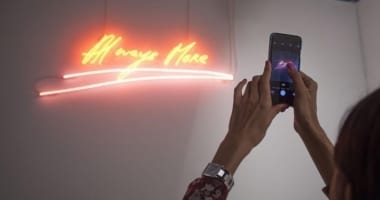
5 Ways to Tell Your Artists’ Stories Online
Our gallery relations team provides guidance on how to pick your shipping courier, how to package art, and a…
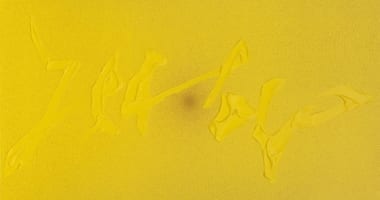
Digital Marketing Kit for Galleries
Over 10 strategies across 3 marketing channels, written by experts in digital marketing and the art world. Learn more…
RENEE PHILLIPS - MENTOR FOR ARTISTS
Helping Artists Achieve Their Fullest Potential

Writing Samples by Renee Phillips For Artists
On this page you’ll find samples of my writing that I have provided for artists. They are excerpts from longer Art Reviews. Visit this page to learn about my writing services for artists.
Sandy Iseli

Sandy Iseli, sandyiseli.com , creates resplendent paintings that convey her spiritual connection and reverence for the natural world. Having mastered creative skills with remarkable versatility, she illuminates the quintessence of all seasons with their intrinsic and diverse qualities and poetic splendor. Her ethereal spacious skies and open vistas release a palpable sense of quietude and symbolize infinite possibilities, freedom, and hope.
In creating her awe-inspiring paintings Sandy uses clear vibrant colors that depict our environment in its idealized, purist form, an artistic choice that also enhances them with a sense of the sublime. Gentle undulating hills that glow with soothing earthtones and fertile lush green pastures, multihued, rhythmic flowers in full bloom, and warm golden sunsets over crystal blue oceans are a few of the many spectacular images that delight our senses and transport us to states of bliss and serenity.
As an inspirational artist Sandy captures the miraculous beauty of nature and shares feelings of joy, tranquility, and solace. Her art has the power to provide healing energy to individual collectors as well as those in medical and recuperation facilities.
Steevie Jane Parks

Steevie Jane Parks, steeviejaneparks.com, creates awe-inspiring, multi-layered abstract paintings. She is highly proficient in applying the dynamics of color theory and integrates a range of hues with organic and curvilinear elements. Her art combines her many artistic skills with intuition and engages viewers visually and viscerally.
The artist’s background in Clinical Psychology contributes to her profound insight into the science of color and the healing potential it has on our minds and emotions.
Steevie deftly composes varying shapes and forms that evoke spontaneity and sensations of continuity, harmony, and infinite possibilities. She arouses feelings of interconnectedness through rhythmic undulations and circular motifs. Her use of overlapping spatial planes envelop both the microcosm and macrocosm. Tactile brushwork further increases depth and dimension.
Steevie’s vibrant painting “Creativity” awakens our inner spirit. Symbolic forms and contrasting colors emphasize dynamism and intensity. The mesmerizing glowing forms conjure visions of stained glass and kaleidoscopes.
Dr. Michael Durst

Dr. Michael Durst, HeartscapePaintings.com is an artistic messenger of elation, hope, and wellbeing. He combines his masterful skills in color with his proficiency for conveying his love for humanity, nature, and all living creatures. These admirable artistic and personal attributes lay the foundation for his visionary imagination to flourish. Michael’s capacity to express the healing power of art shines through his paintings.
As we enter Michael’s resplendent world of “Heartscape Paintings” we encounter a unique and diverse range of awe-inspiring subjects — from landscapes, wildlife, figures and portraits to abstractions. His dreamlike perspective and deft use of symbolism and metaphysical elements such as sacred geometry reveal a profound insight into the states of consciousness.
An extraordinary example is “Spiritual Awakening”, shown above. This transcendent painting is a quintessential expression of enlightenment. It was a pleasure to select it and feature it prominently in “The Healing Power of Resilience” and “The Healing Power of Color” juried exhibitions.
To learn about my writing services, how you can to apply, and fees visit this page.
Comments from a few of the many satisfied artists.
This is probably the greatest Art Review I ever received. To be seen with my art in the complexity, depth and breadth is just wonderful.” ~ Eva Breitfuss
“I am brought to tears by the in depth and profound way you have described my art. You’ve put into words what my heart has been trying to communicate.” ~ Akshita Lad
“You have seen the deepest part of my soul in my paintings.” ~ Sandy Iseli
“I was blown away by the extent to which Renée studied all there is to know about my work, by her grasp of my vision, and her extraordinary language and insight.” ~ Eleanor Gilpatrick
“You really depicted me as a real professional artist. I am so grateful for you, for writing this spectacular Artist’s Biography and Art Review and for being an inspiration and mentor to me.” ~ Beth Younger
“The art review you wrote is beyond perfect and I am so excited to use it in promoting my art. Your writing is a visual painting!”~ Bren Sibilsky
“Your words are very powerful and awe-inspiring. I appreciate your inputs for breaking the paragraphs down to be used for other specifics as well.” ~ Lee Tisch Bialczak
“Renée, Thank you. The quote is wonderful and I am sure it will have a positive effect.” ~ Amanda B.
“Your ability to concisely, accurately and enthusiastically write about my art makes it a very important element in any marketing and promotional efforts” ~ Arthur Jacob
“ I am so happy that I met you and outsourcing this task has taken a weight off my shoulders. Thank you.” ~ Joanne Brown
Writing Services for Artists
My specialty is writing Art Reviews and Art Statements / "Praise Quotes" for artists to use for promotion... on their websites, social media profiles, exhibition catalogues, grant submissions, blog posts, press releases, artists’ books and more. My writing for artists has led to increasing their art sales, attracting publicity, gaining … More...
Copyright © 2014 -2024 Renee Phillips Manhattan Arts International 200 East 72 Street, New York, NY 10021 [email protected]

IMAGES
VIDEO
COMMENTS
Example 2: The Fine Art Photographer. Tim Lee - Capturing the Urban Jungle Through My Lens. I'm Tim Lee, a budding fine art photographer rooted in the vibrant city of Chicago. I've taken some killer online courses and even had my work grace the walls of a local café.
Great example of a short artist biography . A short bio is a good idea for any artist whether you want to present your skills for a solo exhibition for fine art or just for a social media platform such as for an Instagram profile. Rita Ackermann Biography. Born: Budapest, Hungary, 1968. Education:
It's worth noting things like this in your biography so that other artists can understand where the source of your creativity comes from as an artist. (Image Source) Step 5. List Your Artistic Achievements. Next up, it's finally time to talk about your achievements.
How to write an artist bio with examples
How to Write an Artist Biography: 6 Tips for Crafting Artist Bios. Written by MasterClass. Last updated: Jun 7, 2021 • 3 min read. An artist biography provides background information on an artist's life and career.
Check out some successful artist bio samples online; a tried-and-true method is to use the first sentence to state the artist's name as well as their preferred medium or the style of their art. Remember, your artist profile is also a chance to improve the SEO ranking of your portfolio website. Consider the kinds of keywords that people who ...
Photo credit: Austin Distel on Unsplash. The Artist's Biography is text, written in the third person (she, he). It serves to provide the reader with a story about you as an artist and learn about your career credentials. It contains much of the same information as a résumé, however, a résumé or CV is written in a listing format and a ...
In other words, while your artist statement focuses on your art and medium, your artist bio is all about YOU as an artist. When you introduce your art in your artist statement, it's like saying, "Hey folks, check out my art!". But when it comes to your bio, you're basically saying: "Hey folks, here's a little bit about me!".
This section can be a powerful tool in attracting galleries, collectors, and art enthusiasts, offering tangible proof of your dedication and impact as an artist. 5. Adding Personal Touches: Incorporating Quotes in Your Bio. Incorporating a personal touch into your artist bio makes it more relatable and engaging.
An artist's biography is basically a brief paragraph that explains who you are as an artist, why you do what you do, and what you create. Artist's bios are almost always written in the third person and are usually around 150 words. Your bio can be placed on your website, in your portfolio or submitted with your work for an exhibition or show.
How to Write an Appealing Artist Biography
This is done by using words like her, she, they, him, his. It's a professional way of writing and is normally expected within the art industry. However, don't completely disregard the first person. It's applicable when writing your artist statement and when you don't require your artist bio to be so formal. If in doubt, check where your ...
Tips for Creating Artist Bios, with Artist Profile ...
1. Keep it short. Reading the above list, it sounds like a lot of information and that you might have to end up writing a full page for your biography, but that shouldn't be the case unless you are very far along in your career. For most artists, one paragraph or two should certainly suffice. 2.
Examples of great artist statements. My subject matter is nature, whether it is a traditional landscape or a bird and flower painting. I use traditional materials, ink and brush on rice paper, to capture movement and life - making the brush dance and the ink sing. Everything is captured in the spontaneous dance and movement of the brush as it ...
How To Write an Artist Bio (With Tips and Examples)
The Gallery's Guide to Writing Good Artist Bios
What Does an Artist Bio Include? A compelling artist bio typically covers the following key elements: Introduction: A snapshot of who you are as an artist—your name, medium, and the themes or ideas you explore in your work. Background: A brief overview of your education, training, and any pivotal experiences that have shaped your path as an ...
Engage Immediately. The first two sentences of your bio decide if potential buyers will continue until the end. So, it's crucial to engage them from the get-go. Start with a hook: Introduce a question or conflict that defines your artistic work. To get a basic idea, here are two rough examples:
It's important to make the most of your artist bios. If they're both well-written and used effectively they can also be a great tool for your digital marketing strategy. By Team ARTERNAL on Friday June 18, 2021. An effective artist bio is a great way to introduce and engage collectors in an artist's work. Unlike an artist statement or CV ...
Artist Biography Example: How to Convince in a ...
Short Artist Bio Examples 1. Visual Artist: Emily Carter. Emily Carter is a contemporary visual artist based in New York City. Her work explores the intersection of urban landscapes and human emotions, often incorporating mixed media techniques. Emily graduated with a Master of Fine Arts from the Rhode Island School of Design and has exhibited ...
What We Learned from Writing 7000 Artist Bios
His dreamlike perspective and deft use of symbolism and metaphysical elements such as sacred geometry reveal a profound insight into the states of consciousness. An extraordinary example is "Spiritual Awakening", shown above. This transcendent painting is a quintessential expression of enlightenment. It was a pleasure to select it and ...